Kansas Office of Broadband Development’s goal is to ensure that no Kansan is left behind in the digital world. To achieve this goal, we must be data-driven to guide our implementation plan and assess progress, utilizing both quantitative metrics and lived experiences shared by our stakeholders.
This Digital Equity Strategic Plan outlines specific strategies and objectives to achieve its goals, including ensuring digital skills training, affordable service plans and broadband-ready devices are aligned as top priorities. This plan also emphasizes the transformative power of technology, which can positively impact various areas such as healthcare, education and civic engagement.
“If we are serious about competing in today’s global economy and recruiting the best talent to come to our state and keeping our children where they grew up, then we must do everything in our power to end the digital divide.”
— Governor Laura Kelly
“Broadband equity starts with access, but also includes adoption and application. [Kansas] is committed to providing capacity and resources to ensure everyone has the access and skills needed to benefit from digital technologies in their lives.”
— Lieutenant Governor and Secretary of Commerce David Toland
“Kansans use the internet to work, learn, keep in touch with family, grow a business, get health care, and more. While access to high-speed internet is a gateway to opportunity, that opportunity is not distributed equally in our state. I’m proud to have voted for this new federal funding from the bipartisan infrastructure law that will help every Kansan thrive in the digital age.”
— Rep. Sharice Davids (KS-03)
Ensuring every Kansan obtains access to reliable and affordable broadband service and the digital literacy skills necessary to live, learn, work, play, and compete equitably in an increasingly technology-driven society is a priority of the Kelly administration. In 2020, Governor Kelly established the Kansas Office of Broadband Development (KOBD), housed within the Kansas Department of Commerce, to lead the state’s broadband deployment, affordability, and digital equity efforts.
Kansas Office of Broadband Development (KOBD)
KOBD believes in taking a comprehensive approach to federal and state funding opportunities to close the digital divide, which has made Kansas a national leader in applying for and using a wide range of opportunities to benefit our residents. Kansas is poised to leverage the historic federal infrastructure investment made to ensure all Kansans have access to affordable broadband and the necessary devices, training, and technical support to participate in our digital economy.
KOBD has already secured significant funding to date:
• $15.5 million from the U.S. Treasury’s Capital Projects Fund-Digital Connectivity Technology (CPF-DCT). This was the first award in the nation made under this program by the Treasury Department.
• $42.5 million from the National Telecommunications and Information Administration’s (NTIA) Enabling Middle Mile Broadband Infrastructure Program (EMMBI) in collaboration with the Kansas Department of Transportation (KDOT).
• $83 million from the Capital Projects Fund (CPF) for infrastructure projects.
• $451.7 million to support universal broadband service through the Broadband Equity, Access, and Deployment (BEAD) program.
These funds will support a wide range of programs, including support for community anchor institutions (CAI), internet-enabled devices for unserved and underserved Kansans, a 682-mile open-access, middle-mile fiber optic network, along with fast and reliable internet service to nearly 30,000 homes, businesses, schools, healthcare facilities, and other public institutions. In support of the universal broadband coverage goal, KOBD ensures all Kansans have access to the training affordable devices, and technical skills needed to fully participate in the digital economy.
Understanding Digital Equity in Kansas
According to the U.S. Census Bureau, statewide, over 153,000 Kansans lack subscriptions to high-speed internet due to infrastructure availability, affordability, or access to devices, digital literacy skills knowledge, and support. The connectivity gap is particularly noticeable within covered populations who have historically experienced lower rates of computer and internet use. Covered populations as defined by the National Telecommunications and Information Administration are:
Digital Equity – Definition: Digital equity is the condition in which all individuals have the information technology capacity needed to fully participate in society, democracy, and the economy (see other key digital equity terms defined in Appendix 1 – Glossary of Terms Used).
To better understand these digital equity gaps, KOBD conducted a statewide “Broadband Roadshow” in the spring of 2023. Staff traveled over 50,000 miles, presenting and leading discussions during more than 28 events. These meetings served as the initial introduction of KOBD to the residents, businesses, local officials, nonprofits, CAIs, and associations of Kansas, with a goal to meet Kansans “where they live.” This comprehensive and collaborative approach helped KOBD better identify the needs and barriers of those populations experiencing gaps in broadband adoption, affordability, device and technical support availability, and digital literacy skills and knowledge. These communities helped KOBD understand the impact digital equity issues have on economic opportunities, healthcare, education, workforce development, and civic engagement, helping shape KOBD’s digital equity vision and this digital equity plan.
Moreover, KOBD enlisted the expertise and support of the University of Kansas (KU) and Wichita State University (WSU) to help draw a clearer picture of the needs, assets, and opportunities for digital equity in Kansas.
The Goals and Vision for Digital Equity in Kansas
KOBD’s Digital Equity Advisory Council is a group of respected leaders who represent Kansans from all covered populations and every area of the state. The Advisory Council authored the vision for digital equity and this plan:

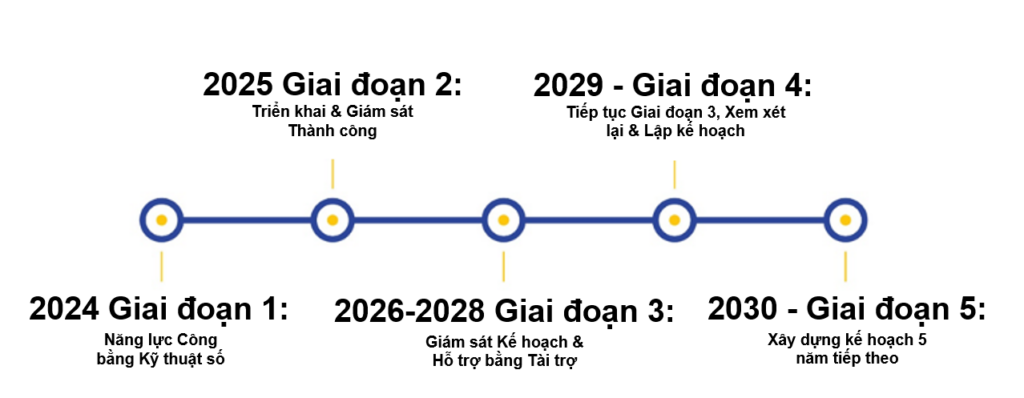
Lessons Learned
Financial Resources and Partnerships
In addition to the funding detailed earlier, KOBD has utilized and is pursuing specific funding (see 2.2.1) to address digital equity in Kansas. KOBD also recognizes the road to close the digital divide requires strong partnerships and financial resources. Partnerships with communities and organizations across the state are foundational to the role KOBD plays to unify, amplify, and expand the important work of those entities. KOBD’s investment in productive partnerships with all types of organizations and communities includes state agencies, municipalities, counties, Sovereign Tribal Nations, schools, foundations and other philanthropic entities, libraries, public-private partners, nonprofit organizations, labor unions, associations, and other non-traditional entities.
Common Themes
Consistent themes around digital equity KOBD heard in outreach efforts are that broadband access, affordability, knowledge, and support improve lives and communities. Participants shared stories about how equitable broadband access and adoption relieved isolation, provided a level playing field for employment searches, advanced education, attracted business, and opened telehealth opportunities. Demand for broadband is universal.
Even with the hurdles of connectivity issues, nearly 95% of WSU survey respondents reported working at least partially from home or relying on the internet for email, shopping, news and entertainment, healthcare appointments, or education.
The KU needs assessment identified barriers for members of covered populations. Individuals in low-income households tend to prioritize funds for other expenses beyond broadband, while those living in rural areas may not live near broadband infrastructure. For some Veterans, affordability and lack of awareness of the Affordable Connectivity Program (ACP) are clear obstacles to access. Individuals who are members of a racial or ethnic minority frequently face issues related to affordability or language barriers, while people with disabilities may find the cost of special technology to be a barrier.
KOBD and KU surveyed Kansas digital equity leaders and advocates to identify partners providing services that support digital equity work. Library access, job training programs, digital literacy skills training, accessing government benefits, providing technology equipment, and workforce development training were the identified activities where partnerships are needed.
Strategies and Objectives
This plan was built on key strategies and measurable objectives that will guide KOBD’s efforts to close the digital equity gap in Kansas.
Strategies
Objectives
Aligning Efforts to Improve Outcomes
As mentioned earlier, the creation and nurturing of partnerships is a key contributor to the success of digital equity efforts. Beyond merely establishing these relationships, KOBD will work to ensure collaboration and alignment among those partner plans and activities. To maximize the impact of the state’s digital equity efforts, KOBD must coordinate local, regional, and Sovereign Tribal Nation activities. Collaborative effort to plan and invest in reliable broadband access, affordability, skills, and support can increase reach and efficiency while reducing duplication of effort and competition for scarce resources. KOBD understands that the alignment of these efforts to increase workforce development, health access, educational attainment, and more is vital to secure digital equity for Kansas. Sections 3 through 5 of this plan provide more detailed information about potential partners and strategies for alignment.
The Digital Equity Plan – Development and Implementation
Development of the Plan
The timing of Governor Kelly’s foresight in calling for action on broadband access in Kansas and in creating KOBD aligned perfectly with the unprecedented BEAD and DEA funding opportunities created by Congress. The foundational work conducted by KOBD—the Roadshow, needs assessment, asset inventory, and partner conversations—has laid the foundation for Kansas’ digital equity vision, a set of strategies and objectives, and this plan to close the digital divide. It is thanks to the involvement of committed partners, Advisory Council Members, and Kansans from across the state that the plan to achieve true digital equity for all now exists.
Implementation
Kansas will continue implementation of this Digital Equity Plan. After the initial planning phase, the first implementation phase will commence in 2024 with continued work in broadband ready counties, convening of the Advisory Council, the building of the digital equity asset mapping tool, and applications for the next round of federal funding. The next three phases will involve the distribution of funds, implementation of plan activities, outreach to the philanthropic sector, and continued work on asset mapping. During the last phase, KOBD and its partners will begin planning to ensure sustainability of the initial Digital Equity Plan.
2023 – 2030 Digital Equity Plan Timeline

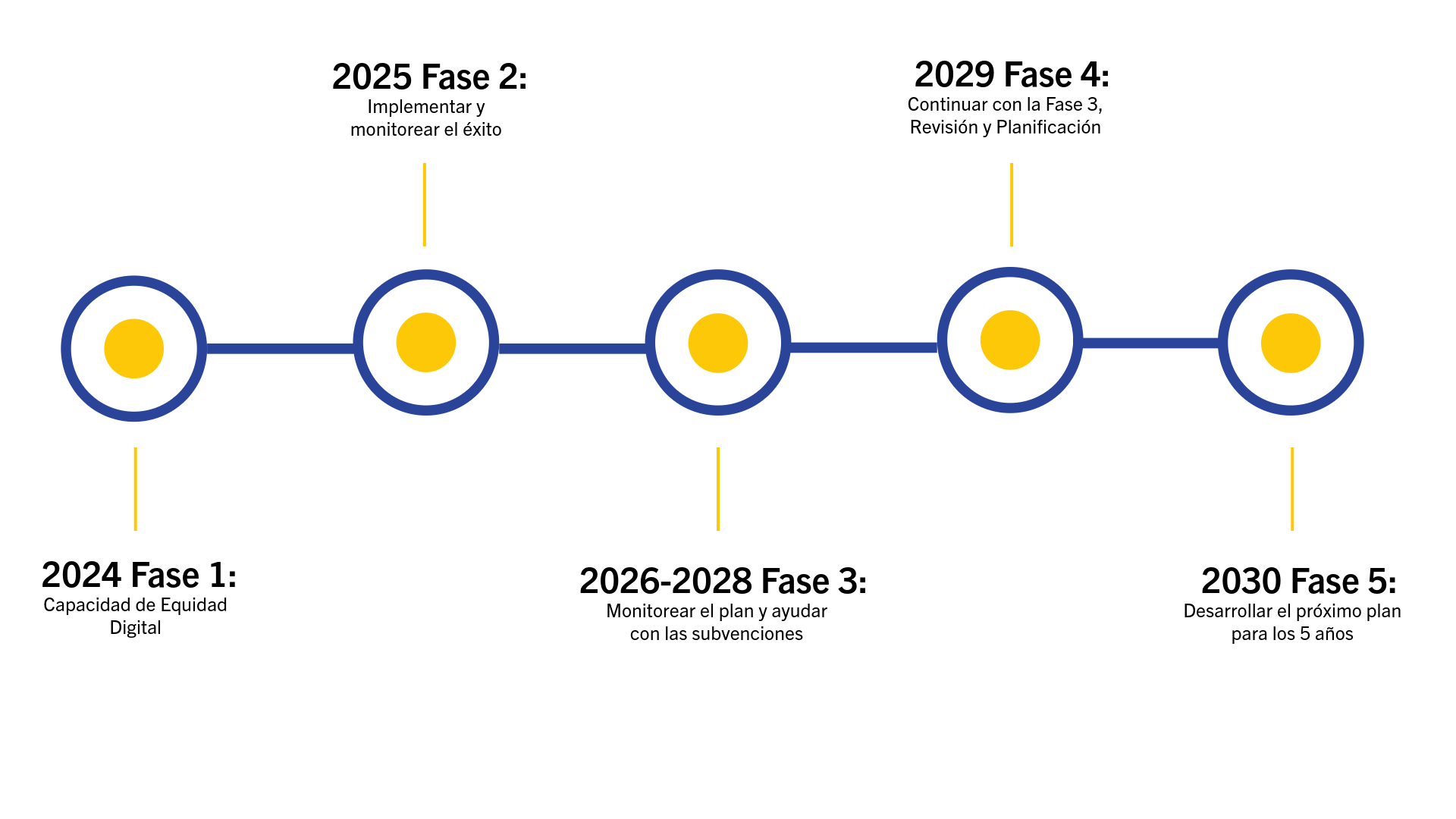

Measuring Success
While each of the objectives above is important, KOBD recognizes Kansas stakeholders require greater specificity and clarity. Therefore, each of these objectives contains refined Key Performance Indicators (KPIs) related to each covered population. These KPIs are derived from various sources for different populations where meaningful distinctions and specific data exist. Some measures apply across multiple populations as well. Those KPIs, along with baseline measurements, near-term targets, and long-term targets are in section 2.3.2 Objectives below.
In addition, KOBD recognizes that different regions of the state will feel objective’s impact differently and have different priorities. The key to effectively measuring success is working with regional and local leaders and advocates to identify the specific impact on each area and each covered population within that area. KOBD will support this work with statewide data tools and resources including sophisticated GIS mapping platforms.
Moving Forward
KOBD and its partners believe the success of this plan means greater success for Kansas and all its residents. Creating opportunities for access to the digital world for those who do not currently have it means creating opportunities for economic development, education, jobs, healthcare, and more. The Digital Equity Plan says to all Kansans that everyone has an equal right to access opportunity and thrive in our state.
We live in challenging times, but Kansans are born to meet challenges. Today, Kansas faces obstacles in health outcomes, education, employment, and civic engagement that impact different Kansans in unique ways. These obstacles have complicated roots and create many obstacles that can frustrate progress. However, technology and our digital reality can reshape problems to make and create the solutions of tomorrow, today. For example, healthcare enabled by telemedicine can improve health outcomes in every corner of the state. Education augmented by online and around-the-clock resources can help build the skills and knowledge base of every Kansan. In fact, technology is the key to unlocking progress in most sectors.
However, the digital divide stands in the way of that progress. To close that divide, every Kansan requires the information technology capacity needed for full participation in our society, democracy, and economy. Moreover, it is necessary for civic and cultural participation, employment, lifelong learning, and access to essential services. Digital inclusion is the work required to close the digital divide, beyond access and our state’s infrastructure needs. The National Digital Inclusion Alliance suggests the following DE-related definitions.1

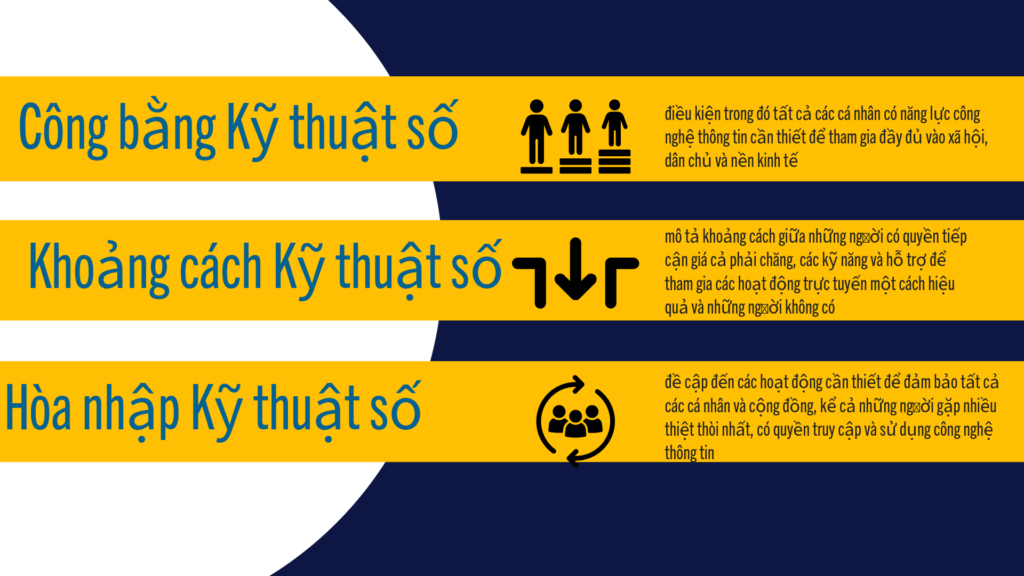
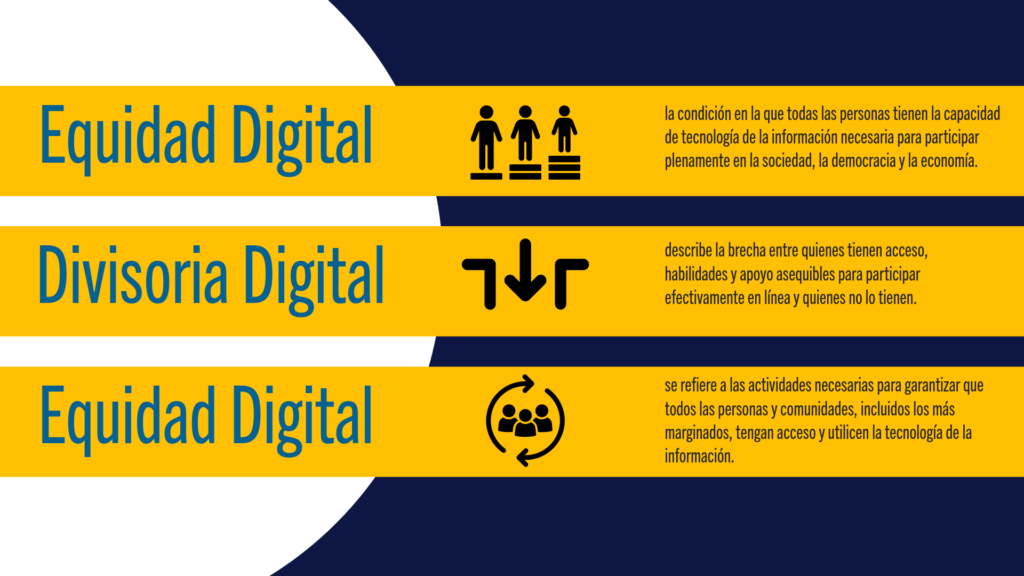
This digital equity plan, developed by Kansans for Kansas, outlines how our state intends to realize the goal of digital inclusion and close the digital divide. That achievement will make real impacts and improvements in employment, health, and beyond.
2.1 Vision
From its inception, KOBD partnered with leaders and community representatives to understand the lived experiences ofexperiences of Kansans, especially as they face barriers to accessing and adopting broadband services. During the height of the COVID pandemic, KOBD programs such as the Broadband Partnership Adoption Grant (BPAG)
program supported digital inclusion efforts. KOBD also formed the Digital Equity Advisory Council (Advisory Council) to represent Kansans from all covered populations from around the state. The Advisory Council, with membership intended to represent every covered population, plays a critical role in the digital inclusion and equity space. The expertise found on the Advisory Council, along with the invaluable assistance of KU and WSU, provides KOBD with perspective, research, successful models, and data. Beyond the numbers, however, these partners act as the primary resource guiding this work, and as an effective conduit to the lived experience of Kansans in their own words.
KOBD, along with the Advisory Council, defined the vision for digital equity, and set four high-level goals to measure our progress. The vision and goals are as follows:
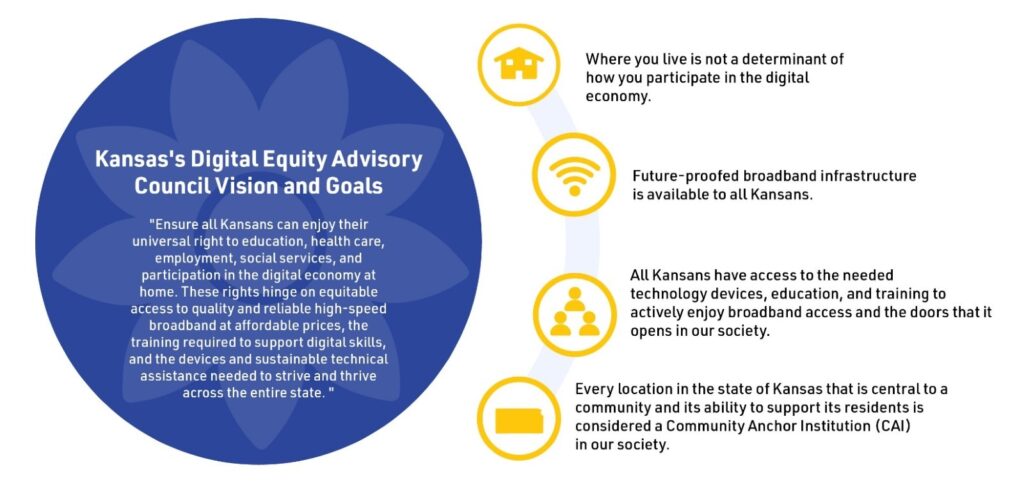
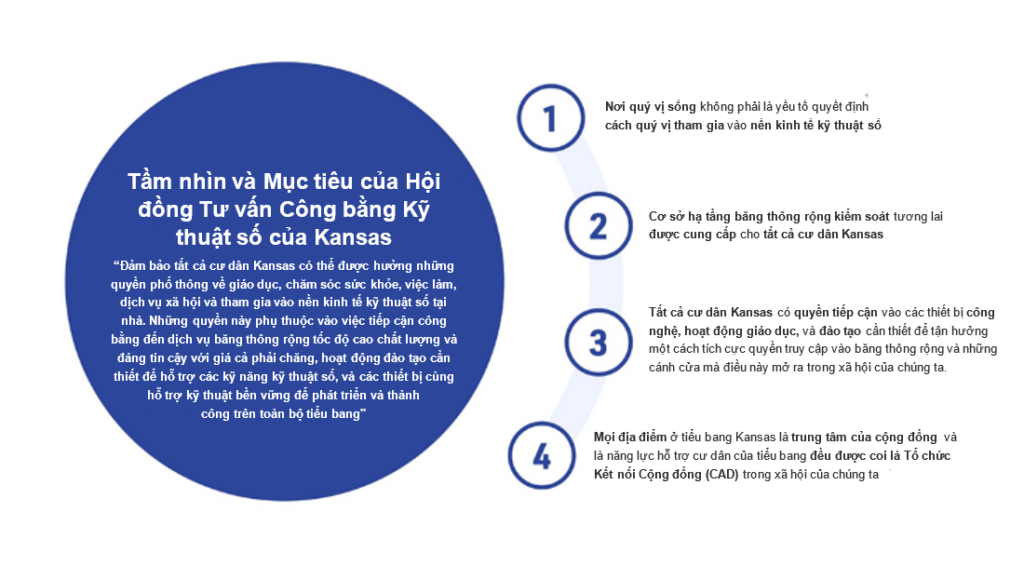
The vision laid out for digital equity will require the collaboration of the Advisory Council and various partners, thoughtful and effective planning, and responsiveness to change. Moreover, digital inclusion ensures all Kansans will have access to one of the most important tools for individual, economic, and community success: the internet.
2.2 Alignment with Existing Efforts to Improve Outcomes Aligning existing efforts to overcome the challenges of digital equity helps produce the best possible outcomes. KOBD will use existing funding opportunities and partnerships to maximize available resources to address the digital divide. To close the digital gap requires coordination among the many perspectives of Kansas. Thus, the plan must be collaborative, constant, and inclusive.
2.2.1 Funding Partners and Recipients
KOBD’s work of funding digital equity and broadband related efforts will continue through several funding streams. Programs to fund broadband deployment in unserved and underserved communities is essential to close the digital divide. Yet funding critical digital inclusion programs, like distribution of devices, digital navigators, and
outreach on affordability and adoption, is an appropriate concurrent step. KOBD will collaborate with funding partners and recipients to support the state’s digital equity efforts. Among the current and near-term sources of funding support are the following programs:
Table 1: Funding Partners and Recipients
| Source | Funding Source |
| Capital Project Fund Digital Connectivity Technology | Federal (Treasury) |
| In February 2023, Kansas was the first state to receive DCT funds ($15.5 million). The CPF-DCT program will support equal access to high-speed internet and provide devices to unserved and underserved Kansans. The program will be competitively allocated to eligible entities to bring free devices to income-qualifying households, free Wi-Fi to CAIs, and free Wi-Fi to low-income multi-dwelling units (MDU). | |
| Enabling Middle Mile Broadband Infrastructure | Federal (NTIA) |
| KOBD partnered with the Kansas Department of Transportation, the Kansas Research and Education Network (KanREN), and private providers, with input from the Kansas Department of Agriculture and the Kansas Division of Emergency Management, to submit a middle-mile application in September 2022. On June 16, 2023, KOBD and our partners were awarded $42.5 million. The awarded project plan is designed to create a 682-mile open-access, middle-mile fiber optic network to create connection to new internet exchange points throughout the state. Together with private and nonprofit partners, this open-access network will reduce the total cost of buildout to rural communities, which will enable and encourage lastmile providers to connect to this network and serve Kansas residents, farms, businesses, CAIs, and communities surrounding this network. Benefits of providing connectivity between local internet networks and to rural communities include increasing the capabilities of CAIs, enabling connections to unserved and underserved households, and increasing competition within local markets by creating more affordable service options. The 682-mile, middle-mile network passes through 28 counties: Allen, Anderson, Bourbon, Butler, Cherokee, Clark, Coffey, Crawford, Finney, Franklin, Greenwood, Haskell, Jackson, Johnson, Kingman, Labette, Linn, Lyon, Meade, Miami, Montgomery, Neosho, Osage, Pratt, Sedgwick, Seward, Wilson, and Wyandotte. | |
| Connectivity Emergency Response Grant (CERG) and Broadband Partnership Adoption Grant (BPAG) | Federal (Treasury) |
| In 2020, the Strengthening People and Revitalizing Kansas (SPARK) committee allocated $60 million in Coronavirus Relief Funding (CRF) to KOBD to increase connectivity in Kansas in response to needs precipitated by the COVID-19 pandemic that forced many to stay at home. As a result, KOBD launched two pandemic response programs: The Connectivity Emergency Response Grant program and the Broadband Partnership Adoption Grant (BPAG) program were created to drive immediate access and long-term impact. | |
| Broadband Acceleration Grant Program (BAG) | State (KDOT) |
| In 2020, KDOT, through its Eisenhower Legacy Transportation Program (IKE), partnered with KOBD to fund BAG. The program will invest $85 million over 10 years toward bridging the digital divide in Kansas. BAG will invest $5 million per year in grant awards for years one through three, and $10 million per year in grant awards for years four through BAG prioritizes access to unserved and underserved areas through the construction of broadband infrastructure across Kansas. Total investment, including matching funds, over the first two years exceeds $20 million and delivered broadband access to more than 5,700 locations. The third funding year process launched July 2023. | |
| Capital Project Fund (CPF) Program – ARPA | Federal (Treasury) |
| The CPF program provided funding to deploy broadband infrastructure that delivers 100/100 Mbps to unserved and critical areas of the state that lacked access. CPF is intended to address the following priorities: 1) broadband infrastructure deployment designed to directly enable work, education, and healthcare monitoring; 2) critical connectivity needs that resulted from or was made apparent or exacerbated by the COVID-19 public health emergency; and 3) a critical need of the community to be served. | |
| Lasting Infrastructure and Network Connectivity Program (LINC) | State/Federal (Kansas Department of Commerce / ARPA) |
| Kansas allocated $30 million in ARPA State Fiscal Recovery Funds (SFRF) to LINC for broadband infrastructure expansion. LINC is a multifaceted effort to improve broadband infrastructure, middle-mile connectivity, and Internet Exchange Point capabilities throughout Kansas. | |
| Affordable Connectivity Program (ACP) | Federal (FCC) |
| ACP is a federal affordability program for broadband subscription. For eligible households, ACP provides a discount of up to $30 per month toward internet service and up to $75 per month for households on qualifying Sovereign Tribal Nation lands. Eligible households can also receive a one-time discount of up to $100 for the purchase of a laptop, desktop computer, or tablet. KOBD partners with Education Superhighway to promote ACP. Education Superhighway provided training and resources to community partners, local governments, and ISPs. As a result, 69 organizations and four representatives have signed up to provide training on how to enroll interested households. As of March 2024, Kansas has 133,746 ACP subscribers in Kansas. | |
| Affordable Connectivity Outreach Grant Program | Federal (FCC) |
| The ACP Outreach Grant Program provides funding and resources to promote ACP and increase enrollment. Activities to promote ACP include a robust marketing and advertising campaign, social media, traditional media, flyers, infographics, standing banners, mailers, a video, and community education events in partnership with the FCC. Three organizations/municipal entities will be participating in this program, offering ACP outreach services throughout Kansas: KC Digital Drive (KCDD), Wichita State University (WSU), and the City of Topeka. The Roadshow revealed that ACP awareness among covered populations is low, demonstrating the importance of this outreach. | |
| Broadband Technical Assistance (BTA) Grant | Federal (USDA) |
| BTA provides funds to receive or provide broadband technical assistance and training, while also supporting the development and expansion of broadband cooperatives. On June 20, 2023, Kansas submitted a BTA application to provide broadband technical assistance to six of the most rural and economically distressed counties in the state. If received, the counties covered are Linn, Kiowa, Gove, Wilson, Kearny, and Rawlins. | |
| Digital Equity for Connecting Kansans (DECK) | Federal (ARPA/CPF- SLFRF) |
| Kansas allocated $5 Million to facilitate the development of digital literacy skills and adoption of broadband service in historically disconnected communities and programs with a goal to increase the rate of adoption in Kansas for the federal ACP. This program is currently under development with plans to launch in late 2023 or early 2024. | |
| Universal Service Fund (USF) Program for Schools and Libraries (E-rate) | Federal (FCC) |
| The E-rate program helps over 1,500 schools and over 370 libraries obtain affordable broadband service. The Erate program in Kansas is managed by the Kansas Corporation Commission, which distributed $30.6 million in FY 2022. | |
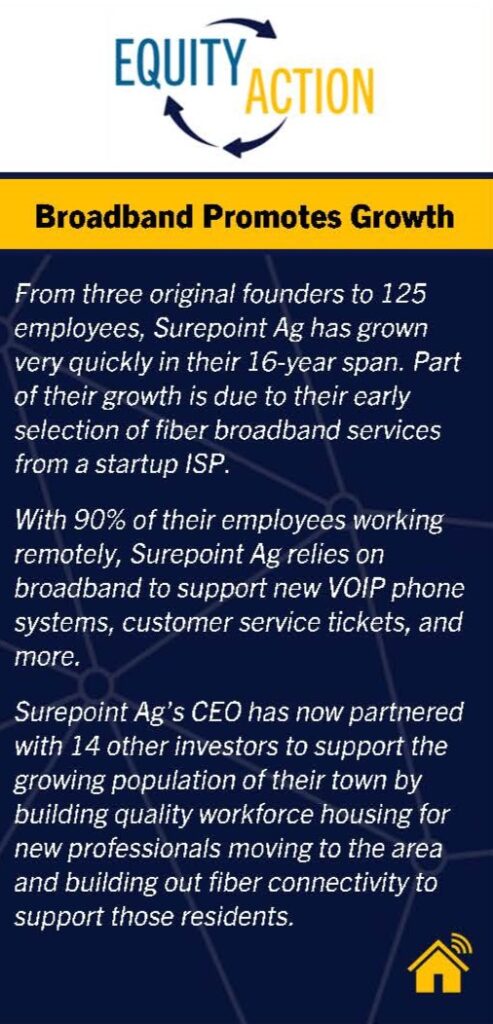
In addition to existing funding programs that support and enhance KOBD’s digital equity efforts, KOBD recognizes the critical role the private and nonprofit sectors will play in achieving digital equity goals. Facilitating sustainable, productive partnerships with all types of organizations from schools, foundations, libraries, and public-private
partners to labor unions, associations, and other non-traditional entities is a key function KOBD will perform.
2.2.2 Economic Development
In the state’s strategic economic development plan, the Kansas Framework for Growth (Framework), the state’s projected growth relies on four key areas: talent, innovation, community assets, and policy.[1] The success of every Kansan, collaboration with community assets, and the respect for regional interests align with the overall goals of KOBD’s broadband efforts.
The Framework’s initiatives and investments, particularly in the talent portion, dovetail nicely with our digital
inclusion efforts. Many of the elements of the “Potential and Future Initiatives and Investments” section mirror key workforce development initiatives by
KOBD that will support members of the covered population. Additionally, KOBD partners with the Department of Commerce (KDC), the Kansas Board of Regents’ community colleges and other higher education institutions, K-12, broadband providers, and industry partners to build workforce development programs. KOBD will focus on ensuring members of the covered populations are aware of opportunities such as scholarships, employer match participation, stipends for childcare and transportation, and others.
The Framework highlights the importance of community assets and critical organizations within our local communities. Often these organizations perform digital equity work in both rural communities and urban neighborhoods. KOBD supports local leaders and advocates who are actively addressing digital equity issues due to the importance of these organizations in the local ecosphere. The support presented by federal BEAD and DEA funding represents an opportunity for these organizations to scale their programs and combine forces with other practitioners to create a statewide, sustainable, selfreinforcing network of DE assets and resources.
Given the expansive agricultural footprint across Kansas, its role as a major economic driver for the state is obvious. Corn, wheat, and soybean wholesaling is the No. 2 economic impact category, with $17.6 billion in revenue. Meat, beef, and poultry is No. 7, with $8.9 billion in revenue. Combined, they surpass the top industry
of Kansas, aircraft engines and parts, which brought in $23.1 billion in revenue. Thus, it is critical for KOBD to 1 align digital Fequity efforts with the needs of the farming and ranching communities. This group is represented by the Kansas Farm Bureau (KFB), whose “Resolutions for 2023” states:
[W]e support every home, business and agricultural operation in Kansas having access to a highspeed communication infrastructure at a reasonable cost. We support a vibrant high-speed broadband network that delivers telemedicine applications, distance learning applications for K12, higher education and continuing education, emergency services, employment opportunities, and entrepreneurship endeavors, and gives broadband champions, community anchor institutions, and libraries the ability to provide interactive content for rural citizens.
This issue is critical to the agricultural sector in Kansas and is reflected in the national policy of the American Farm Bureau Federation. KOBD understands how the economic stability and growth offered by our agricultural sector are critical to the Kansas economy.
KOBD will need the assistance of workforce development experts across the state to meet its digital equity goals.
Alignment between KOBD’s digital equity objectives and these organizations is obvious. For example, the Workforce Alliance of South Central Kansas’ mission is to grow “the regional economy through a skilled workforce.” Their 2022 Strategic Plan focused on equity, inclusion, and diversity to increase awareness of workforce programs and services throughout south central Kansas, including Wichita, the largest city in the state.
The third strategic goal of the KANSASWORKS State Board’s 2021-2023 Strategic Plan aligns with KOBD’s broadband workforce needs by establishing coordinated workforce planning, investments, and operations, aligned to build relevant knowledge, skills, and abilities to meet industry needs in order to attract and retain people in our state.
[1] Kansas Department of Commerce. (February 2021). Kansas Framework for Growth. pp. 22-28.
2.2.3 Educational Outcomes

K-12, higher education, and workforce development programs deliver classes and coursework to students online. At a time when elementary and high school students participate in virtual schools and programs under the oversight of the Kansas State Department of Education (KSDE), efforts to improve the level of digital literacy and competency in all populations is critical. In many cases, K-12 institutions are the first resource addressing affordability for covered population members. As schools continue to expand hybrid and complete virtual learning through K12-Powered Learning, offering these personalized educational approaches require reliable, affordable broadband access and devices.3F4 With KSDE’s presence on the Digital Equity Advisory Board, KOBD will align its efforts with this important statewide resource.
Kansas Board of Regents (KBOR) oversees the state universities, community colleges, and technical colleges. These higher education institutions play a key role in KOBD’s work, from WSU’s digital equity survey and Roadshow efforts to Kansas State University’s (KSU) research and extension offerings in all 105 Kansas counties. In 2020, KBOR developed clear targets for individual and community success in their strategic plan named “Building a Future.” This plan highlights the economic prosperity of individuals by preparing students for career pathways that lead to a livable wage. It also calls out the deepening of partnerships with local and state leaders to understand the high-demand job opportunities to fulfill the needs of the business sector.4F5 As KOBD focuses on the growth of digital literacy skills, education partners like KBOR who are already invested in this work will play a significant role. KOBD will concentrate on these opportunities for members of the covered populations, especially for those careers that are adjacent to the needs of the rapidly expanding broadband field.
The Kansas Library Association (KLA) is a large provider of digital inclusion activities across the state. Libraries offer public access to computers, the internet, Wi-Fi, and printing. Furthermore, libraries offer digital training and workshops, as well as other online services and resources to community members, generally free of charge.
In their strategic plan, KLA’s top goal is to continue to address diversity, equity, and inclusion needs through local libraries and provide more services for community members with special needs. KOBD will coordinate efforts with KLA as they address this goal. As an immensely important anchor institution for so many communities, libraries are central to KOBD’s coordination and alignment efforts.
Another goal from the KLA’s strategic plan is bring continued technological enhancements to communities. Libraries are often the primary technology gateway for community members, which makes KOBD’s relationship and alignment with KLA and its member libraries a key part of KOBD’s strategy to leverage the work of existing partners to work efficiently and effectively.
The work of nonprofit organizations and informal education institutions, such as museums and after-school programs, provide an added opportunity to reach members of covered populations with information about digital equity resources and support. For example, the Kansas Health Foundation is in year two of a three-year plan where $1.1 million was awarded to support multi-sector community collaboratives that develop and advocate for policies, programs, and services. This plan promotes greater digital access, adoption, literacy, and inclusion among families of color, low-wage workers, and others experiencing systemic barriers. Awardees and their missions are as follows:
Another powerful example of a rich ecosystem encouraging education and collaboration is the KC STEM Alliance. Their vision is to create a vibrant ‘STEM-literate’ community that understands and uses science, technology, engineering, and math in meaningful ways to improve lives. STEM learning ecosystems shift the focus to the learner and where learning happens, like museums, libraries, afterschool programs, and at home.
2.2.4 Health Outcomes
Access to broadband resources is a cornerstone of health equity, better known as a social determinant of health (SDOH). SDOHs refer to the conditions and factors in which people are born, grow, live, work, and age that significantly influence their overall health and well-being.
The Kansas Department of Health and Environment’s (KDHE) 2021-2023 strategic plan identifies three priority areas impacted by broadband access.5F6
These goals align well with KOBD’s identified objectives to improve affordable access to devices and expansion of digital literacy skills training, which is crucial to the state’s ongoing digital equity work.
“Internet access is increasingly recognized as a “super determinant” of health. It plays a role in health care outcomes and influences more traditionally recognized social determinants of health, such as education, employment, and healthcare access.”6F7
Yosselin Turcios, M.P.H.,
Office of Behavioral Health Equity Fellow
KDHE also mentions their need for alignment with other state agencies, including the Department of Children and Families and Kansas Department of Aging and Disabilities.7F8 Efforts to align communication among state agencies reinforces KOBD’s strategy to work across multiple agencies to effectively serve our covered populations. With KDHE, DCF, and other state agencies participating in the Advisory Council and other ongoing efforts, KOBD is tightly aligned with their work.
In the Governor’s Commission on Racial Equity & Justice’s Social Determinants of Health-First Report (2021)8F9, recommendations to improve SDOHs specifically recommended legislative, policy, and state agency changes in early childhood and childcare, federal funding maximization, post-secondary education, maternal and child health, universal equity policies, housing and the unhoused, workforce, access to healthcare, and behavioral health—all of which are influenced by access to and adoption of broadband as a resource.
In Kansas, multiple funders lead investments to support health equity, including the Health Forward Foundation, REACH Healthcare Foundation, United Methodist Health Ministry Fund, Prime Health Foundation, Kansas Health Foundation (KHF), and others. Likewise, local and regional providers of telehealth services help level the playing field for rural populations, and KOBD will continue to recognize and support their efforts. For example, the Community Care Network of Kansas focuses on achieving equitable access to high-quality healthcare for all Kansans. Similarly, the United Methodist Health Ministry Fund supports research and advocacy for telehealth within Kansas.
Kansas Department of Aging and Disability Services (KDADS) serves the public by prioritizing the health and wellness of older Kansans and those with different ability levels. The Kansas State Plan on Aging says the mission of KDADS has “evolved to protect Kansans, promote recovery, and support self-sufficiency.” 9F10 Digital Equity efforts align with this plan closely, fitting perfectly with four out of the five stated goals:
KDADS is an important partner in coordinating state agency efforts and leveraging these existing programs for the good of their constituents. They will be partners in achieving multiple objectives in digital equity work, including increasing access to affordable broadband services, the growth of digital education and knowledge, and expanded access to devices with the importance of technical support.
2.2.5 Delivery of Other Essential Services
Poor broadband access often hampers emergency services for rural residents disproportionately and for members of additional covered populations who lack access to basic resources. The Adjutant General’s five-year departmental plan calls for better coordination and synchronization of emergency services. The plan’s goals focus on community readiness, supported by KOBD’s broadband and digital equity efforts.
As an example, Adjutant General’s Goal 3.4 to “[d]evelop and maintain Incident Management Support Capabilities” mandates better coordination of mutual-aid services. Thus, critical CAIs that conduct digital equity work and expand broadband directly enhance the capability of incident management teams across the state. KOBD’s efforts support Goal 3.5 as well, which focuses on “achieving timely two-way information flow and processing” and seeks identification of community resources and a stronger network of organizations to ensure prompt responses and resources that keep more individuals safe across our state.10F11
2.2.6 Cybersecurity
The Kansas Office of Information Technology Services (OITS) is currently writing its own Cybersecurity Plan related to the Infrastructure Investment and Jobs Act (IIJA). The State of Kansas is committed to the online security and privacy of an individual and their information. OITS will continue to enhance their cybersecurity posture as well as partner with local communities to bolster their cybersecurity and privacy protections. OITS is working with the university system to bring digital life skills curriculum to our various school districts to raise awareness for the next generation. OITS is also building partnerships with the various internet service providers to create common privacy objectives to ensure safe and secure access to critical and personal information.
2.2.7 Civic and Social Engagement
Important applications and processes are turning toward online portals. The Advisory Council stressed that many state and local government resources have moved online with fewer printed options. This is a barrier to those without reliable broadband access or devices who need to access important resources like applying for unemployment, paying taxes, receiving monthly benefits, registering to vote, requesting an absentee ballot, receiving important weather emergency updates, or communicating with local municipalities about local initiatives.
2.2.8 Municipal, Regional, and Sovereign Tribal Nations Digital Equity Plans
There is no one-size-fits-all approach to digital equity work. While every region and community share the common goal of digital equity and inclusion, local approaches will vary depending on local, cultural, and environmental factors. As Kansas communities begin to tackle their broadband accessibility, affordability, and adoption issues, many have already begun digital equity planning, including:
KOBD will continue its strategy of direct engagement with local communities, consultations with Sovereign Tribal Nations, and serving as a hub for digital equity planning and implementation. Through these partnerships, KOBD will collaborate with local planning teams to identify and support programs unique to those areas, while also sharing best practices from across the state.
TABLE 2: ALIGNMENT OF STATE AGENCY PLANS WITH OBJECTIVES
| Agency | Plan | Related Components | Aligned KOBD Objectives |
| Kansas Department of Commerce | Kansas Framework for Growth (2021) | Workforce skills; affordability options building on the success of current partners & programs | Availability Affordability Public Services |
| Kansas Department of Corrections | Kansas Department of Corrections Pathways to Success Action Plan 2022-2023 | Workforce skills; Devices | Digital Literacy Skills Devices |
| Kansas Board of Regents | Building a Future Strategic Plan (2020) | Community building; workforce skills; high-demand job opportunities | Availability Digital Literacy Skills |
| Kansas Science + Technology Plan (S&T) (2021) | Digital literacy skills; data access to enable research; rural broadband and business development | Availability Digital Literacy Skills Public Resources | |
| Kansas Office of Information Technology | Cybersecurity Plan in IIJA | Digital literacy skills | Cybersecurity Digital Literacy Skills |
| Kansas Department of Health and Environment | KDHE 2021-2023 strategic plan | Devices; digital literacy skills | Digital Literacy Skills Public Services |
| Kansas Department of Aging and Disabilities Services12F13 | State Plan on Aging 2022-2025 | Devices; digital literacy skills; connecting older adults | Availability Digital Literacy Skills Public Services Devices |
| Kansas Adjutant General’s Department13F14 | Strategic Plan 2019-2024 | Community building; readiness and emergency services | Availability Digital Literacy Skills |
2.3 Strategy and Objectives
KOBD recognizes intentional planning, collaboration, and evaluation are keys to achieving digital equity throughout Kansas. While informed by the vision, KOBD must ground its work in clearly defined achievement and in strategic action that yields the greatest impact for Kansas.
This plan addresses that reality by identifying key strategies designed to support the long-term development and impact of digital equity. These strategies drive tactical work toward measurable objectives. Measuring Key Performance Indicators (KPIs) will provide transparency and data-driven decision-making to ensure the plan adjusts appropriately to reality while remaining aligned to the vision.
Each strategy in this plan comprises multiple activities. Those tactical activities are presented in detail in section 5.1 of this document, along with a high-level implementation timeline in section 5.2.
2.3.1 Strategies
Deliberate strategies will focus our resources to achieve our goals. Thus, the five key strategies for KOBD are:

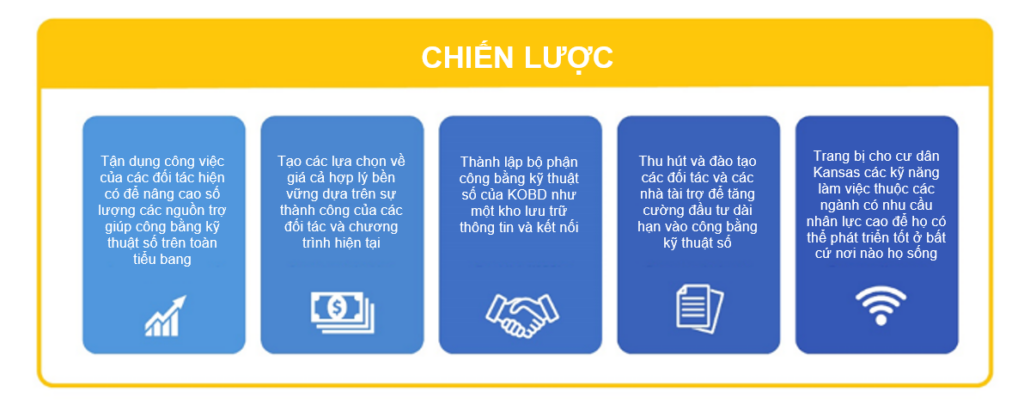
Expanded strategies are in Section 5 of this plan.
2.3.2 Objectives
To address Kansas’ digital equity concerns, KOBD set out key objectives for the Digital Equity Plan, which are:
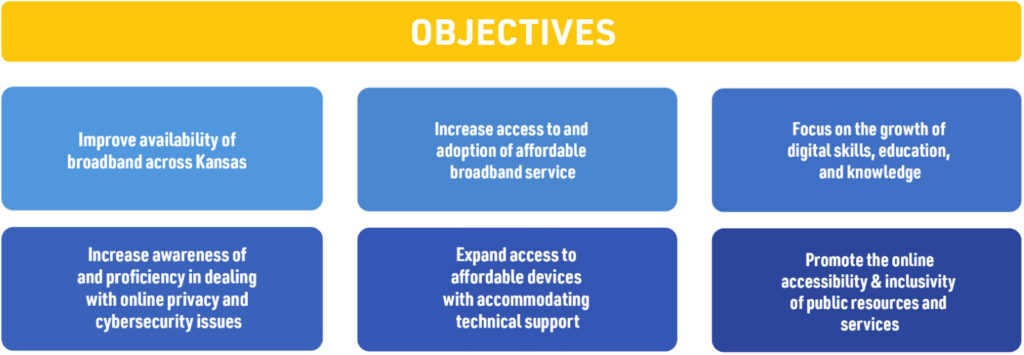
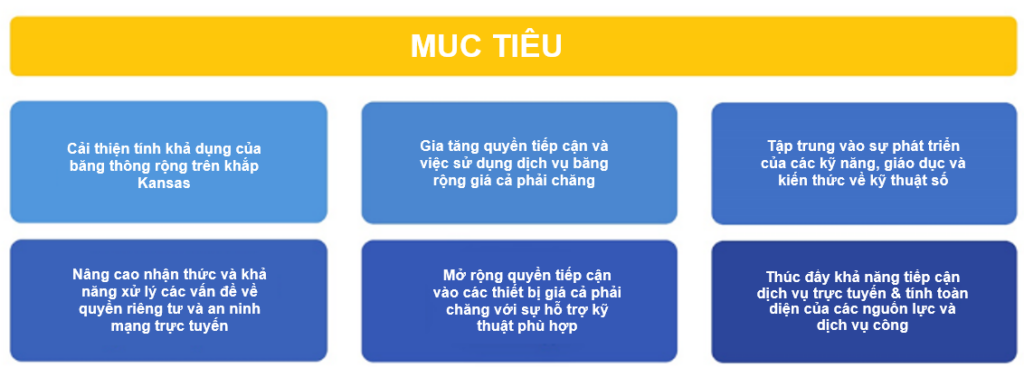
1. Availability: Improve availability of broadband across Kansas.
More than 70,000 Kansas households lack broadband access and over 50,000 additional households’ existing service options render them “underserved.” In addition, many of Kansas’ 8,500 CAIs lack gigabit-level broadband service that would better allow them to provide full levels of support to their communities. The Kansans impacted by these service gaps are disproportionately members of covered populations. While the primary purpose of BEAD funds is to expand broadband access, KOBD’s Digital Equity team must ensure the needs of covered populations are an integral part of BEAD planning, implementation, and follow-up. This approach will ensure all Kansans have broadband service and the accompanying tools, knowledge, service, and support to fully participate in today’s increasingly technology-drive society.
KOBD will use the percentage of members within each covered population who have adopted broadband service as a key measure for this objective.
2. Affordability: Increase access to and adoption of affordable broadband service
While ACP is a key factor in subsidizing the bills of eligible Kansans, the FCC has not guaranteed the program’s long-term funding. Kansas supports sustainable affordability options, which may be established by working with providers to encourage more options, continuing device and discount programs, supporting innovation, and identifying additional funding sources to incentivize affordability programs or supplement subsidy programs. KOBD will also foster partnerships and relationships to increase enrollment in ACP and other affordability programs by making them available, accessible, and inclusive to covered populations to maximize their effectiveness.
KOBD will measure success for this objective by enrollment in ACP or a subsequent affordability program by members of the covered populations.
3. Digital Literacy Skills: Focus on the growth of digital literacy skills, education, and knowledge.
Full participation in healthcare, education, civic engagement, and public services requires basic digital literacy skills. In addition, many employers require more advanced skills for job applications, remote working, and in-office roles. On-ramps into high-demand technology-driven jobs, including jobs supporting the expansion of broadband services, also require these skills. A highly skilled population is a factor for new employers who may bring new jobs and opportunities to Kansas.
KOBD will track digital literacy skills growth by continuing to collect data on the availability of basic digital literacy skills training (including cybersecurity essentials) available to covered population members.
4. Cybersecurity: Increase awareness of and proficiency in dealing with online privacy and cybersecurity issues.
Basic digital literacy skills must include essential cybersecurity topics like password management, fraud awareness, data privacy, and misleading advertising to fully prepare Kansans for online participation. Cybersecurity is a major barrier to adoption with stakeholder groups, particularly among the aging, the justice-involved, and those with language barriers. Cybersecurity issues also threaten the hard work and proprietary data of Kansas businesses, the state’s physical infrastructure, and the privacy and finances of individual Kansans. Necessary conditions for protecting our data include an increase in cybersecurity awareness among all populations, training programs across the state for vulnerable residents and covered populations, and a cybersecurity strategy coordinated with the Department of Commerce, OITS, and Kansas Information Security Office (KISO).
KOBD will utilize the same measure for cybersecurity as that proposed for “increase digital literacy skills, education, and knowledge” as it includes cybersecurity essentials as a critical component of basic digital literacy skills.
5. Devices: Expand access to affordable devices with accommodating technical support.
Broadband-enabled devices are in far greater supply than they were a decade ago, yet a gap persists among covered population members who may not have access to a computer, tablet, or a smartphone. Some CAIs offer publicly available devices, but proximity, transportation, and operating hours can limit their effectiveness. While Kansas features many innovative device distribution programs, these are unevenly distributed across geographies and populations, with fewer options in rural areas and heavier demand in urban areas. Awareness also remains low. A coordinated network of device distribution organizations is a major step to equitably dispersed broadband-enabled devices throughout the state.
The percentage of covered population members with access to broadband-enabled devices is the best measure for this objective. KOBD will note the availability of support for devices as the data and integrated systems are developed to support such tracking.
6. Public Services: Promote the online accessibility and inclusivity of public resources and services
Improving and expanding Kansans’ digital literacy skills through training and education programs is a key step, but the onus for skill development cannot rest solely on learners and educators. Agencies and organizations must meet our residents where they are when offering these digital upskilling services. Awareness campaigns, increased translation options, increased data portability, consideration for assistive technology, and accommodating technical support are tools to build digital literacy skills from the organization out.
KOBD will measure the availability of digital navigator services to members of covered populations for this objective.
Key Measures Considerations
The key to effectively measuring success is working with regional and local leaders to identify the specific impact of each objective and KPI on each area as well as each covered population. KOBD will support this work with statewide data tools and resources including GIS mapping platforms.
While each of the six objectives is important, KOBD recognizes Kansas stakeholders require greater specificity and clarity. Therefore, each of these objectives contains refined KPIs related to each covered population. These KPIs are derived from various sources for different populations where meaningful distinctions and specific data exist. Some measures apply across multiple populations as well.
Note that while some KPIs in this plan are aspirational, none have a long-term (2030) target of 100%, per the direction of NTIA staff. KOBD generally calculated long-term targets instead as 80% of the gap between the current baseline and 100%. This is not to say that 100% is not achievable, but that conservative estimates may be preferable during initial planning. KPIs and measures can and should be modified as needed when circumstances change, new data becomes available, or new guidance is provided.
Another important note is that this plan addresses barriers and needs for justice-involved individuals using the NTIA’s definition of the incarcerated covered population, “Incarcerated individuals, other than individuals who are incarcerated in a Federal correctional facility.” KOBD recognizes that the justice-involved population extends well beyond individuals housed in correctional facilities. As the Digital Equity Plan evolves, KOBD will explore expanding the definition of the covered population to include all justice-involved individuals.
Additional considerations for each of the plan objectives follow.
Availability
Improved infrastructure throughout Kansas will no doubt reduce the number of unserved and underserved households. This is a critical measure for KOBD’s BEAD planning. For the purposes of this plan, KOBD extends the success measure to the actual adoption of broadband. Access to high-speed services is a starting point, but statewide efforts to promote the benefits of broadband, strengthen device and support programs, build digital navigator capacity, and support affordability efforts are keys to the actual use of broadband and subsequent deliver of benefits to Kansans.
For most covered populations, KOBD will measure adoption of broadband as indicated by the US Census Bureau’s American Community Survey (ACS). In the case of justice-involved individuals—a population not identified by the ACS—KOBD will evaluate the availability of Gigabit-level service for each state facility housing this population. However, current reports indicate there are no facilities with this level of service. For rural Kansans, KOBD will measure adoption by BSLs, as rurality is not specified in the ACS.
Affordability
The most readily available data for tracking affordability is enrollment in ACP. This data is not available by covered population, so KOBD will use total population enrollment figures as a proxy for each covered population. The exception is for justice-involved individuals, for whom affordability is not relevant or measured while they are housed in a state facility.
The general measure also anticipates that ACP may not receive funding on a long-term basis, so KOBD is conducting outreach to explore existing or subsequent state or federal affordability programs.
Digital Literacy Skills
Digital literacy skills training is a continuous need even for digital veterans. It should be available ubiquitously to ensure no Kansan is left behind simply because they do not have access to learn, sustain, or improve the digital literacy skills necessary to remain current. While digital literacy skills training is widely available online, this assumes individuals have the connectivity and the base level skills required to access and benefit from it. It is KOBD’s position this training should be available in person to those who learn best in that manner, so training should be available within a reasonable commute or at least at the nearest CAI for extremely rural residents.
For these reasons, the proposed KPI for covered populations is a geographic measure of how far in-person digital literacy skills training programs are from every resident. As justice-involved individuals are generally unable to commute, the measure for this population is constrained to digital literacy skills training availability within those state facilities, reported by DOC to be 100% available.
As KOBD adds mapping data and layers, including a comprehensive statewide inventory of digital equity assets, the baseline for this measure will be available, as will the ability to track this measure over time.
Cybersecurity
KOBD’s position is that basic cybersecurity awareness is a required component of digital literacy skills. This includes personal digital security, identity protection, fraud awareness, and related topics. For this reason, the KPIs for this category mirror those of the digital literacy skills category.
Devices
The KPIs for this category are specific, relying on ACS data related to ownership of laptop or desktop computers as the measure for most populations. KOBD does not include tablets or smartphones in this measure because these mobile devices do not provide users with the full digital experience allowed by personal computing devices. It is significantly more challenging to, for example, develop a resumé in office software, interact with a fully featured website, or receive the full benefit from assistive web technology on a mobile device. Therefore, the measure KOBD has identified aspires to a future where these more robust broadband-ready devices are the expected norm for full participation in the digital world from the comfort of one’s home.
An exception here is the justice-involved population, for whom device ownership is irrelevant while housed in a state or federal facility and for whom devices and support are offered at a 100% rate, according to the DOC.
Public Services
KOBD’s research indicates that Kansas currently has no statewide initiative to ensure public services are available online or that they are supported by translation, technical support, and subject matter support for individuals who require it. The exception here is the OITS directive and federal statutes that require all state web properties be accessible to individuals with disabilities. KOBD will work with state agencies to develop a comprehensive inventory of Kansas public services and their online presence and support characteristics. The selected KPI, however, seeks to measure the availability of support for users of these services.
As is the case with broadband generally, access is a starting point, but adoption and support are required for full effectiveness.
As with digital literacy skills and cybersecurity KPIs, baseline and continuing measures for this category will be in place as additional data, mapping layers, and asset inventories are developed. As an alternative source of measurement, the statewide data survey may be used to evaluate availability of resources and confidence in the use of public services as self-assessed by members of each covered population.

Key Performance Indicators by Population
Table 3: Measurable Objectives, Persons In Low-income Households
| Availability | Affordability | Digital Literacy Skills | Cybersecurity | Devices | Public Services | |
| Definition | Percentage of covered population with broadband service according to the American Community Survey (ACS) | Percentage of eligible covered population members enrolled in ACP or subsequent programs | Percentage of covered population with basic digital literacy skills training (including basic cybersecurity skills) available within a 30-minute commute or at the nearest CAI | Percentage of covered population with a broadband-enabled device (laptop or desktop computer) according to the ACS | Percentage of covered population with support from digital navigators trained in the use of online public services available within a 30-minute commute or at the nearest CAI | |
| Baseline | 64.1% | 25.3% (total average) | TBD | 69.0% | TBD | |
| 2026 Target | 71.3% | 40.2% | TBD | 75.2% | TBD | |
| 2030 Target | 92.8% | 85.1% | 80.0% | 93.8% | 65.0% | |
Table 4: Measurable Objectives, Aging Individuals
| Availability | Affordability | Digital Literacy Skills | Cybersecurity | Devices | Public Services | |
| Definition | Percentage of covered population with broadband service according to the ACS survey | Percentage of eligible covered population members enrolled in ACP or subsequent programs | Percentage of covered population with basic digital literacy skills training (including basic cybersecurity skills) available within a 30-minute commute or at the nearest CAI | Percentage of covered population with a broadband-enabled device (laptop or desktop computer) according to the ACS survey | Percentage of covered population with support from digital navigators trained in the use of online public services available within a 30-minute commute or at the nearest CAI | |
| Baseline | 64.6% | 25.3% (total average) | TBD | 73.1% | TBD | |
| 2026 Target | 71.7% | 40.2% | TBD | 78.5% | TBD | |
| 2030 Target | 92.9% | 85.1% | 80.0% | 94.7% | 65.0% | |
Table 5: Measurable Objectives, Justice-Involved Individuals
| Availability | Affordability | Digital Literacy Skills | Cybersecurity | Devices | Public Services | |
| Definition | Percentage of facilities with Gigabit-level broadband service | N/A | Percentage of facilities with formal basic digital literacy skills training (including basic cybersecurity skills) available for residents | N/A | N/A | |
| Baseline | 0% | TBD | ||||
| 2026 Target | 50% | TBD | ||||
| 2030 Target | 87.5% | 80.0% | ||||
Table 6: Measurable Objectives, Veterans
| Availability | Affordability | Digital Literacy Skills | Cybersecurity | Devices | Public Services | |
| Definition | Percentage of covered population with broadband service according to the ACS survey | Percentage of eligible covered population members enrolled in ACP or subsequent programs | Percentage of covered population with basic digital literacy skills training (including basic cybersecurity skills) available within a 30-minute commute or at the nearest CAI | Percentage of covered population with a broadband-enabled device (laptop or desktop computer) according to the ACS survey | Percentage of covered population with support from digital navigators trained in the use of online public services available within a 30-minute commute or at the nearest CAI | |
| Baseline | 70.5% | 25.3% (total average) | TBD | 80.0% | TBD | |
| 2026 Target | 76.4% | 40.2% | TBD | 84.0% | TBD | |
| 2030 Target | 94.1% | 85.1% | 80.0% | 96.0% | 65.0% | |
Table 7: Measurable Objectives, Individuals with Disabilities
| Availability | Affordability | Digital Literacy Skills | Cybersecurity | Devices | Public Services | |
| Definition | Percentage of covered population with broadband service according to the ACS survey | Percentage of eligible covered population members enrolled in ACP or subsequent programs | Percentage of covered population with basic digital literacy skills training (including basic cybersecurity skills) available within a 30-minute commute or at the nearest CAI | Percentage of covered population with a broadband-enabled device (laptop or desktop computer) according to the ACS survey | Percentage of covered population with support from digital navigators trained in the use of online public services available within a 30-minute commute or at the nearest CAI | |
| Baseline | 59.8% | 25.3% (total average) | TBD | 67.2% | TBD | |
| 2026 Target | 67.8% | 40.2% | TBD | 73.8% | TBD | |
| 2030 Target | 92.0% | 85.1% | 80.0% | 93.4% | 65.0% | |
table 8: Measurable Objectives, Individuals with a Language Barrier
| Availability | Affordability | Digital Literacy Skills | Cybersecurity | Devices | Public Services | |
| Definition | Percentage of people with a broadband connection who speak English “not well” or “not at all” on the ACS survey | Percentage of eligible covered population members enrolled in ACP or subsequent programs | Percentage of covered population with basic digital literacy skills training (including basic cybersecurity skills) available within a 30-minute commute or at the nearest CAI | Percentage of covered population with a broadband-enabled device (laptop or desktop computer) according to the ACS survey | Percentage of covered population with support from digital navigators trained in the use of online public services available within a 30-minute commute or at the nearest CAI | |
| Baseline | 61.7% | 25.3% (total average) | TBD | 53.0% | TBD | |
| 2026 Target | 69.4% | 40.2% | TBD | 62.4% | TBD | |
| 2030 Target | 92.3% | 85.1% | 80.0% | 90.6% | 65.0% | |
table 9: Measurable Objectives, Members of a Racial or Ethnic Minority
| Availability | Affordability | Digital Literacy Skills | Cybersecurity | Devices | Public Services | |
| Definition | Percentage of covered population with broadband service according to the ACS survey | Percentage of eligible covered population members enrolled in ACP or subsequent programs | Percentage of covered population with basic digital literacy skills training (including basic cybersecurity skills) available within a 30-minute commute or at the nearest CAI | Percentage of covered population with a broadband-enabled device (laptop or desktop computer) according to the ACS survey | Percentage of covered population with support from digital navigators trained in the use of online public services available within a 30-minute commute or at the nearest CAI | |
| Baseline | 72.7% | 25.3% (total average) | TBD | 77.6% | TBD | |
| 2026 Target | 78.2% | 40.2% | TBD | 82.1% | TBD | |
| 2030 Target | 94.5% | 85.1% | 80.0% | 95.5% | 80.0% | |
table 10: Measurable Objectives, Rural Inhabitants
| Availability | Affordability | Digital Literacy Skills | Cybersecurity | Devices | Public Services | |
| Definition | Percentage of broadband serviceable locations (residential) with broadband service in areas defined as rural by NTIA | Percentage of eligible covered population members enrolled in ACP or subsequent programs | Percentage of covered population with basic digital literacy skills training (including basic cybersecurity skills) available within a 30-minute commute or at the nearest CAI | Percentage of covered population with a broadband-enabled device (laptop or desktop computer) | Percentage of covered population with support from digital navigators trained in the use of online public services available within a 30-minute commute or at the nearest CAI | |
| Baseline | TBD | 25.3% (total average) | TBD | TBD | TBD | |
| 2026 Target | TBD | 40.2% | TBD | TBD | TBD | |
| 2030 Target | 90.0% | 85.1% | 80.0% | 80.0% | 80.0% | |
Notes: These measures reflect available data and are not intended to prescribe specific actions. Initial measures will be refined as additional tools and data become available. KOBD is taking steps to develop measures for those items in a TBD or NA status.
3.1 Asset Inventory
Closing the digital equity gap requires asset-rich partnerships that will provide resources to help bridge the digital divide. This asset inventory provides information on the partners that support digital equity efforts throughout Kansas. In addition to the assets, plans, and programs below, Appendices 2 and 3 contain a comprehensive inventory of assets and programs in the state.
3.1.1 Statewide Digital Equity Assets
KOBD used a variety of avenues of information to accomplish this asset inventory. KOBD partnered with KU to survey Kansas digital equity leaders, based on the National Digital Inclusion Alliance’s (NDIA) asset map template (see Appendix 2 — Digital Equity Asset Inventory). The Advisory Council, with membership intended to represent every covered population, was an invaluable resource in that each member introduced more digital inclusion connections as our efforts progressed around the state. KOBD held dozens of conversations with state agencies to understand the state’s network of existing digital equity programs. The local leaders and advocates who attended the Roadshow provided significant additional information. These efforts and various other informal discussions highlighted the following statewide digital equity assets for Kansas:
Kansas Department of Commerce
In addition to the leadership and support provided to KOBD, the eight Economic Development Districts (EDD) and their staff are important partners in local and regional broadband outreach and planning. Raising awareness about BEAD-related activities while educating local leadership on the importance of engaging their digital equity partners will be critical. As the digital equity asset mapping progresses, the EDDs can help identify partners who might be providing digital inclusion support but not necessarily as a core objective.
Kansas Library Association and the local library system
More than 350 libraries across the state, along with the support of the KLA, emerge as a critical resource. Continually responding to the needs of their communities, libraries are important CAIs with a long tradition of making computer access available to those without connectivity at home, training those who need to build digital literacy skills, and providing technical and content support to those learning to navigate these resources.
Kansas Board of Regents
The KBOR administers “Accelerating Opportunity: Kansas” in 17 community and technical colleges as part of their WIOA commitment to the Department of Commerce. This program offers access to job training for individuals who qualify for WIOA benefits.14 [1] As part of their training and assessment of individuals in this program, Northstar, a digital literacy skills software that assesses individuals and their digital skill levels, is a tool worth exploring and expanding throughout the state.
Kansas State Department of Education and the local school districts.
KSDE responds to the education needs of our K-12 student population. For many families, KSDE and their schoolbased educational partners are a primary resource in answering any device or affordability question. During the COVID pandemic, assessing and addressing students’ broadband access became a critical focus of KSDE. Because the standard student curriculum includes literacy and skills development, schools are the central resource for career readiness. For instance, the state adopted Career Standards and Assessment Services (CSAS) to ensure students have access to career pathways that lead to meaningful employment with technology-centric jobs. Students may also participate in Career and Technical Student Organizations (CTSO) that allow learning beyond a classroom by giving students the opportunity to expand their knowledge, skills, and overall development, specifically for students enrolled in Career and Technical Education (CTE) courses.
Moreover, the Kansas Legislature established a curriculum requirement mandating that all high schools offer at least one computer science course, starting in the 2023-24 school year. The map below from KOBD’s geospatial mapping system details the rates at which high schools in each Kansas school district offer a foundational computer science class. Red indicates no schools in the district offer courses, with yellow and white indicating a higher proportion of schools offering the courses.
SECONDARY SCHOOL COMPUTER SCIENCE COURSES BY COUNTY
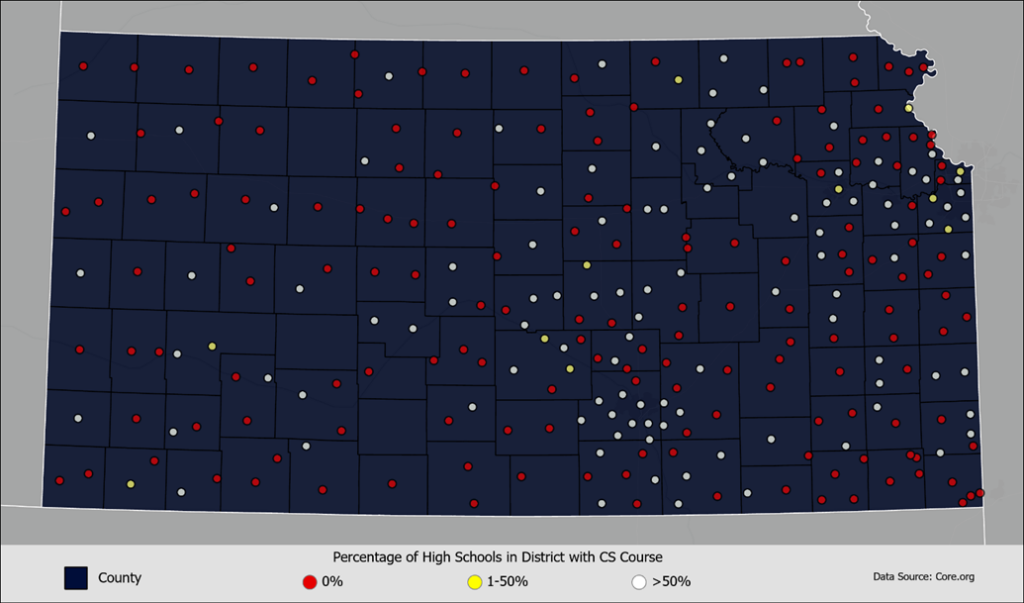
Kansas Health Funders and Kansas Association of Community Foundations
Kansas Health Foundation, Community Care Network of Kansas, Sunflower Foundation, Thrive Kansas, the United Methodist Health Ministry Fund, and Prime Health Foundation are some of the philanthropic partners who work to improve health outcomes, expand telehealth, and reduce inequity for individuals and organizations across the state.
Community foundations, supported by the Kansas Association of Community Foundations, work to address the growing need for digital equity in Kansas.
Kansas Farm Bureau
Acting as the voice of agriculture in the state, KFB is an important ally to advocate for broadband service in rural communities. KFB encouraged members to attend the Roadshow, participated in the Department of Agriculture’s survey, and has been a tireless resource on DE issues. KOBD will continue to work with KFB as efforts develop. Kansas Department for Children and Families
Kansas Department for Children and Families (DCF) is a primary resource for families seeking supportive services.
DCF helps families access Temporary Assistance for Needy Families (TANF), Supplemental Nutrition Assistance Program (SNAP), Medicaid, Low Income Home Energy Assistance Program (LIHEAP), and Workforce Innovation and Opportunity Act (WIOA) programs.15 [2] Enrollment in some of these programs qualifies residents for ACP, other affordability programs, and digital literacy skills trainings. Thus, continuous engagement with these organizations will be crucial to the state’s digital equity efforts, particularly with awareness and enrollment campaigns.
Collective Efforts by Dedicated State Departments
State departments and agencies serve the covered populations of Kansas. DCF, the Department of Aging and Disability Services, Department of Corrections (DOC), the Kansas Native American Affairs Office, the Kansas African American Affairs Commission, and the KDHE expand digital equity resources and address the digital equity needs of our communities, despite their varying missions and scopes.
Individual Programs Developed within Nonprofit, State, and Other Organizations
An existing network of services, organizations, and support for covered populations is starting to include digital equity offerings, while pointing to a need for improved coordination and support statewide.
Many digital inclusion activities like digital navigation, upskilling, and cybersecurity training were developed to address the needs of their service communities. For example, AARP offers programs to help members understand digital resources, cybercrime threats, and telehealth, while also learning new skills for employment opportunities.
Selected Assets and Programs in Support of Covered Populations
There are digital equity practitioners throughout Kansas who deliver vital services to their communities. Some organizations focus on specific covered populations. A sampling of those organizations is presented in the following pages. A more comprehensive list of organizations is in Appendix 3 — Existing Digital Equity Programs.
National Practitioners
In addition to the growing network of assets in Kansas, KOBD relies on and continues to learn from national digital equity organizations like NDIA. As previously noted, NDIA’s definitions and leadership provide a foundation for digital equity work.
| Individuals Who Live in Low-income Households |
| KC Digital Drive KC Digital Drive is a Kansas City nonprofit whose mission is to make Kansas City a digital leader and to improve the quality of life for all people in the region. | ||
| KC Goes Tech | Digital Equity Program and Digital Literacy Skills | Provides grants of $2,000 to partner organizations to support trainers who can deliver digital literacy skills education to the organization’s clients with no income requirements, support ACP and device programs, and to support the organization’s overall mission |
| Internet Access Support Program | Digital Equity Program and Broadband Affordability | Helps households at or below 200% of poverty level secure internet access and pay their internet bill through affordability plans while providing support for understanding internet service bills and cost-reduction ideas |
| Digital Equity Planning | Digital Equity Program | Provides support for digital equity planning efforts around Kansas City and the surrounding area, including Wyandotte, Miami, and Johnson Counties |
| Digital Inclusion Fund | Digital Equity Program, Digital Literacy Skills, and Broadband Affordability | Supports digital inclusion programs (access, skills, affordability, and adoption) to increase digital participation for the KC region’s most underserved and/or disconnected residents |
| City of Topeka and Shawnee County (TSC) – Get Digital Coalition The city of Topeka supports a coalition of community members and stakeholders who want to close the digital divide in Topeka. | ||
| TSC – Get Digital | Digital Equity Programs, Digital Literacy, Device Affordability | Provides affordable and equitable access to computer and internet equipment and services, along with technical support, training opportunities, and digital literacy skills services for low and moderate-income individuals, families, and aging individuals |
| Aging Individuals |
| American Association of Retired Persons (AARP) Available across the state of Kansas, AARP is the nation’s largest nonprofit, nonpartisan organization dedicated to empowering Americans 50 and older to choose how they live as they age. | ||
| BACKTOWORK50 | Digital Equity Program, Digital Literacy Skills | Provides resources, training (including computer-based skills training), and information for adults 50 and over who are getting back into the workforce |
| Older Adults Technology Services (OATS) | Digital Equity Program, Digital Literacy Skills | Delivers free online courses through partner organization, OATS, and through AARP’s Virtual Learning Center to help older adults learn digital skills such as how to use food delivery apps, social media, and podcasts |
| Fraud Watch Network | Digital Equity Program, Digital Literacy Skills | Offers a hotline and online resources to seniors on how to spot scams, use online resources safely, sign up for free peer support groups, and more |
| Kansas Area Agency on Aging The Area Agencies on Aging in Kansas are located around Kansas and are part of a national network of organizations designated as the leaders on aging issues at the local level. AAAs are the “boots-on-the-ground” organizations charged with helping vulnerable older adults live with independence and dignity in their homes and communities. | ||
| OKEP | Digital Equity Program, Digital Literacy Skills | The Older Kansans Employment Program serves the four trade areas of Manhattan, Junction City, Salina, and Emporia with employment-related services including digital literacy skills development for Kansans 55+ |
| Justice Involved |
| KU Center for Digital Inclusion The Center for Digital Inclusion facilitates scholarship, education, and collaborative partnerships aimed at enhancing citizens’ digital access and information literacy, especially among underserved populations. | ||
| The Technology Education Program | Digital Equity Program, Digital Literacy Skills | Offers digital skills training for justice-involved women transitioning back to society to give these women an opportunity to contribute to society and participate in the economy |
| American Prison Data Systems (APDS) APDS’ mission is to prepare every justice-involved individual for a living wage job through its career readiness platform. | ||
| APDS | Digital Equity Program, Device Affordability | Provides a virtual platform, tablets, and support for justice-involved individuals to offer career readiness education |
| Veterans |
| Veterans Affairs The U.S Department of Veterans Affairs is a nationwide resource that provides assistance to active military, service members with disabilities, and veterans. | ||
| Readiness and Employment (VR&E) | Digital Equity Program, Digital Literacy Skills | Offers services to help with job training, education, employment accommodations, resume development, and coaching for job seekers |
| Galvanize Galvanize transforms veterans, transitioning and active-duty service members into skilled software developers through technology training programs. | ||
| Coding Bootcamps for Veterans | Digital Equity Program, Digital Literacy Skills | Conducts a coding bootcamp through the Veteran Employment Through Technology Education Courses (VET TEC) program for full-time, high-tech training |
| Kansas Works Kansas Workforce Centers provide a number of employment resources and services for job seekers, employers, and veterans. | ||
| VETS | Digital Equity Program, Digital Literacy Skills | Offers a local Veterans Representative to assist in employment services, training and education, and referrals to other veteran services |
| Individuals with a Language Barrier |
| Catholic Charities of Northeast Kansas A ministry of the Archdiocese of Kansas City, KS, Catholic Charities offers a wide range of specialized programs, services, guidance, and resources that will result in long-term change. | ||
| Refugee Employment Services | Digital Equity Program, Digital Literacy Skills | Provides services designed to help connect refugees with jobs and train them to be strong employees |
| Refugee Learning Center | Digital Equity Program, Digital Literacy Skills | Offers essential education and life skills to refugees of all ages. |
| The International Rescue Committee (IRC) The IRC, located in Wichita, helps rebuild lives by working with government, organizations, and volunteers to help refugees, asylees, and survivors adapt their experience to their new communities. | ||
| Digital Navigators | Digital Equity Program, Digital Literacy Skills, Device Affordability, Broadband Affordability | Offers Digital Navigators to assist with ACP enrollment, digital literacy skills classes, and assistance with device purchasing and troubleshooting |
| Individuals With Disabilities |
| Cerebral Palsy Research Foundation (CPRF) This foundation helps those who have disabilities with a number of services and programs to ensure employment and daily task are achieved. | ||
| School of Adaptive Computer Training (SACT) | Digital Equity Program, Broadband Affordability | Offers in-person learning for adults and children with disabilities in Wichita or online for students located throughout Kansas covering basic employer-ready training skills |
| Goodwill Industries of Kansas Goodwill provides job training and education programs for people with disabilities and other barriers to employment through a wide range of programs. | ||
| LearnIT Digital Skills Classroom | Digital Equity Program, Broadband Affordability | Offers digital literacy skills training through virtual classrooms and training, including basic computer skills, computer support, programming, digital marketing, and cybersecurity |
| University of Kansas Assistive Technology for Kansans Assistive Technology for Kansans (ATK) is the Kansas statewide program providing tools needed to learn, work, play and participate in community life, safely and independently. | ||
| Assistive Technology for Kansans (ATK) | Digital Equity Program, Device Affordability | Connects people with disabilities to assistive technology |
| Individuals With a Language Barrier |
| Catholic Charities of Northeast Kansas A ministry of the Archdiocese of Kansas City, KS, Catholic Charities offers a wide range of specialized programs, services, guidance, and resources that will result in long-term change. | ||
| Refugee Employment Services | Digital Equity Program, Digital Literacy Skills | Provides services designed to help connect refugees with jobs and train them to be strong employees |
| Refugee Learning Center | Digital Equity Program, Broadband Affordability, Digital Literacy Skills | Offers essential education and life skills to refugees of all ages, as well as ACP support and digital literacy skills training |
| The International Rescue Committee (IRC) The IRC, located in Wichita, helps rebuild lives by working with government, organizations, and volunteers to help refugees, asylees, and survivors adapt their experience to their new communities. | ||
| Digital Navigators | Digital Equity Program, Broadband Affordability, Digital Literacy Skills, Device Affordability | Offers Digital Navigators to assist with ACP enrollment, digital literacy skills classes, and assistance with device purchasing and troubleshooting |
| Individuals Who are Members of a Racial or Ethnic Minority Group |
| Black or African American 5% | Kansas Population: 146,900 | ||
| IBSA IBSA is a Topeka based 501c3 that assists low- and moderate-income individuals with self-sufficiency programs and services. | |||
| Streets University | Digital Equity Program, Digital Literacy Skills | Partners with agencies to build the technological skills of young people, including the use of WordPress for website development | |
| Device Program | Digital Equity Program, Device Affordability | Sells low-cost devices such as desktops, laptops, and internet hotspots in partnership with PCs for People | |
| NAACP Kansas Chapter NAACP is a membership-based, volunteer advocacy organization committed to civil rights and social justice whose mission is to achieve equity, political rights, and social inclusion. | ||
| Empowerment Program | Digital Equity Program, Digital Literacy Skills | Advances the NAACP’s mission through high-impact programs and initiatives tackling complex challenges with community leaders and providing technical assistance to members |
| Multiple Programs | Digital Equity Program | Supports students’ education and skills development while advocating for African American entrepreneurs and workers and offering workshops and classes |
| Hispanic/Latino 12.7% | Kansas Population: 373,500 | ||
| El Centro Inc. El Centro Inc. supports and empowers the lives of Hispanic and Latino communities by education, health, and economic possibilities. | |||
| Enrichment Program | Digital Equity Program, Broadband Affordability | Provides after-school and summer educational opportunities from Pre-K through sixth grade, including technology training and ACP support | |
| Revolucion Educativa Revolucion Educativa builds sustained collective power for the Latinx community by coming together to provide tools, resources and supports needed to build sustained collective power in KC and beyond. | ||
| EducaTec | Digital Equity Program, Broadband Affordability, Device Affordability | Provides Spanish-language digital literacy skills training in partnership with Latinx Education Collaborative, along with child watch facilities and computers for participants without a device |
| Asian & Pacific Islander 3.1% | Kansas Population: 90,164 | ||
| National Association of Asian American Professionals – Kansas City Chapter NAAAP is a national organization advocating for leadership, education, accountability, and diversity for Asian American and Pacific Islanders. | |||
| Chapter Events | Digital Equity Program, Broadband Affordability | Holds events for members including workshops on leadership, professional development, and community outreach | |
| Wichita Indochinese Center (WIC) Originally founded in 1985 as a nonprofit corporation to assist refugees from the countries of Indochina, the Center serves people of all nationalities by assisting with the resettlement process. | ||
| Multiple Programs | Broadband Affordability, Digital Literacy Skills, Device Affordability | Offers employment specialists, on-site ESL classes for employers, digital skills development, testing, and a computer lab for students |
| Sovereign Tribal Nations 0.4% | Kansas Population: 11,800 | ||
| Iowa Tribe of Kansas and Nebraska The Iowa Tribe of Kansas and Nebraska provides the Adult Education Program to assist unemployed and/or underemployed members through services to support, literacy, basic education, job training, and continuing education. | |||
| Adult Education Program | Digital Equity Program, Digital Literacy Skills | Provides members literacy skills, assistance with training programs, and support services for continuing education | |
| Prairie Band Potawatomi Nation The Prairie Band Potawatomi Education Department strives to achieve an increase in leadership qualities through supporting all students in grades K-12. | ||
| Education Department | Digital Equity Program, Digital Literacy Skills | Provides financial assistance and employment support, including the enhancement of job and technical skills through training |
| Sac & Fox Nation of Missouri in Kansas and Nebraska The Sac & Fox nation provides a multitude of services to members, including education, housing, library services, and youth programs | ||
| Social Services/ICW | Digital Equity Program, Device Affordability | Provides computer access for job searches and staff assistance with resumes. |
| Kickapoo Tribe in Kansas The Kickapoo Tribe staff members manage operations including issues with environmental, health, road maintenance, compliance, financial, legal, gaming, and community planning. | ||
| Education Department | Digital Equity Program, Digital Literacy Skills | Aids members wanting to expand their education |


| Individuals Who Reside in a Rural Area |
| South Central Kansas Library System The mission of the South Central Kansas Library System is to assist member libraries to provide excellent service to their communities through grants, consulting, and continuing education. | ||
| Technology Consulting Services | Broadband Affordability, Digital Equity Program, Device Affordability | Provides support in the areas of automation, planning, policies, Internet, website development, digitization, basic computer and network troubleshooting, and electronic information services including e-readers, hardware, and software |
| K-State Research and Extension K-State Research and Extension provides statewide information and services related to adult development and aging, community development, and crop production. | ||
| Community Development | Digital Equity Program | Provides technical assistance and evidence-based programs and acts as an important partner in addressing broadband infrastructure support and digital equity efforts |
3.1.2 Existing Digital Equity Plans
As Kansas communities begin to tackle their broadband accessibility, affordability, and adoption issues, many will begin their digital equity planning efforts now. Some entities are already actively developing digital equity plans. Mid-America Regional Council (MARC) created a “Kansas City Regional Digital Equity Plan” for the Kansas City metropolitan area in 2023.[1] The City of Topeka began a two-year process of creating a digital equity plan with completion expected by 2024. KC Digital Drive is working with Wyandotte, Miami, and Johnson counties to develop Digital Equity plans, as well. The work is in process and represents some of the first digital equity planning efforts in Kansas.
KOBD has conducted formal consultations with all four Kansas Tribal Nations and continues to work with tribal representatives and relevant Kansas state government agencies including Governor Kelly’s office and the state tribal liaison. As the Tribal Nations begin to develop digital equity plans, KOBD will work with them in the manner each tribe finds most helpful. This unified effort will continue with Tribal Nations and will extend to DE plans throughout the state.
As other Kansas communities further their digital equity work and others begin their own processes, KOBD will work alongside them to provide the support, resources, and coordination needed for comprehensive and sustainable community digital equity plans.
3.1.3 Existing Digital Equity Programs
The following is a sampling of additional Kansas organizations throughout the state offering digital equity programs. A complete list of organizations is in Appendix 3 — Existing Digital Equity Programs.
| Kansas Digital Equity Programs |
| Angels in the Attic, Inc. Angels in the Attic, Kansas serves the Arkansas City community by networking with other area groups, business, churches, and organizations to better assist individuals who are struggling. | ||
| Computer Access Center | Broadband Affordability, Digital Equity Program | Provides technical assistance and evidence-based programs and acts as an important partner in addressing broadband infrastructure support and digital equity efforts |
| Groundwork Northeast Revitalization Group As a digital connector for their community, Groundwork Northeast Revitalization Group’s local mission is to revitalize Northeast Kansas and Kansas City communities through forward-looking, inclusive action | ||
| Technology Library | Broadband Affordability, Digital Equity Program | Provides a wi-fi hotspot and laptop lending library |
| Learn to Earn Program | Digital Equity Program | Provides a means for young people ages 12-16 in the northeast and east-midtown areas of Kansas City to receive environmental and conservation training, workforce development, and career preparation |
| Future Leaders Outreach Network (FLON) Future Leaders Outreach Network provides youth and young adults skills to set goals, become effective leaders, and pursue economic well-being by developing age-appropriate initiatives. | ||
| Educational Virtual Reality(E-VR) Technology | Digital Equity Program, Broadband Affordability, Digital Literacy Skills | Offers an E-VR headset program for students to complete a career exploration assessment or engage in real life career pathway immersive learning modules such as cybersecurity or robotics |
| Job Readiness & Career Exploration Simulation Trailer | Broadband Affordability, Digital Equity Program | Offers VR learning in technology and digital skills via hands-on learning in the 48-foot Leaders and Entrepreneurs Academy of Dreamers Initiative’s (YouLEAD) 48ft. Job Readiness & Career Exploration Simulation Trailer |
| Heartland Black Chamber of Commerce Heartland Black Chamber of Commerce is committed to developing and strengthening African American entrepreneur-led businesses in the State of Kansas. | ||
| Multiple Programs | Digital Equity Program | Provides support for launching, developing, promoting, sustaining, and growth of the African American community by advocating and lobbying on behalf of members by establishing programs and partnership opportunities including higher education scholarships |
| Human-I-T Human-I-T helps create equitable access to opportunity for Kansans by providing devices, internet access, digital skills training, and tech support for communities on the wrong side of the digital divide | ||
| Computer and Internet Training | Digital Equity Program, Digital Literacy Skills | Offers a 24/7 multi-lingual course on basic digital skills like operating a computer, using common programs like email, and navigating the internet, as well as offering orientation, office hours, and continuing education in cybersecurity, data analytics, and more |
| Tech Support | Digital Equity Program | Offers one year of free, on-demand tech support to everyone who has received a donated device or bought a low-cost computer or low-cost hotspot |
| Human-I-T Online Store | Device Affordability, Digital Equity Program | Offers low-cost devices like laptops and tablets |
| Internet Access Support Program | Broadband Affordability, Digital Equity Program, Device Affordability | Provides discounted Chromebooks and enrollment support for ACP participants |
| Kansas Department of Children and Families The Kansas Department for Children and Families, established in 1973 as an umbrella agency to oversee the delivery of social services and the provision of care to the vulnerable, today serves more than 500,000 Kansans. | ||
| Work Program | Digital Equity Program, Digital Literacy Skills, Device Affordability, Broadband Affordability | Offers a work program for families providing support for GED or ESL education and cash assistance, along with digital skills training, device procurement, and access to ACP |
| Accelerating Opportunity Kansas Career Pathway Program | Digital Equity Program, Digital Literacy Skills | Provides career training through nine technical and community colleges offering AO-K pathways like Computer Support Technology including digital literacy skills assessment and training via a partnership with Commerce and the Kansas Board of Regents |
| NCircle NCircle encircles families and individuals impacted by the criminal justice system by bringing together resources and offering certification opportunities and youth discovery programs. | ||
| Certification Training | Digital Equity Program, Digital Literacy Skills | In partnership with Johnson County Community College and College of Trades, NCircle offers a 12-week program that includes up to 75 hours of essential skills training and a trade certification, giving opportunity for adults at the Johnson County Adult Residential Center to learn essential professional, technical, and digital skills |
| Northeast Kansas Community Action Partnership Community Action programs throughout Kansas change lives by helping people help themselves and each other. This is an example of one of the Community Action Partners throughout the state serving members of the covered populations in their areas. | ||
| Digital Literacy & Work Skills Summer Class | Digital Equity Program, Digital Literacy Skills | Part of the Roadmap to Success Project classes will teach computer skills, online safety, and soft skills geared toward youth aged 16-19 completely free |
| PCs for People PCs for People is a national nonprofit social enterprise working throughout Kansas to get low-cost quality computers, internet, and digital skills into the homes of low-income individuals and families. | ||
| Learning Center | Digital Equity Program, Digital Literacy Skills | Provides free digital skills training through classes and workshops offered in-person or virtually, including essential computer skills, essential software skills, and technology tasks |
| Device Program | Digital Equity Program, Device Affordability | Offers eligible customers and nonprofits quality refurbished computers including desktops, laptops, and hotspots at a reduced rate |
| Affordable Repair | Digital Equity Program | Provides a one-year hardware warranty along with basic repair services starting at $25 |
| Smoky Hill Education Service Center Smoky Hill Education Service Center serves nonprofit organizations and more than 50 school districts in 25 counties of North Central Kansas to promote success for learners | ||
| Digital Citizenship and Technology Program | Digital Equity Program, Digital Literacy Skills | Offers a program for students, teachers, and community members focused on learning safety and vigilance related to scam awareness, spam, phishing, and predators |
| Learn360 | Digital Equity Program, Digital Literacy Skills | Provides an educational platform for students, teachers, and parents with a wide variety of educational content correlated to Kansas College and Career Ready Standards |
| Workforce Partnership (Johnson, Leavenworth, Wyandotte) Workforce Partnership is committed to a workforce development system that meets the needs of both job seekers and employers through a network of career centers, higher education institutions, and other quality training providers to deliver training courses in Johnson, Leavenworth, and Wyandotte counties. | ||
| JOCO KS Works 3.0 | Digital Equity Program, Digital Literacy Skills, Device Affordability, Broadband Affordability | Helps with job search, placement, and training including skills assessments, job search support, agency referrals, tuition assistance, GED and ESL support, textbooks, computers, and internet access |
| Skill Up WYCO | Digital Equity Program, Digital Literacy Skills | Offers classroom and on-the-job training with an emphasis on credential-bearing programs or those programs preparing individuals to earn a certificate, certifications, or pass a licensure exam, or that will provide upskilling for job seekers |
| United Food and Commercial Workers International Union (UFCW) The United Food and Commercial Workers International Union (UFCW) is a labor union and nonprofit organization (501c3) located in Dodge City, Kansas that believes in the power of ordinary people coming together to improve their lives and make a lasting difference for all working people. | ||
| Workforce Essential Courses | Digital Equity Program, Digital Literacy Skills | Offers basic courses like Computer Essentials to build union members’ expertise and increase their career options |
| University of Kansas Assistive Technology for Kansans The Kansas Telecommunications Access Program (TAP) is an equipment distribution program providing specialized telephones and other telecommunications devices to Kansans with disabilities who cannot use traditional home telephones. | ||
| Telecommunications Access Program (TAP) | Digital Equity Program, Device Affordability Program | Provides a free specialized device to support Kansas residents with disabilities that cause physical impairment |
3.1.4 Broadband Adoption Assets
This section provides information about available assets for broadband adoption within Kansas. In addition to the assets below, Appendices 2 and 3 contain a comprehensive inventory of assets and programs throughout the state.
3.1.4.1 Percentage of Residents Within Kansas Who Have Adopted Broadband
The U.S. Census data states 95.2% (1,103,327) of Kansas households have one or more types of computing device at home, while 78.8% (912,773) have a laptop or desktop as the device. At the same time, 25.5%
(300,261) of Kansas households do not have a fiber or similar broadband subscription.
Adoption relies on the availability of infrastructure. Thus, KOBD identified locations across the state where broadband is not available. Determining the synergies between locations without infrastructure access and where members of the covered populations reside will pinpoint clear opportunities to develop regional partnerships for digital equity and broadband adoption.
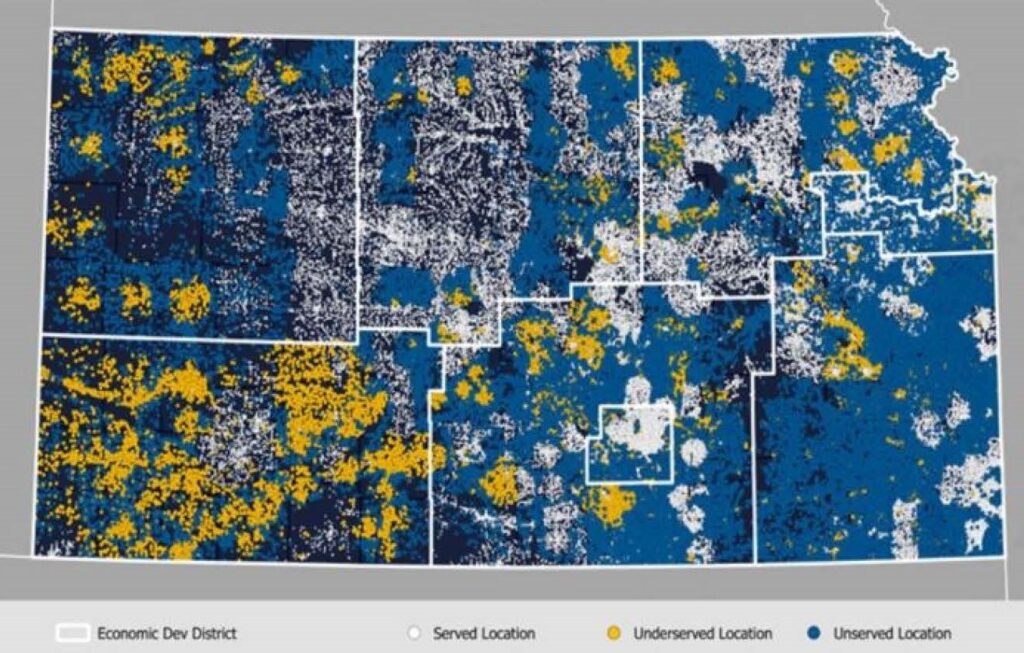
Served, Underserved, and Unserved Locations
3.1.4.2 Meaningful Use
Results of the WSU survey show Kansans use broadband access to stay informed, work (or find work), obtain home deliveries, pay bills, manage finances, arrange transportation, manage benefits or healthcare, learn, and find entertainment. The internet became many Kansans’ primary access point for work or school during the pandemic and remains critical to participate in all aspects of the digital economy.
WSU Survey Results: Meaningful Use of the Internet
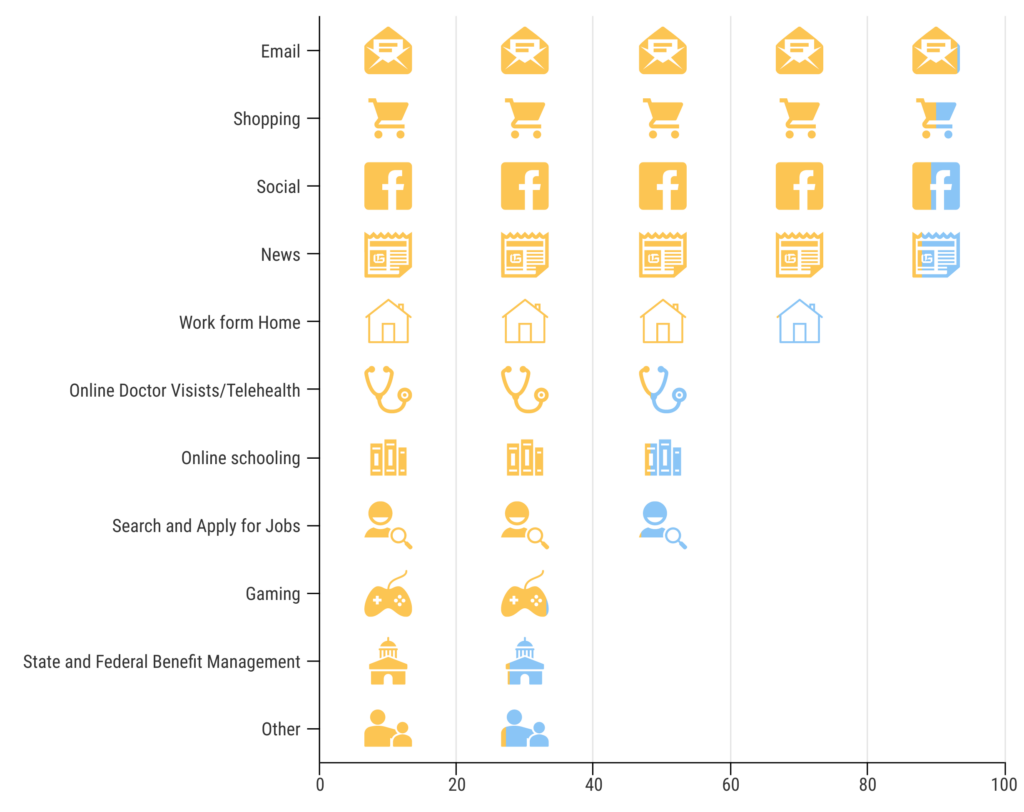
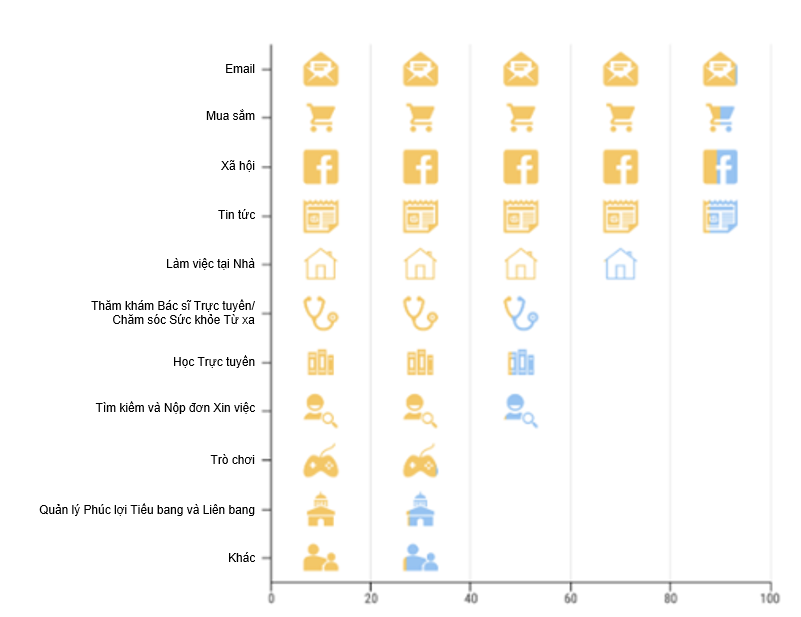
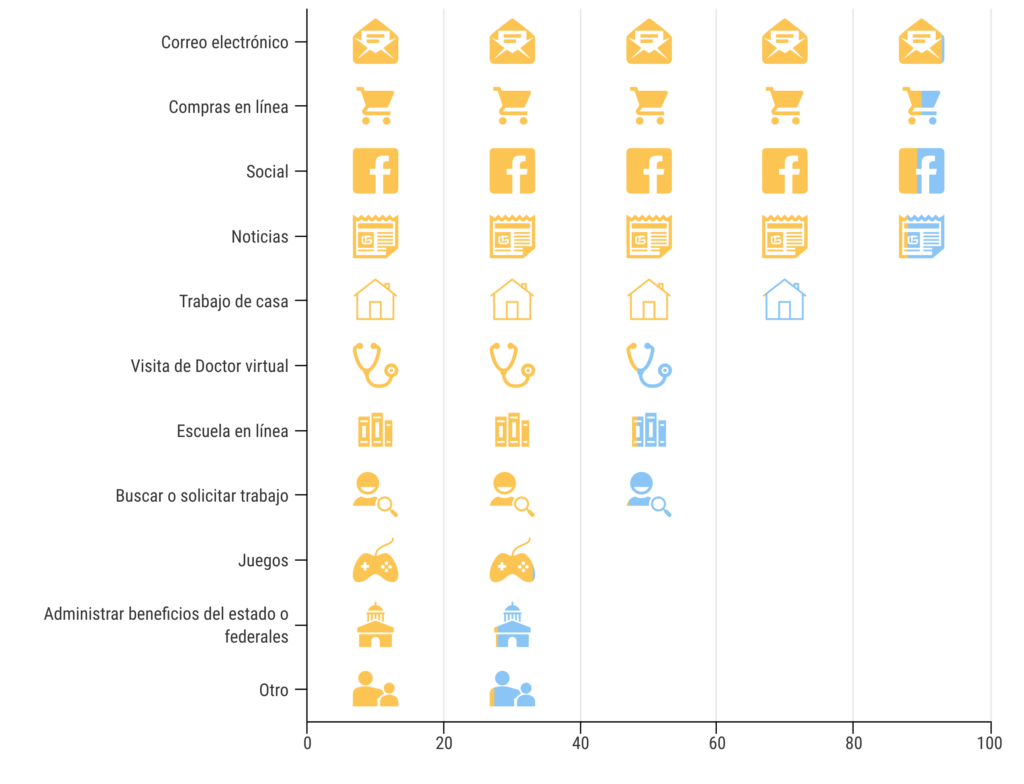
3.1.5 Broadband Affordability Assets
In addition to the assets below, Appendices 2 and 3 contain a comprehensive inventory of assets and programs throughout the state.
3.1.5.1 Affordable Connectivity Program
The ACP is the primary source for broadband subsidization. According to the March 2024 ACP report, March 133,746 enrolled households are in Kansas. This increase from 70,000 reported in the December 2022 report is the result of focused efforts by KOBD and nonprofit groups throughout the state. Still, the 133,746 households account for only 26.0% of total eligible households. While it’s a great start, there is much more work to do.
Kansas ACP Adoption Rates
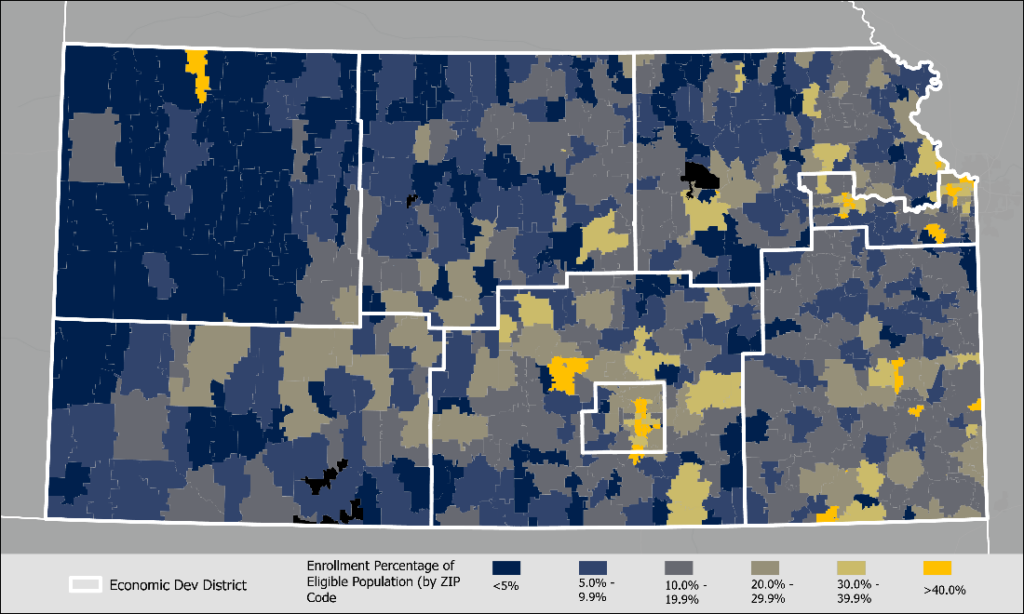
The data indicates several counties have more than doubled their ACP enrollment month-over-month for several recent quarters. Outreach to understand how these counties created programs and processes to increase ACP enrollment is under way, and KOBD will continue to work with ACP grant recipients to improve awareness.
Moreover, KOBD will map ACP adoption to monitor counties that are exhibiting growth in outreach efforts and identify the counties that may need additional support or resources to reach additional households eligible for ACP.
3.1.5.2 Kansas Lifeline
Kansas offers Lifeline to provide discounted phone service, residential or wireless. This state-managed program works with the FCC’s Lifeline Support for Affordable Communications, allowing participants to combine discounts with ACP (Lifeline participants automatically qualify for ACP) for up to $17.02 in monthly savings. Only 11% (29,675) of eligible households in Kansas participate in Lifeline.
3.1.5.3 Education Superhighway
KOBD partners with Education SuperHighway to provide awareness and increased enrollment in the ACP program. Education Superhighway created a dashboard to assist with the ACP application process and developed resources to train community partners, local governments, and Internet Service Providers (ISP). As a result of this partnership, more than 60 organizations and 90 designated representatives are training on how to sign up customers for this subsidy.
Education Superhighway Website

3.1.5.4 FCC ACP Outreach Program
Kansas is fortunate to have three grantees selected to the FCC ACP Outreach grant funding program:
KOBD will stay engaged as a partner to assist these organizations where possible.
3.1.5.5 ISP Support
TABLE 11: Providers That Accept ACP
Several ISPs accept ACP, including:
| Blackdragon Networks | Blue Valley Technologies | Cascade Communications |
| Clearwave Fiber | Consolidated Communications Enterprise Services | EARTHLINK |
| Frontier | Giant Communications | Google Fiber Kansas |
| H & B Communications | Kansas Wireless | KwiKom Communications |
| Lingo | Mercury Broadband | Mutual Telephone Company |
| Nex-Tech | North Central Kansas Community Network | Pioneer Communications |
| Rainbow Communications | S&T Communications | The Junction Internet |
| TOAST.net Internet Service | Twin Valley Communications | ValuNet Fiber |
| Velocity | Vyve Broadband | Zito West Holdings |
TABLE 12: Providers That Accept ACP and Have $0 Programs
Several ISPs offer plans, when coupled with ACP benefits, that cost consumers $0 per month, including:
| AT&T | Comcast Xfinity | Cox Communication |
| IdeaTek | Integrated Path Communications | Mediacom |
| Midcontinent Communications | Moundridge Telephone Company | Optimum |
| Spectrum Charter | T-Mobile | Twin Valley Communications |
| United Wireless Communications | Verizon | VOLT MOBILE |
| WTC |
TABLE 13: Providers That Offer Discounted Device Programs
Many ISPs offer discounted devices programs, including:
| Cathect Communications | Clear Wireless | Culture Wireless |
| Figgers Communication | Golden Belt Telephone Association | Human-I-T |
| Nextlink Internet | PCs for People | SWA Connect |
| Tone Communication Services | T-Mobile | Wisper ISP |
Population Whose Income in the Past 12 Months is Below the Federal Poverty Level
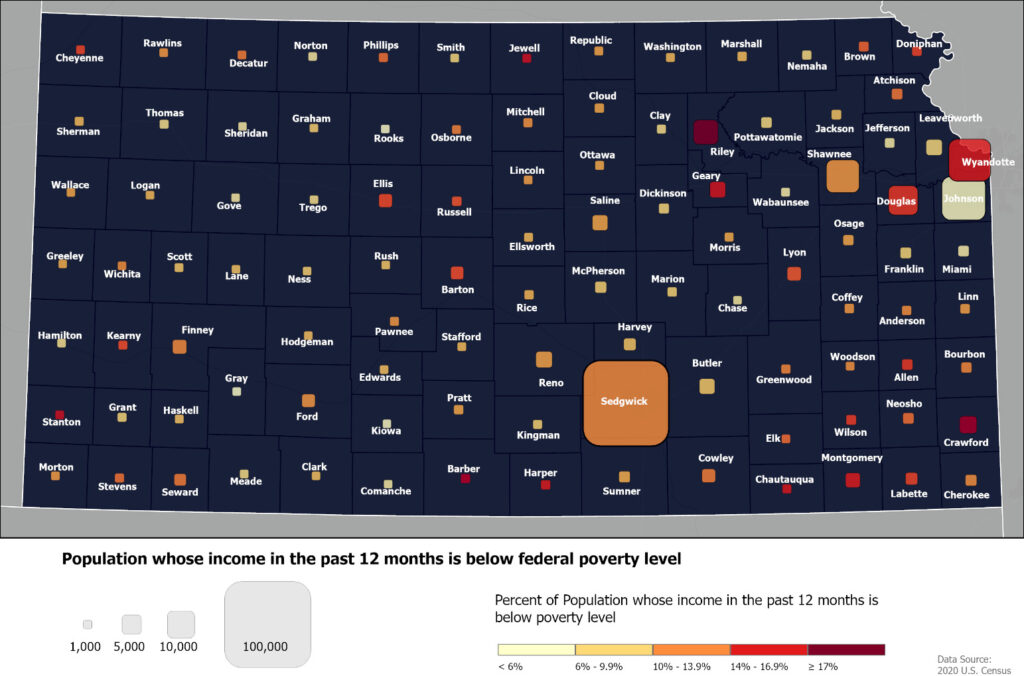
Members of this population and organizations serving them alike informed KOBD that major barriers for low income households include affordability of broadband-capable devices, lack of digital literacy skills, and a cybersecurity gap that arises from the absence of using the internet and these devices. Members of the Advisory Council noted that even if a household qualifies for other supportive subsidies (e.g., WIC, SNAP, Lifeline), they may still be unaware of ACP or a local device purchasing program. The challenge is complicated by inconsistent support from county to county. For instance, some counties have higher rates in purchasing devices than others. This may be a function of low program awareness in some counties and could be due to the lack of retail outlets, libraries, or other support institutions in these locations. This varying level of awareness extends statewide, emphasizing the need for KOBD to coordinate with agencies like DCF and other client-facing entities to ensure equitable awareness of affordability and skills development programs.
See section 2.3.2, ‘Key Performance Indicators by Population‘ for measurable objectives for this population.
3.2.1.2 Individuals who reside in a rural area
Like most states, Kansas has an increasingly urban population. However, over 800,000 Kansans (nearly 30%) live in rural areas[1] and face unique challenges related to broadband access. Multiple Roadshow conversations centered on the fact that regional ISPs and local cooperatives have historically led deployment of broadband infrastructure in rural areas. This has created areas of inconsistent and unreliable broadband service and inaccurate depictions of coverage in rural communities, and may in part explain the 15% difference in the broadband adoption gap between rural and non-rural areas of Kansas.[2] In the KFB survey, rural partners acknowledged public resources and services are miles away from many rural residents, especially in western Kansas. The University of Kansas Center for Telemedicine & Telehealth (KUCTT) noted that the importance of reliable broadband connectivity grows as telemedicine becomes a more accepted mode of healthcare delivery, especially for emotional wellbeing services, chronic health conditions, and overall emergency services. Their relationships with counties cover just 72 of the 105 counties in Kansas. This is only one example of need, but the same concept applies to education and employment opportunities. These gaps point to the need for expanded infrastructure in areas that are normally difficult to reach.
Agriculture is a predominant force in Kansas’ rural communities and is a key industry for the state. Over 80% of all land in Kansas in farmland, producing crops worth over $5.5 billion dollars annually.44 Moreover, agriculture is becoming more technology dependent, making connectivity to farmland — which in some cases can be thousands of acres — more necessary than ever before. In WSU’s report from the Roadshow, agricultural partners stressed the importance of broadband access through the last acre, not just the last mile. In addition, with agriculture upload speeds are just as critical as download speeds. Minimal upload speeds preclude working or learning from home but also may prevent farmers from transmitting performance data from their digitally connected equipment. While equipment innovations allow farmers to manage their crops more efficiently, poor connectivity can hamper these efforts. Another concern for the agricultural community is the need for reliable, safe, and robust infrastructure that is secure. From WSU’s report, rural partners stated “everything from livestock auctions, sales, marketing, market trading, invoicing, and other basic business activities rely on a secure network. Business financials should not become prey for cybersecurity threats.”F37 [3]
Rural Roadshow attendees also stated that satellite service has been one of the only options for some highly rural areas. Satellite upload speeds are insufficient and may be susceptible to interference from weather and seasonal foliage, given Kansas’ landscape. The FCC does not recognize this service as reliable broadband for the purposes of universal service. Federal BSL data identifies structures that are unserved or underserved, but it excludes farmland. Extending broadband access beyond physical structures must also be part of the planning process.
See section 2.3.2, ‘Key Performance Indicators by Population‘ for measurable objectives for this population.
3.2.1.3 Veterans
There are 163,000 veterans, or 5.5% of the population, residing in Kansas today. The Census shows that 14.5% of veterans are without broadband access. The Kansas Commission on Veterans Affairs identified two common barriers for veterans: affordability of broadband connectivity and awareness of ACP or device programs. First, there is evidence to suggest not all veteran service points of contact are familiar with or adequately trained in these affordability and device programs. Second, access to employment training and opportunities often relies on digital literacy skills, which presents a significant barrier for many veterans, and especially those who are unhoused.
Total Veterans 18 Years and Over
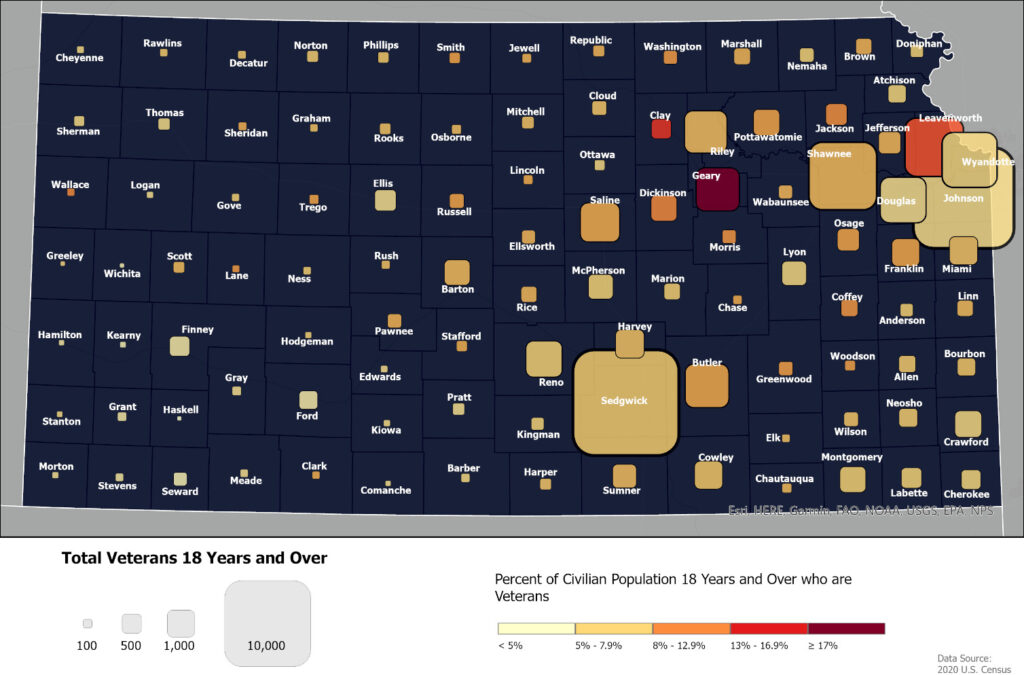
Older veterans have specific barriers to using technology because of a lack of digital education, training, and adoption. They tend to be on limited or fixed income with little computer knowledge and limited access to technology.
The health of veterans and the need to access telehealth was of specific concern and highlighted often in focused conversations. In WSU’s survey, of those who identified themselves as a veteran, 26.1% believed training would help them access online doctor visits, while 29.8% said they did not know where to go for help with digital
literacy skills.F38 [1]
Western Kansas lacks a veterans’ affairs location, which increases the importance of online access for veterans in this part of the state. Without broadband infrastructure, critical services become non-existent, and veterans may not receive needed services. To fill this need, Kansas Workforce centers offer a Local Veteran Representative who can offer referrals to other veteran programs and assist with employment services, training, and education.
See section 2.3.2, ‘Key Performance Indicators by Population‘ for measurable objectives for this population.
3.2.1.4 Individuals Who are Members of a Racial or Ethnic Minority
Broadband disparities impact racial and ethnic minority populations disproportionately, and Kansas must address their needs during this moment of opportunity. In Kansas 24% of the overall population, or 382,603 individuals, identify as a racial or ethnic minority. To better understand their unique needs, KOBD worked with members of African American, Hispanic, Asian/Pacific Islander, and Sovereign Tribal Nation communities to identify barriers and specific needs of each population.
Kansas Population by Race and Ethnicity



Wichita, Kansas City, and Garden City are all home to refugee communities. Dodge City, Liberal, and Great Bend are also highly diverse communities (though many consider them homogeneous) with migrant labor for meat packing, farming, the dairy industry, and other endeavors that impact the state’s agriculturally-driven economy.
Liberal has the highest free/reduced-price lunch population in the state. Kansas City, Wichita, and Garden City are communities where residents speak 40 to 80 languages. Highlighting these diverse needs will help draw a clearer picture of the challenges especially related to digital equity, where education and foundational literacy are at issue.
Looking at minority populations with more specificity, 5% of Kansans are African American, with most living in or near densely populated urban locations. Affordability is notable, but not the only significant barrier. A review of the BSL data and conversations with Advisory Council members and key community leaders revealed that another key barrier is the presence of unserved areas despite their proximity to densely populated areas with broadband service. This is particularly true for those who live in multi-dwelling units and encounter accessibility issues when the building needs equipment upgrades to improve unit access. KOBD found evidence of this when layering speed test data with demographic information. As a result, KOBD is working with ISPs to develop solutions like discounted rates and shared access points for MDU residents.
In some cases, neighborhoods with higher percentages of African American residents had speeds that registered as underserved in the speed test data, compared to neighborhoods with a different demographic makeup. The Census block group highlighted below, which includes 66% African American residents, depicts one block as underserved despite proximity to served areas. KOBD validated these observations by investigating urban BSL locations like the one below using KOBD GIS and mapping platforms.
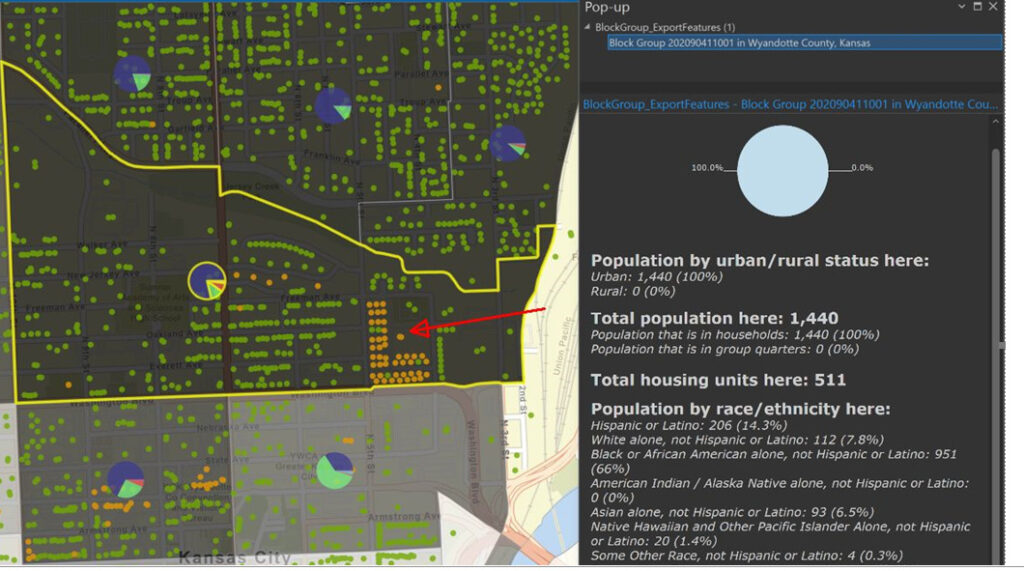
Furthermore, a visual check of the block via Google Map Street View shows this block comprises MDUs to consider for equipment upgrades, potentially through BEAD funding.
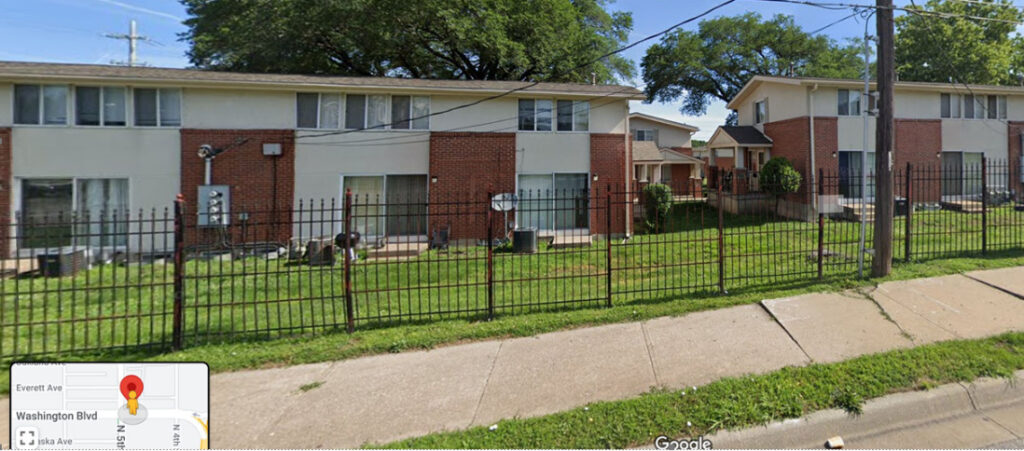
KOBD heard from Roadshow stakeholders who mentioned affordability of broadband services and the devices needed to participate in virtual services as issues, along with a need to increase digital literacy skills training. African American leaders and advocates stressed the need to make programs similar to nonprofits that specialize in
Science, Technology, Engineering, Arts, and Manufacturing (STEAM) training available to members of these communities. These organizations find it difficult to source funding despite being dependent on grants. In addition, some of these programs are small and serve their populations well, but they struggle to scale up resources. Larger collaborations and coalitions to expand the reach across the entire state are necessary.
Members of the Hispanic (12% of Kansans), Asian/Pacific Islander (3%), and other ethnic minority populations (including 0.5% identifying as “other” and 5.1% as “two or more races”) may have issues accessing resources due to language barriers. There are also inter-generational needs related to family communication and connections that are part of their native cultures.
For instance, in a specific focus group conversation with the Hispanic population located in Ford County, many in attendance held jobs at the local meatpacking facility. The lack of a reliable and quality internet connection was a critical point, as participants noted this can limit communications with family members, especially children, during emergencies. Focus group attendees mentioned they would welcome digital literacy skills training and find it helpful as part of the onboarding or continuing education of their jobs. Moreover, important work-related documents are online, such as paystubs, benefits or payroll forms, and access codes. Thus, training in digital literacy skills would be beneficial, but it must be the right amount of training at a rate learners can absorb.
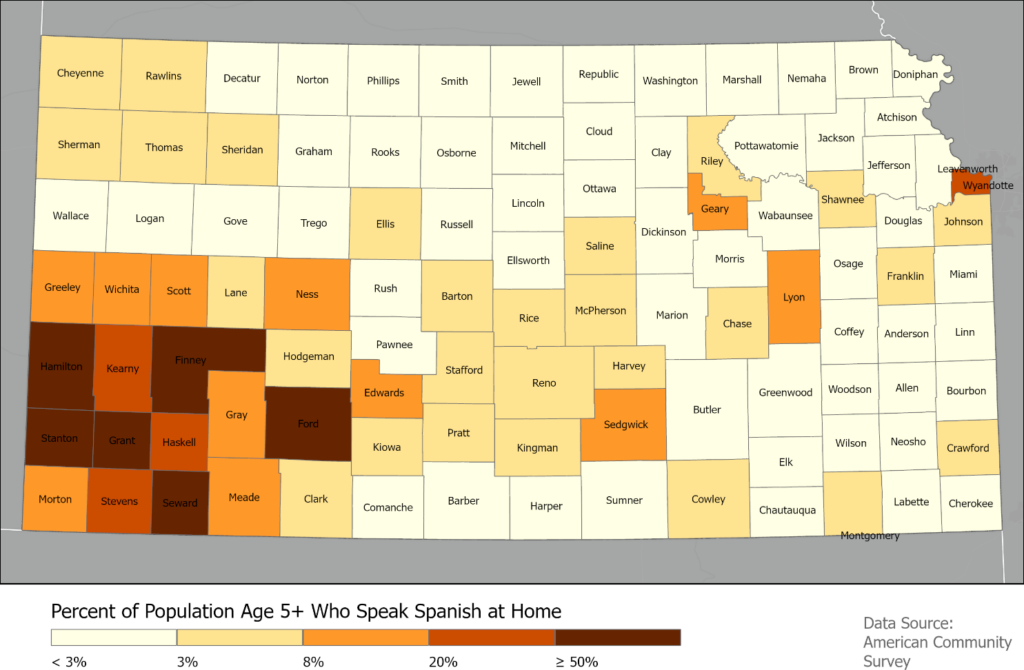
The state’s Hispanic population has a high density in southwestern Kansas. As digital equity facing resources are expanded across the state, it will be important to match resource development and distribution. For example, Spanish speaking resources appropriate for population density and need will be crucial to efforts with this population.
Individuals who identify as American Indian or Alaskan Native count for 0.4% of Kansas’ population. In dedicated consultations with the Sovereign Tribal Nations, KOBD learned that members find barriers as they tackle affordability and adoption of broadband connectivity. Furthermore, there is often a struggle to get Sovereign Tribal Nation members to sign up for ACP even if there is connectivity, due to the universally cumbersome process. While slightly different approaches exist, each of the Sovereign Tribal Nations seeks to solve their affordability and digital equity problems.
The Federal Reserve Bank of Minneapolis’ Center of Indian Country Development points out the majority of indigenous individuals live in urban centers rather than Sovereign Tribal Nation lands. Thus, a Sovereign Tribal Nation’s strategy must be inclusive of all members of Indigenous populations who reside in Kansas.
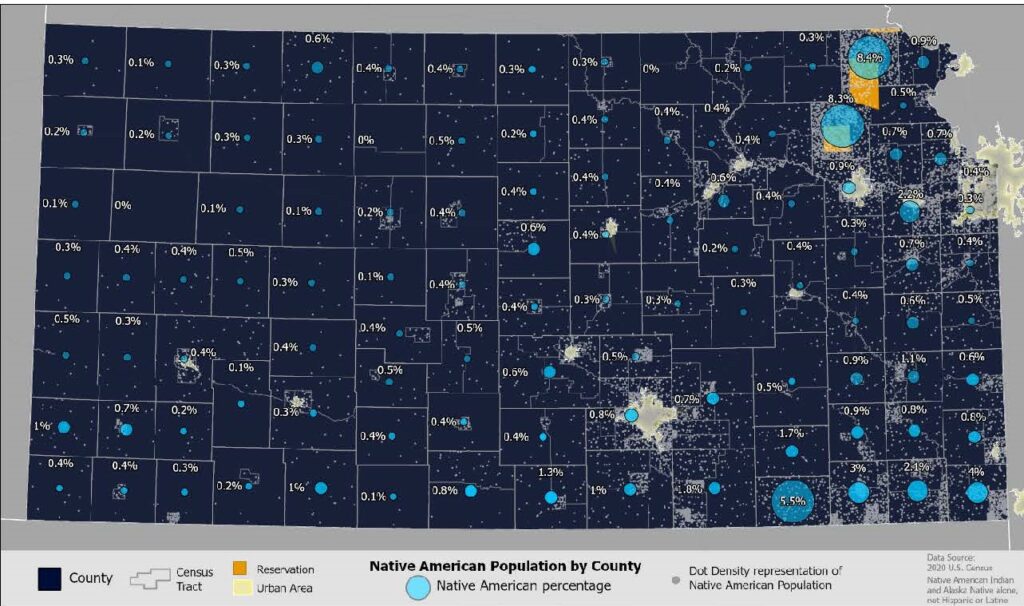
Native American Population by County
The state’s Hispanic population has a high density in southwestern Kansas. As digital equity facing resources are expanded across the state, it will be important to match resource development and distribution. For example, Spanish-speaking resources appropriate for population density and need will be crucial to efforts with this population.
Individuals who identify as American Indian or Alaskan Native count for 0.4% of Kansas’ population. In dedicated consultations with the Sovereign Tribal Nations, KOBD learned that members find barriers as they tackle affordability and adoption of broadband connectivity. Furthermore, there is often a struggle to get Sovereign Tribal Nation members to sign up for ACP even if there is connectivity, due to the universally cumbersome process. While slightly different approaches exist, each of the Sovereign Tribal Nations seeks to solve their affordability and digital equity problems.
While residents of Tribal lands face significant challenges with broadband access and digital literacy skill training availability, the Federal Reserve Bank of Minneapolis’ Center of Indian Country Development points out the majority of indigenous individuals live in urban centers rather than Sovereign Tribal Nation lands. Thus, a Sovereign Tribal Nation’s strategy must be inclusive of all members of Indigenous populations who reside in Kansas.
Sovereign Tribal Nation members. KOBD will promote a coordinated approach both on and off Sovereign Tribal Nation lands, as access to programs varies depending on residence in or outside of Tribal lands.
See section 2.3.2, ‘Key Performance Indicators by Population‘ for measurable objectives for this population.
3.2.1.5 Individuals with Disabilities
In Kansas, 14% of Kansans (409,000 people) live with at least one disability. Up to 71,000 Kansans with disabilities find themselves without a reliable broadband connection, creating additional barriers to participation in social and economic situations experienced by others in their communities. KOBD held various listening sessions with key agencies that support individuals with disabilities, including the Assistive Technology for Kansans program, and citizens who identify or support someone with a disability. These firsthand experiences highlighted how the broadband needs of individuals with disabilities intertwine with their health-related needs. Participants specifically mentioned telehealth and mental health services. Phone support is of limited value without a reliable, quality broadband connection. Most of the programs that provide the appropriate services for disability support are online, and many assistive technologies require broadband to operate most effectively.
Participants also mentioned the cost of training on special equipment designed with specific needs and sustainable funding as significant issues. Access to supportive additional services like instruments that can translate into braille or other necessary supportive services needs to be more robust in the state.
See section 2.3.2, ‘Key Performance Indicators by Population‘ for measurable objectives for this population.
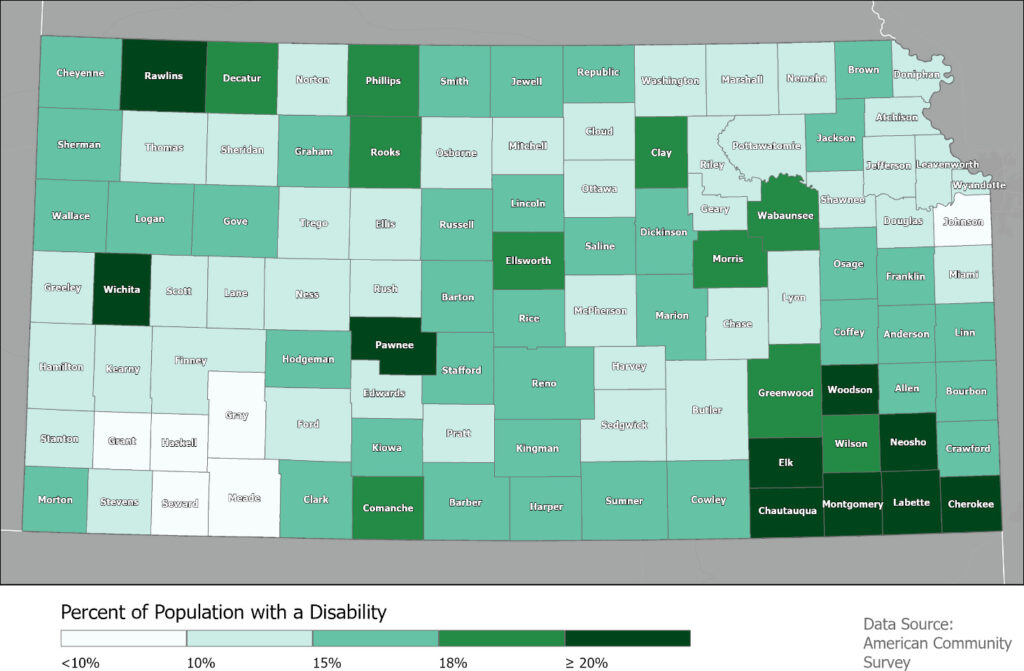
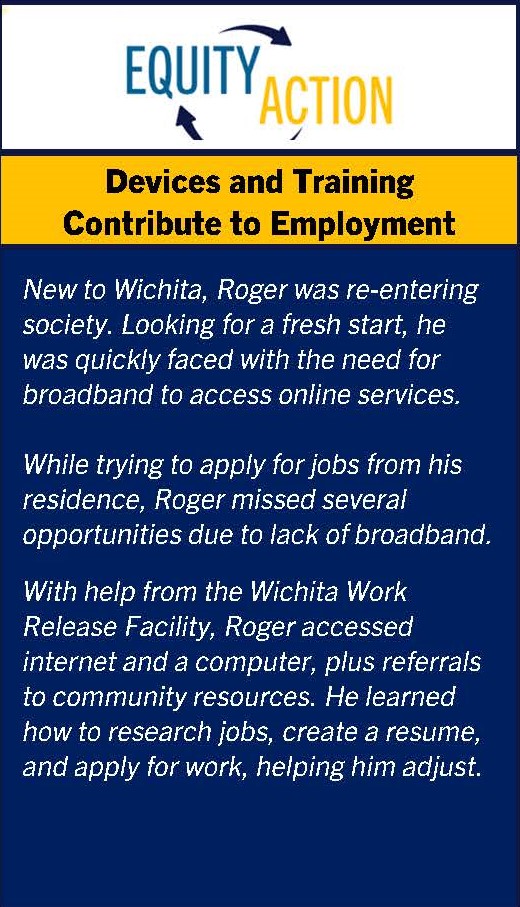
3.2.1.6 Justice-Involved Individuals
This plan defines justice-involved individuals as people who are incarcerated, especially those who are nearing release, along with people on probation or on parole. Kansas has approximately 8,900 individuals (0.03% of the population) serving in the DOC system, including nearly 140 juveniles. Another 5,310 individuals are in the parole system. The DOC works to support the needs of justice-involved populations despite some of the connectivity firewalls necessary while one serves a sentence. Appropriately restricted devices are available in some cases, though more robust device programs coupled with digital literacy skills training would represent even greater progress. Direct conversations with DOC, corrections officers, and justice-involved individuals focused on those people nearing the end of a sentence and about to re-enter society. The conversation revealed that not all corrections facilities have access to robust broadband services, which hinders digital literacy skills and creates security risks during outages. Redundant, robust broadband access is a security need.
This focus group related how unstable, unreliable broadband access affects their daily life. When service goes down, the lack of reliable broadband prevents connection with loved ones who act as a source of emotional support, and hampers access to resources. One focus group member explained how the inability can increase stress on facilities.
Probation officers for the DOC explained that many of those re-entering society start their post-incarceration cycle with a government-issued cell phone. This limited-in-utility cell phone does not allow for two-factor authentication, which is often needed to access governmental assistance programs and job application sites. The affordability of broadband service is the next barrier, as many recently released individuals are financially constrained when re-entering society. Deciding between core necessities and a broadband connection is difficult when starting a new life in the digital economy.
This population also mentioned applying online for jobs and social services as issues, with training and support in these areas as points of emphasis. For many who are re-entering society, ongoing technical support and training are necessary. Continuity of job training and skills training also relates to recidivism, and DOC pointed toward a need to build more programs that develop job certification prior to re-entry. See section 2.3.2, ‘Key Performance Indicators by Population‘ for measurable objectives for this population.

3.2.1.7 Aging Individuals
There are 382,603 people (23% of the population) over 60 residing in Kansas. Roadshow participants explained that “aging in place” is a major concern for older adults who live in areas that currently do not have reliable or quality internet service. In counties with higher populations of citizens aged 60 and older, the ability to access online telehealth and medical services such as telemedicine visits and long-term care monitoring is critical. Conversations with medical professionals revealed that medical device monitoring is a critical component in seniors’ ability to age in place. Devices that monitor vital information and deliver it to care providers in real-time require affordable, reliable broadband. Disruptions in connectivity due to slow and unreliable internet can jeopardize aging individuals’ independence and health outcomes.
From WSU’s broadband survey, 44.7% of older adults in Kansas use the internet for online doctor visits and 74.5% spend more than four hours a day online. Yet 28.9% do not know where to go for internet help and 10% disagree or strongly disagree they know how to use the internet (compared to 5% of the general population).
In KOBD’s digital equity surveys and listening sessions across the state, older adults stressed the importance of connecting with loved ones through broadband connections. Those who live in rural areas with little to no broadband infrastructure experience periods of isolation when video chats with loved ones are not an option. In addition, many aging Kansans without broadband are unable to obtain critical information or deliveries when needed. This leaves them disconnected from society and what is happening in their community and world.
Organizations like the Kansas Aging and Disability Resource Centers (ADRC) explained in conversations with
KOBD that digital literacy skills such as understanding how to use the internet also present a barrier for older Kansans. With the speed of devices changing, upgrading is a challenge for individuals who are not familiar with or native to technology. Organizations like ADRC address these issues with programs and would benefit from expanded funds for digital training resources. Another important concern is safety when using devices and technology. Security precautions, criminal activity, scams, and misleading advertising are concerns and present ongoing risks for the older population, especially for those on fixed incomes who may be targets of cybercrime or phone scams.
Senior Population (60+) Whose Income in the Past 12 Months was Below the Poverty Level
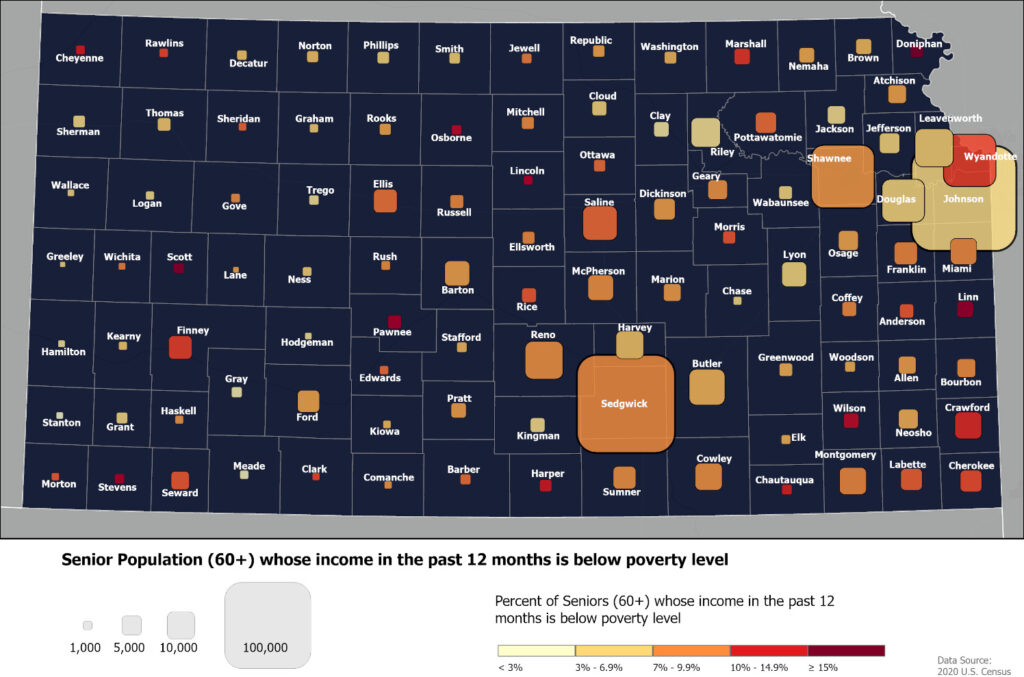
3.2.1.8 Individuals with a Language Barrier
In the Census, 61,800 individuals (2.1% of the population) said they speak English “not well” or “not at all.” 46.9% of this population does not own a desktop or laptop computer. Affordability is a major barrier.
Access to resources without translation or effective guidance creates an insurmountable challenge for members of this covered population. During a WSU listening session with organizations supporting refugees, staff explained the importance of a digital navigator. Without one, a simple application can become an impossible task. Moreover, this obstacle can arise at any stage of the process. If there are issues during equipment installation at the home of a person with a language barrier, the installer may not be able to successfully complete the installation. Thus, providing digital navigation assistance is immensely important to this covered population.
| Many adults lack basic computer skills, experience, or devices. This is the case for many Johnson County Adult Education students, including Pilar, an English learner in her 50s, who had never used a computer and was fearful of using a laptop in class. |
Not all ISPs offer support in signing up for ACP or other affordability programs in languages other than English. This barrier is especially prevalent in refugee populations navigating resettlement. The WSU report states the International Rescue Commission (IRC) explains there are significant barriers because most job applications are only in English or Spanish, whereas IRC’s Wichita service center serves those who speak Swahili, Pashto, Dari, Arabic, and Ukrainian.
The language barrier is not the only barrier for this covered population. IRC also mentioned concerns over proper documentation. For instance, information about what identification is required to access ACP can be confusing. The program is flexible and requires various forms of identification. A digital navigator can support these applicants and eliminate that confusion.
The DCF representative on the Advisory Council shared that for parents, guardians, school-aged children, and independent youth who speak other languages, navigating online education can be frustrating and harmful to students if not effectively managed. During the COVID pandemic, families participating in school from home without the expertise to troubleshoot online software or equipment had additional hurdles to equitable schooling.
See section 2.3.2, ‘Key Performance Indicators by Population‘ for measurable objectives for this population.
3.2.2 Broadband Adoption
The barriers that affect broadband adoption for all Kansans amplify the issues for covered populations. The stacking of barriers creates substantial roadblocks to the use of broadband resources. The Advisory Council mentioned that intersectionality can compound the negative impact of these issues.
3.2.2.1 Telehealth and Telemedicine
Telemedicine and telehealth are important components of modern medical care. The lack of reliable, affordable, and quality broadband service was a key issue in every Roadshow around the state. Knowing that telehealth is a growing resource requirement for the state, the United Methodist Health Ministry
Fund and REACH Healthcare Foundation, in collaboration with KU’s Medical Center, interviewed providers, administrators, and the public to identify their needs in the growing sector. Both patients and providers believed there is benefit in telehealth, as it allows access to care which would otherwise be difficult to access, particularly in a rural state such as Kansas. The state must encourage standardization of telehealth care to ensure public confidence in how to use the resource effectively and without security concerns.40 [1] F
Kansas will need to establish public policy and statewide resources as telehealth becomes a more trusted option. Currently, the leading resource is the KU Center for Telemedicine & Telehealth (KUCCT). It is an excellent partner to guide member healthcare facilities through the process of establishing telehealth and telemedicine programs. KUCCT serves 72 of 105 counties in the state but lacks the appropriate resources to expand. With funding, KUCCT could develop the staff and program implementation for necessary outreach, implementation, and administrative support to establish a full statewide initiative.
3.2.2.2 Housing Authorities and Broadband Adoption
Housing authorities act as a first line of support for many of the individuals in covered populations. Many housing authorities understand the programs their residents can access, including ACP or other affordability programs. MDUs also exist on the property of housing authorities, thus making them necessary partners in addressing the need to upgrade the wiring of MDUs without adequate and reliable broadband to each unit.
The Kansas Housing Authority, Topeka Housing Authority, and others have begun discussing the topic of internet access on housing properties. As ACP outreach coordination becomes a larger focus, bringing the housing authorities on board will be beneficial. To make this a statewide effort, KOBD will invite the member organizations of the Kansas Community Action Agencies Association to become part of the affordable housing and broadband conversation. Where there is not a defined housing authority, Community Action Agencies are supporting individuals and families in their housing needs.
As the network of digital equity deepens across the state, and more federal programs and resources such as Connect Home USA for housing via HUD come online, KOBD will work to align efforts with these organizations.
3.2.2.3 Digital Navigation
Digital navigation and navigators are key pieces to the puzzle as Kansas works to close the digital divide. A Boston Consulting Group study shows digital navigators can increase the effectiveness of digital equity programs. With support from a digital navigator, over 65% of survey respondents in the study were able to obtain internet access and a computer or tablet at home, and over 85% reported using the internet more.[1] This illustrates the crucial role of digital navigators, and KOBD will continue to support these roles across Kansas.
Most rural communities have few or no organizations offering digital navigation support, and distance to resources limits participation. Rural organizations also have limited computer stations open to the public, and many lack rental device programs to develop skills and learn at home.
Digital navigation programs grow organically from the need of a localized population and a committed organization that gathers the resources and community to support them, but their growth and success are not accessible through a centralized service. This leads to uneven access to digital literacy skills training and digital navigation throughout the state.
Organizations such as the United Food and Commercial Workers Union that serve much of the Hispanic population in Dodge City and Liberal have successfully built digital navigation programs as an extension of their core services. With funding, this program could develop the staff and programs to do the necessary outreach, implementation, and administrative support to establish a full statewide initiative.
Digital navigation is essential for adoption, with many organizations in the start-up phase of their organizational life. As this resource matures, Kansas can develop career pathways within digital navigation. Currently, the state’s librarians are the pinnacle of digital navigation along with a few nonprofits and some local service providers.
KOBD will build digital navigator career tools and help grow the resources needed to adequately support these statewide programs and a community of digital navigators who can learn from one another. Leveraging the curriculum development resources of Kansas higher education institutions is one way to build a digital navigator pipeline and ensure it provides the training, multilingual support, and service to communities that would most benefit from digital navigator support.
3.2.2.4 Digital Literacy Skills Education, Knowledge, and Skills Training
Strong digital literacy skills partners operate in Kansas, including K-State Research and Extension. K-State Research and Extension has a presence in every Kansas county and throughout the K-12 school system, acting as a resource for its students and guardians. In many cases, school-aged children may be bilingual and may have more digital literacy skills as a “digital native.” During COVID, schools provided digital navigation resources to families as they had to troubleshoot technology problems for students. Schools are a front-line partner in ensuring students and families have affordable access to broadband.
Workforce Centers and Goodwill locations also incorporated digital literacy skills training into their program design. Digital literacy skills training partners offer resources alongside workforce development and job readiness programs. The National Skills Coalition’s 2023 report, Closing the Digital Skill Divide, finds 92% of jobs require some level of digital literacy skills, including minimum wage positions.41 [2] Thus, there is an economic benefit to develop digital literacy skills both as the individual worker (i.e., ability to earn on average 23% more than a job requiring no digital literacy skills) and as the business owner (i.e., retaining workers and reducing turnover from mismatched skills).
Members of the Advisory Council, key nonprofits, and state agencies offer digital literacy skills training to their constituencies but have expressed a need for a “basket of tools.” Understanding and addressing the barriers of broadband access and adoption is complex and requires various tools like Northstar, DigitalLearn.org, and Human-I-T Selecting tools. These tools should include robust reporting features that track and help achieve milestones needed to meet the objectives.
The ability of digital literacy skills organizations to scale statewide would increase if resources and tools were subsidized or provided at no cost to organizations. The Kansas City Federal Reserve Bank’s report, “Disconnected:
Seven Lessons on Fixing the Digital Divide,” found in their survey of nonprofit organizations offering digital literacy skills that 47% use funding for more skills training offerings. Stipends are important to ensure participation. Stipends could compensate volunteers or support low-income participants as they pursue digital literacy skills training. As with digital navigators, ensuring enough instructors are available to meet the need will be important.
Both digital navigation and digital literacy skills training need resources dedicated to train-the-trainer programs.
3.2.2.5 Philanthropic Support
A common concern shared by the Advisory Council is that federal funds remain insufficient to satisfy the digital equity needs of Kansas, signaling a need for state or philanthropic investments and support.
Community, family, and corporate foundations, along with other established philanthropies, support programs with digital inclusion efforts built into their offerings. The Health Forward Foundation participates on the advisory board for the Kansas City Regional COVID-19 Response and Recovery Fund, which awarded $850,000 for digital equity initiatives aimed at closing digital equipment, accessibility, and literacy gaps in the Kansas City region.
The importance of this unprecedented federal funding for digital equity efforts can amplify the giving potential of philanthropic organizations and calls for extraordinary alignment of efforts.
3.2.2.6 Local and Regional Broadband and Digital Equity Planning
Local and regional participation in digital equity programs is necessary for the continued success of Kansas’ digital equity mission. Many local and regional leaders are new to broadband infrastructure and the digital equity needs of their communities. By creating a “Broadband Ready Communities” (BRC) program, KOBD will engage local and regional leadership on broadband-facing topics, including digital equity. The aim of the BRC program is to increase community participation, technical assistance, and awareness of broadband access and adoption in preparation for the upcoming investment over the next few years. For instance, KOBD will encourage interested communities to adopt favorable permitting and fee ordinances for efficient and effective buildouts. Communities that successfully implement these changes will more quickly implement grant-funded programs in support of this work.
When discussing the interplay between BEAD and DEA, the Advisory Council suggested digital equity resources such as a toolkit or training module for local and regional broadband education and support.
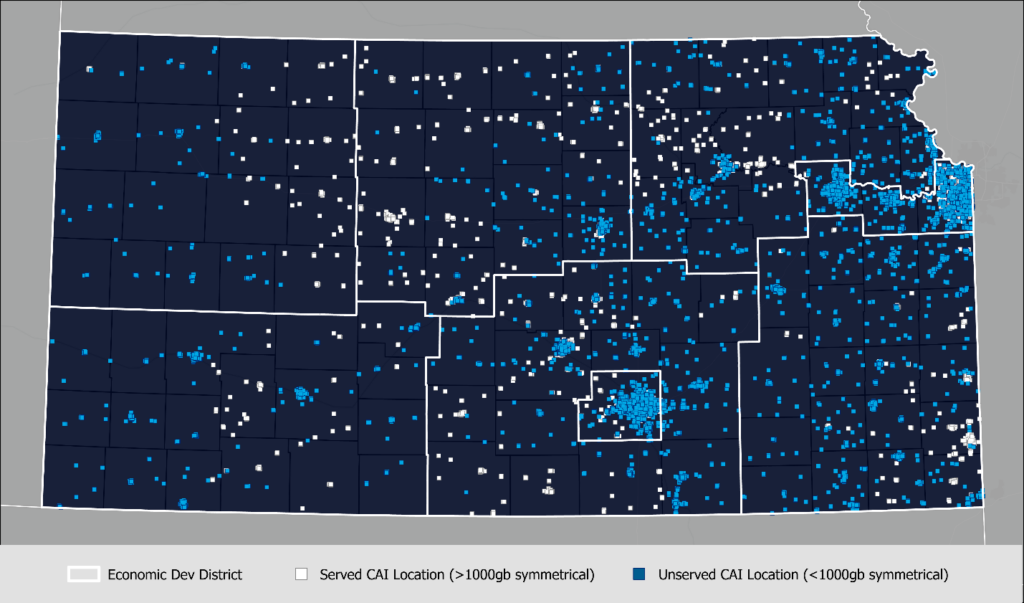
3.2.2.7 Community Anchor Institutions
Prior to BEAD and Digital Equity Act funding, Kansas had 1,626 identified CAIs. Applying the NTIA’s definition of CAI (i.e., a school, library, health clinic, health center, hospital or other medical provider, public safety entity, institution of higher education, public housing organization, or community support organization that facilitates greater use of broadband connection), the number of CAIs in Kansas shot to over 8,500.
KOBD plans to regularly review the CAI list alongside community partners and providers to help identify community locations that should qualify for inclusion. The goal is to make sure every community has community anchors identified that provide access to public Wi-Fi in support of their residents.
The provision of 1 Gbps symmetrical broadband will be dependent upon the CAIs themselves verifying the need for such a service in support of their communities. KOBD will conduct a survey of all CAIs after the Volume 1 public comment period to verify demand at each location.
3.2.3 Broadband Affordability
3.2.3.1 Lower Costs
The cost of monthly broadband subscriptions remains a barrier to universal service in Kansas. In WSU’s survey, KOBD found:
KOBD meets with the ISP community in bi-weekly roundtable sessions. KOBD uses these opportunities and additional outreach to ISPs to encourage the creation and promotion of discount plans to maintain affordable prices for broadband service across all covered populations and Kansas as a whole.
3.2.3.2 Unbundled Services
The inconvenience of “bundling” of services (i.e., when providers offer discounts for subscribing to multiple services like cable, wireless connections, cell phones, and internet-of-things (IOT) home offerings) is an issue. Households that wish to pay for a broadband subscription face a different cost than someone who “bundles.” This disincentivizes those with financial constraints from subscribing to an internet service.
3.2.3.3 ACP Awareness, Enrollment, and Recertification
For those who qualify, ACP is the primary resource Kansans use for an affordable broadband connection. The current ACP enrollment rate for Kansas is 26.0% (37th in the country). Increasing communication and awareness to qualifying families is a priority of KOBD. Working with ISPs and others to increase visibility of affordability options is critical.
Specifically, KOBD will support three ACP Outreach grant recipients: the City of Topeka, Wichita State University, and KC Digital Drive. ISPs, with their own programs, can help by maintaining those programs, defining equitable eligibility thresholds, and collaborating on programs and standards to advance affordability and access.
While KOBD will focus on increased participation for ACP and other broadband benefit programs (including any subsequent programs that may replace or supplement ACP), it is equally important to nurture those who have taken advantage of these programs so they continue to benefit.
This section identifies digital equity stakeholders and their contributions, as well as KOBD’s strategies to engage current and future stakeholders.
4.1 Coordination and Outreach Strategy
Connecting with Kansans about their broadband access, affordability, and adoption issues was an important and invaluable exercise for KOBD to develop this Digital Equity Plan. Starting in January 2023, KODB conducted listening sessions, hosted focus groups, gave presentations, and listened directly to community leaders and advocates. Conversation and targeted outreach will continue, and KOBD offers a snapshot of that work below.
4.1.1 KOBD Roadshow
KOBD collaborated with the WSU Public Policy and Management Center (PPMC) to facilitate a series of community meetings, lead listening sessions, and conduct a survey of Kansans to learn about their “lived experience” in the digital divide. As part of their efforts, WSU PPMC completed:
The full report is in Appendix 4 — Kansas Office of Broadband Development and Wichita State
University Roadshow Report — “Digital Equity in Kansas.”
KANSAS ROADSHOW LOCATIONS
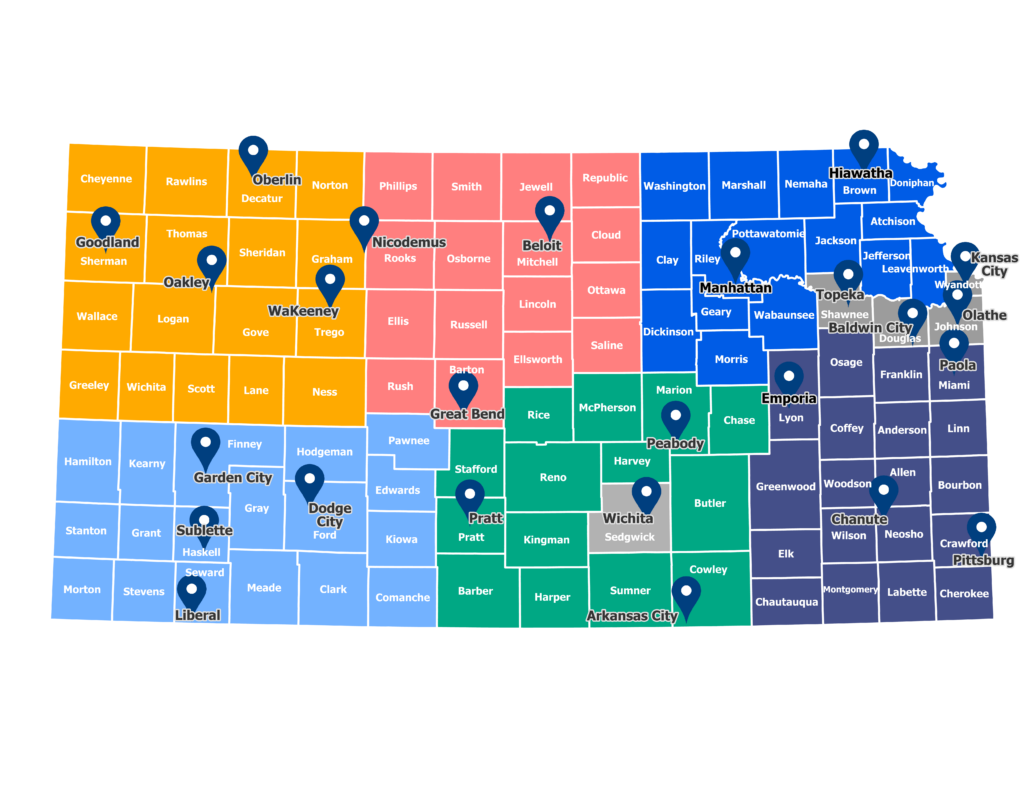
4.1.2 University of Kansas and Digital Equity Asset Map
KOBD engaged the KU Institute for Policy and Social Research to conduct an asset mapping exercise. Over 100 organizations that offer digital equity services to the community provided their information.
DIGITAL ACCESS ORGANIZATIONS RESPONDENTS BY LOCATION
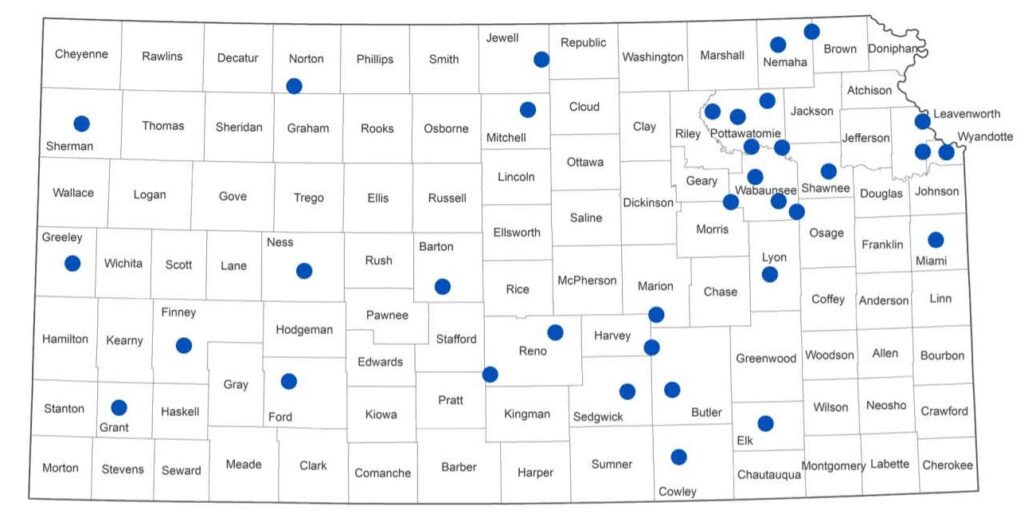
The full report is in Appendix 5 — University of Kansas Institute for Policy and Research Report — “Digital
Inclusion Assets in Kansas.”
4.1.3 Additional Surveys
KOBD will continue to conduct surveys to measure progress on closing the digital divide. Inspired by their attendance at the Roadshow, the Kansas Department of Agriculture circulated a broadband survey based on questions asked at the Roadshow. The 179 responses added personal perspectives from rural inhabitants. The details of the survey are in Appendix 6 — Agriculture Bureau Survey of Constituents.
4.1.4 Digital Equity Advisory Council
KOBD established a Digital Equity Advisory Council to support the development of a State Digital Equity Plan. The Advisory Council, with membership intended to represent every covered population, provided crucial input from practitioners of various backgrounds, experience, careers, and commitment to this work. The Advisory Council meets monthly with exercises, homework, and discussions, providing information for every element of this Digital Equity Plan.
TABLE 21: MEMBERS OF THE DIGITAL EQUITY ADVISORY COUNCIL
| Name | Title/Organization |
| Barbara Bichelmeyer | Provost and Executive Vice Chancellor, University of Kansas |
| Chan Brown | Program Officer, Kansas Health Foundation |
| Kenya Cox (With TJ Ingram) | President, Kansas State Conference of NAACP (State Legal Redress Chair, Kansas State Conference of NAACP) |
| Aaron Deacon (With Leslie Scott) | Managing Director, Kansas City Digital Drive (Program Manager, Kansas City Digital Drive) |
| Glenda DuBoise | State Director, AARP Kansas |
| William Duncan | Assist Research Professor of Data Science, Kansas Data Science Consortium |
| Cris Fanning | Executive Director, Programs and Risk Reduction, Kansas Department of Corrections |
| Jennifer Findley | Vice President Education and Special Projects, Kansas Hospital Association |
| Scott Gowan | Chief Information Officer, School District 501, Topeka Public Schools |
| Lazone Grays | President/CEO, IBSA |
| Kathi Grossenbacher | Director, Information Technology, Kansas State Department of Education |
| Nathan Harjo | Supervisory I.T., Haskell Indian Nations University |
| Jeremy Hegle | Assistant Vice President and Community Affairs Officer, Federal Reserve Bank of Kansas City |
| Amy Huffman | Policy Director, National Digital Inclusion Alliance |
| David Jordan | President and CEO, United Methodist Health Ministry Fund |
| Stacey Knoell | Executive Director, Kansas African American Affairs Commission |
| Dana Ladner | Compliance, Education and Agency Support Program Manager, Kansas Department of Agriculture |
| Bryan Seamans | Chief of Telecommunications, Kansas Corporation Commission |
| Name | Title/Organization |
| Scott Smathers (With Hector Martinez) | VP for Workforce Development, Kansas Board of Regents (Director, Adult Education, Kansas Board of Regents) |
| Shanna Smith-Ritterhouse (With Tabitha Hogan) | President, Kansas Library Association (Director, Winfield Public Library) |
| Wendi Stack | Research Associate, League of Kansas Municipalities |
| Melinda Stanley | Federal Program Officer, National Telecommunications and Information Administration |
| Monica Vargas-Huertas (With Carla Rivas-D’Amico) | Political and Community Outreach Director, UFCW2 (Executive Director, Kansas Hispanic and Latino American Affairs Commission) |
| Jancita Warrington | Executive Director/Tribal Liaison, Kansas Native American Affairs |
| Felicia Welch | Employment Services Program Administrator, Department for Children and Families |
KOBD consulted with all four of the federally recognized Sovereign Tribal
Nations in Kansas: The Prairie Band Potawatomi Nation, the Iowa Tribe of
Kansas and Nebraska, the Sac and Fox Tribe of Missouri, and the Kickapoo Tribe in Kansas. Meetings focused on the broadband access, affordability, and adoption needs of each tribe’s members.
KOBD will continue outreach efforts to each tribal nation to establish trust and a true working relationship with regularly scheduled consultations.
4.1.6 Additional Covered Population Focus Groups
After analyzing information gathered by WSU and the Roadshow, KOBD assessed gaps in populations present and arranged for additional focus groups to target those missed by initial outreach activity, including:
4.1.7 State Agency Information Sessions and Listening
Sessions
KOBD held dozens of informational sessions with state department and agency leadership to detail the opportunities for digital equity work and BEAD programs. The sessions led to direct conversations with state agencies that serve all the covered populations regarding current agency efforts’ alignment with digital equity needs. In addition, this collaboration now has agency representatives on the Advisory Council. Follow-up conversations included the following state agencies:
4.1.8 Public Comment
As required by the NTIA, this plan must first be presented for public comment prior to submission. That process and timing, as established in NTIA guidance, is as follows:
| Step | Description | Timeline |
| 1. State drafts digital equity plan | KOBD has used the support of their State Federal Program Officer (FPO) and NTIA staff for informal reviews and feedback before publishing their Digital Equity Plan for public comment. KOBD has used the provided template to make the Plan available for public comment prior to submission to NTIA. | Q1-Q3 2023 |
| 2. State posts draft digital equity plan for public comment | KOBD is required to make the draft Digital Equity Plan available for public comment, consider the comments made, and revise the digital equity plan as appropriate. KOBD must also provide a written response to each comment and describe any changes made to the plan as a result. | Q3-Q4 2023 |
| 3. State submits final digital equity plan and public comments | After incorporating feedback from public comments into the Digital Equity Plan, KOBD will use the NTIA Grants Portal to submit the final digital equity plan and a Record of Public Comments and Actions Taken and attest to meeting statutory and NOFO requirements. | Q4 2023 |
KOBD’s process for Step 2 above (collecting and incorporating public comment) has been completed as follows:
4.2 Obstacles and Challenges in Outreach
As the focus on digital equity concerns continues to deepen throughout the state, KOBD must “open the tent” and include not just the stakeholders reached during our initial efforts, but also those who have been missed in engagement efforts. KOBD welcomes current partners, organizations new to KOBD, leaders, and advocates who can help drive communications and education throughout the state.
Identifying and mapping the digital equity assets in Kansas has just begun and will be an ongoing effort. To effectively build a resource that is an accurate and useful tool for decision makers and the public, KOBD will work to support dedicated resources. A data-rich population and asset tool can serve as a crucial information source for decision-making by KOBD and partners. A related public online digital equity asset map can help individuals and organizations throughout the state connect for resources, shared connections, and planning. With this map as a user-friendly communications tool, KOBD can support digital equity stakeholders in a more clear, focused, and deliberate way.
Attracting community members to rural meetings was sometimes a challenge, though overall attendance was strong, and the Roadshow was an unqualified success. In some instances, Roadshow stops attracted over 40 attendees and garnered great feedback. While KOBD also experienced Roadshow events with little attendance despite communications with traditional and non-traditional media sources, those who did participate provided equally valuable feedback. Continually building the network of well-connected local champions who encourage their communities to participate is essential to future engagements.
KOBD’s initial outreach efforts are typically the first interactions with covered population members, local leaders, and advocates regarding broadband access and adoption. KOBD has made a commitment to moving beyond the first stages of communication with Kansans on their digital equity efforts. As programs and activities emerge, continual communication with key partners and stakeholders will be integral to ongoing success.
KOBD is fortunate to have the Advisory Council and other broadband champions who can make connections with community leaders and advocates. By committing to having KOBD Digital Equity staff spending time “in the community,” these relationships will flourish.
Members of the Advisory Council were clear that many of the partner agencies and organizations identified in this plan are at (or over) capacity, especially with personnel and resources. Tighter collaborations, shared resources, support networks, and effective communication will lead to sustainable digital equity efforts. Rather than design and implement activities that duplicate existing efforts, KOBD will execute many components of this plan in alignment with partners to support, enhance, and scale existing programs. Leveraging the expertise, networks, and ideas of partners will ensure timely, useful, and efficient resource use that effectively supports the broader statewide objectives outlined in this first digital equity plan for the state.
4.3 Future Plans for Stakeholder Engagement
The work to close the digital equity gap relies heavily on local stakeholders. KOBD will maintain relationships with partners that help in plan development, implementation, monitoring, and growth. The future strategies and plans discussed in the following section describe how KOBD will maintain and grow stakeholder engagement. This plan’s evolution will continue to rely on future stakeholder engagement during the implementation phase in ensuring the plan is being updated, maintained, and elevated to fully reflect covered populations’ needs. This will lead to adequate, affordable, and reliable broadband with the devices, skills, and support necessary to actually close the digital divide in Kansas.
The Advisory Council, with membership intended to represent every covered population, will continue to play a key role in the implementation of the BEAD and DEA plans, offering feedback from the field as program development takes place and continuing to connect with resources in the field.
Advisory Council members have selected implementation roles including the Outreach and Engagement role, which promotes Digital Equity by convening statewide partners to inform and execute ongoing activities and events; the Advocacy role, which provides public support for or recommendations on a particular state cause or policy; and the Digital Equity Ambassador role, which is a promoter or representative called upon for specific activities to close the digital divide. KOBD believes these roles will assist in driving purpose and participation of not only the continued monthly Council meetings, but also local implementation activities — therefore increasing awareness and opportunity for KOBD to meet the covered populations where they are, and highlight the programs that support them.
As infrastructure deployment begins, KOBD will support regional broadband planning efforts in combination with its BRC program, planning work, and technical assistance. Early and clear communication with these local and regional stakeholders about the parallel work of digital equity will be important.
The KOBD BEAD and DE teams are in communication to strategize how BEAD funds, additional federal and state infrastructure funds, and digital equity funds (both from NTIA and otherwise) all interplay. This will ensure there is no duplication of services and that a distribution of resources reaches every part of the state. This process is best informed by open channels of communication that empower local leaders and advocates. As discussed before, KOBD will use KDC’s eight regions of economic development as the regional support structure that will in turn support local broadband efforts.
KOBD will interact with these local and regional broadband groups concerning digital equity in a number of ways:
KOBD created an overlap in personnel between State Digital Equity planning teams and BEAD Program planning teams to create subject matter experts knowledgeable about both programs and aware of milestones in each area. KOBD’s staff will continue to increase their industry knowledge highlighting DEA objectives of Affordability, Availability/Adoption, and Cybersecurity.
An example of related BEAD and DE activities is partnership with workforce engagement and Economic Development organizations like KANSASWORKS. Digital Equity benefits from identifying opportunities for multilingual Kansans and individuals with disabilities who can work in customer service and technical assistance, while BEAD helps create new career pathways for newly skilled technical line workers through partnership with the Kansas Board of Regents.
The strategies developed in this DE plan will be implemented alongside multiple broadband infrastructure and digital equity funding sources as listed in Table 1. As noted there, KOBD has executed (and continues to execute) multiple federally funded programs that are all carefully coordinated and cross-optimized to ensure minimal overlap, clear delineations of rules and purpose, and thorough, accurate reporting. This history of efficient management across multiple programs will continue with DE and BEAD funding and programs.
While KOBD plans that all other BEAD funding will be allocated for infrastructure, the KOBD DE plan and the BEAD Five-Year Action Plan (FYAP) will be tightly integrated to ensure that closing the digital divide is a critical component of statewide efforts. The primary focus of the FYAP will be developing a strategy to provide all Kansans the infrastructure necessary to access broadband internet. However, the FYAP will also address digital adoption strategies such as digital skills training, device access, broadband affordability, and workforce development (KOBD plans to use a portion of allocated BEAD funds for workforce efforts related to broadband infrastructure projects). These factors all contribute to the success of broadband infrastructure projects and impact project take rates. The DE plan will complement the FYAP by crafting detailed strategies to deploy digital opportunity resources that coincide with infrastructure projects funded through BEAD allocation. In doing so, Kansas plans to have a comprehensive approach to addressing broadband and digital opportunity needs in the state.
Objectives for the BEAD FYAP are presented below with their corresponding relationship to the DE plan.
| BEAD OBJECTIVE | BEAD GOALS | DE PLAN ALIGNMENT |
| Ensure universal broadband coverage to every home, business, farm, and CAI | Expand middle-mile infrastructure and interexchange points to reduce deployment costs to unserved communitiesPrioritize unserved, high-cost, and rural locationsUnderstand and mitigate the localized barriers to deployment | Support for all covered populations, especially rural residents; Support for joint community planning |
| Leverage innovative solutions and “futureproof” technologies for broadband deployment and accessibility | Prioritize fiber deployment solutionsEvaluate and deploy non-fiber broadband technologies where economically and technically required Examine process(es), partnership(s), and grant design(s) to ensure sustainability and the accrual of long-term benefits | Support for availability objective; support for continuous partnership with practitioners and funders to ensure sustainability |
| Continue to develop and evolve the digital economy throughout the state | Develop training and certifications for broadband installation and maintenance related jobsDevelop training for broadband-affiliated jobs (i.e., sales, customer service, technical support)Create career pathways (i.e., apprenticeships) to meet the workforce need for universal broadband coverage | Development of digital skills and cybersecurity training programs; Support for workforce efforts |
| Ensure all Kansans can live, learn, work, play and compete regardless of where they live in the state | Prioritize digital skills development and training for covered populationsCreate statewide digital navigator and device placement program(s) Augment the value of universal broadband coverage to Kansans (i.e., telehealth, remote working, education, social and community activity, etc.) | Support for all covered populations; support for device, availability, digital skills, public service, and affordability objectives |
4.3.3 Act as the Convener on Key Issues
The Kansas network of digital equity practitioners is new and needs support to mature to a network of wellresourced collaborators working toward a unified goal. Stakeholders are interested in formal and centralized conversations around better ACP outreach, the role of housing authorities in promoting and offering digital equity resources, and the creation of toolboxes of various resources for organizations.
KOBD will lead issue-specific conversations through quarterly round tables, issue-specific learning sprints, and conferences for the development of this field.
KOBD will inform state agencies and service providers in the healthcare, education, nonprofit, and other industries on the availability of programs and resources for covered populations, and will encourage participation in collaborative efforts or platforms where appropriate.
Being intentional about coordinating public and private funds together for digital inclusion programs is necessary. Amplifying the historic investment of digital equity funds by energizing and aligning local philanthropic organizations will contribute to the long-term sustainability of these initiatives. KOBD will reach out to community foundations and other private philanthropies to assess whether a state role as matchmaker, strategic partner, or another designation is appropriate. Regardless, Kansas’ foundations will play a vital role in digital equity for the state.
4.3.4 Be Present Across the Entire State of Kansas
Kansans want to be part of an ongoing conversation about digital equity, but also want to serve as part of the solution to close the digital divide. KOBD will return to all eight economic development regions of the state and revisit half or more of the original Roadshow stops to keep the dialogue going, assess progress, and discuss needs.
The local conversations made it clear that support for the full spectrum of broadband issues — access, affordability, and adoption — will be a critical role for KOBD in our communities. Close work with potential partners like the Kansas Farm Bureau, Kansas State University Rural Education Center, and other entities focusing on rural populations will be important in ensuring DE efforts extend throughout all Kansas.
4.3.5 Deepen Existing Relationships and Build Out Additional Digital Equity Partnerships
KOBD is fortunate to have the support of many organizations actively working in the digital equity space. Yet, more organizations can still come to the table. While many have been identified, relationships take time to develop. For example, conversations with housing authorities regarding affordability efforts have occurred, but there is more work to do. Housing authorities and Community Action Programs (i.e., operators of housing programs in areas that do not have defined housing
authorities) could coordinate to develop programs that provide covered population support. KOBD had success in holding a focus group for the Hispanic population served by the United Food and Commercial Workers Union. Expanding KOBD’s ongoing communication and support of their efforts will be important, as will building relationships with other labor unions and trade organizations.
Another example is the need to create digital navigator programs in collaboration with organizations such as the Kansas Association of Retired School Personnel (KARSP), the Hospital Association, the Medical Society, and community health workers. Continued communication and outreach for this purpose will continue, and deepening these relationships will be key to KOBD’s efforts.
Likewise, KOBD and its partners will need to increase collaboration with media outlets to raise awareness and support efforts. Local newsrooms, including those reaching covered populations, such as rural weekly news outlets, nonprofit communications vehicles, members of the Black and Latino/Hispanic press, and hyperlocal digital-only fill critical information gaps among Kansas residents. These outlets will be key partners in increasing awareness of broadband resources and will also serve as digital equity assets themselves as they pursue objectives to enhance the civic and economic participation of Kansas residents.
Digital inclusion coalitions often include libraries, community-based organizations, local governments, housing authorities, and others in communities across the country. These coalitions organize to cooperatively address equitable access to and use of communication technologies, and play a key role in promoting and supporting healthy digital equity ecosystems.[2] KOBD will strengthen existing relationships with these coalitions to support cross-organizational collaboration. Digital equity planning should include creating and sustaining healthy digital equity ecosystems.
5.1 Implementation Strategy and Key Activities
Nonprofits, state agencies, and others are performing quality digital equity work in Kansas. That work is not consistently coordinated or supported on a statewide basis. With funding from NTIA and support from KOBD, the impact of this work can be focused and amplified throughout Kansas.
Plan and outcome monitoring, improvement, and sustainability
To keep the DE plan current and reflecting needs as they change throughout the life of the effort, KOBD will institute a regular monitoring and improvement cadence. Repeated annually, the cadence will ensure the plan is responsive, improving, and sustainable. The cadence will take the following shape:
| Activity | Purpose | Stakeholders | Frequency |
| Statewide survey | Generate KPI data | General public, covered populations | Annual |
| KPI review | Track progress against objectives | KOBD, NTIA | Annual |
| Plan progress review | Track progress against planned activities, schedule, budget, etc. | KOBD, NTIA | Semi-annual |
| Advisory Council checkpoint | Continuous check on activity; advice; feedback | Advisory Council | Monthly |
| Partner evaluation | Review opportunities for improvement with practitioners and state agencies | Partners, state agencies, other practitioners | Annual |
| BEAD coordination activities | Ensure alignment and no duplication of effort with BEAD and workforce activities | BEAD team, ISPs, communities, workforce entities, NTIA | Monthly |
| NTIA reporting | Provide NTIA | NTIA, general public | Semi-annual |
KOBD believes its role is to serve as a coordinating and supporting statewide partner. With this in mind, KOBD developed the following implementation strategies and key activities with input gathered from listening sessions; focus groups with members of all covered populations; outreach sessions with state agencies and organizational partners; and Advisory Council meetings.
5.1.1 Strategy 1: Leverage the work of existing partners to enhance the number of digital equity resources throughout the state
Most digital equity organizations in Kansas deliver vital services in limited geographic regions. KOBD will help connect these entities with a network of digital equity resources to effectively scale to cover the entire state. KOBD will also help state departments and agencies focus on inter-agency communication and planning to streamline offerings, increase awareness, and magnify their collective impact while being good stewards of public dollars.
The first challenge in narrowing the digital divide in Kansas is to scale up existing programs. As identified elsewhere in this plan, many agencies and organizations supporting digital equity work in Kansas are building their resources and are not sufficiently funded to scale their excellent work statewide. A consolidated pool of digital equity funding to support expansion of these programs will help address resource-constrained efforts. Coordination with state agencies and benefits management divisions on messaging, opportunities to improve public services, and resource sharing will narrow gaps in awareness that contribute to low ACP enrollment.
These activities advance all digital equity plan objectives, principally the desire to promote the accessibility and inclusivity of public resources and services. State agencies will be pivotal in leading the way on this issue, which will answer a major concern raised by Advisory Council members and the public. Existing digital equity efforts must be expanded to provide greater access to services. This increased access will in turn lead to improvements in KPIs related to device programs, affordability, digital literacy skills, and cybersecurity.
TABLE 22: STRATEGY 1 ACTIVITIES
| Activity | Impacted Populations | Objectives | |
| 1 | Coordinate state agency support of covered populations | All covered populations | 1, 2, 3, 4, 5, 6 |
| Work with an inter-agency committee of covered population subject matter experts to make sure external facing services align with existing digital inclusion programsEnsure state agency resources are more inclusive and accessible to all KansansDevelop a training and communications program to increase awareness and promote ACP and other digital equity affordability programsEngage with entrepreneurial-facing resources in the Department of Commerce and other organizations to reach underrepresented members of covered populations Tie existing efforts like the Community Healthcare Worker program, library initiatives, and population-specific programs like Revolucion Educativa into digital navigation skills work | |||
| 2 | Create a consolidated funding pool to scale up support | All covered populations | 1, 2, 3, 4, 5, 6 |
| Create a funding mechanism to promote collaboration between digital equity organizations to expand offerings through funding opportunities that pilot new collaborations from cohort supportGive these cohorts short, attainable goals leading the coalition to larger funding opportunities after establishing initial benchmarks for ideas like supporting a consortium of tech hubs (example: Topeka’s IBSA and a larger, regional urban and rural coalition) and initiatives that expand remote-work upskilling (example: The Innovation Center and new rural partners working on remote worker training opportunities, especially for covered populations) | |||
| 3 | Fund expansion of existing efforts | All covered populations | 1, 2, 3, 4, 5, 6 |
| Support existing efforts and work with additional funding, allowing established partners, like the Kansas Library Association, KC Digital Drive, and Goodwill Industries, to continue to build their footprint with a goal of statewide digital equity servicesPromote the replication of successful models with new partners when appropriateIncrease awareness, skills, and support of ways to make services more accessible, available, and inclusiveUse CPF-DCT funds to promote broadband access in communities where affordability is a barrier to broadband adoption through the purchase and installation of laptops, tablets, desktop personal computers, and public WiFi equipment | |||
| 4 | Create a statewide clearinghouse of digital equity resources | All covered populations | 1, 2, 3, 4, 5, 6 |
| Establish a collection of software resources accessible to digital equity entities. Software platforms focused on digital equity challenges include Northstar, DigitalLearn.org, and Human-I-THelp ensure these platforms, training, and support are accessible to digital equity organizations with the expertise and infrastructure of partnersEncourage statewide use of these platforms to provide aggregated and standardized data to inform decision-making, indicate success or improvement opportunities, and provide transparency to stakeholders | |||
| 5 | Expand technical capabilities to cover the entire state | All covered populations | 3, 4, 5 |
| Support the expansion of the KU Center for Telemedicine and Telehealth suite of digital offerings throughout the entire state, and request additional support from organizations such as the Kansas Hospital Association and the Medical Society to expand telemedicine accessSupport telemedicine training and information fairs within healthcare facilities in partnership with organizations such as AARPSupport emergency services and navigators for public services, especially in rural areas, by partnering with local nonprofits to deliver virtual training sessions in hard-to-reach communities | |||
| Potential partners: Digital Equity Advisory Council; Goodwill Bridge to Technology; Essential Families; IBSA; The Innovation Center; KLA; KC Digital Drive; KU Center for Telemedicine and Telehealth; Kansas Hospital Association; Kansas Medical Society; AARP; state agencies | |||
5.1.2 Strategy 2: Create sustainable affordability options building on the success of current partners and programs
Affordability of broadband service, distribution of devices, and availability of digital literacy skills training are imperative for the overall success of this plan. Bolstering existing efforts and creating digital navigation resources throughout the state are critical in moving toward universal service.
Addressing affordability and device accessibility in this manner will improve affordability, digital literacy skills, cybersecurity, devices, and public services KPIs. Increasing the availability of digital navigators across the state will be a focal point, with improvement in ACP enrollment, device access, and digital literacy skills access expected as a result. KOBD will use ACP enrollment as its initial affordability KPI, replaced with a Kansas-specific affordability program when available. Additionally, KOBD will support development of a statewide device distribution network that will directly improve access to devices, with progress monitored through ACS responses.
TABLE 23: STRATEGY 2 ACTIVITIES
| Activity | Impacted Populations | Objectives | |
| 1 | Identify and expand digital navigator resources | Aging Individuals; Justice-involved; Veterans; Individuals with a Disability; People with Language Barriers; | 2, 3, 4, 5, 6 |
| • Create a Digital Navigator Expansion grant program designed to identify and assess digital navigation programs and navigators committed to beginning or expanding their digital navigation offerings, with cohorts of participating organizations meeting on a regular basis to co-learn, receive guidance, and | |||
| connect with the growing network of digital navigator programs throughout the state Increase KOBD’s awareness of resources to make agency and organization online services more available, accessible, and inclusive to support the work of navigatorsProvide knowledge, training, and support for navigators to ensure familiarity with available services, benefits, and opportunities for civic and social engagement online | Members of Racial or Ethnic Minorities | ||
| 2 | Support ACP outreach efforts and other affordable programs | Aging Individuals; Justice-involved; Veterans; Individuals with a Disability; People with Language Barriers; Members of Racial or Ethnic Minorities | 5 |
| Support the growing network of organizations performing ACP outreach, affordable sustainability programs including state agencies and FCC ACP Outreach granteesHelp identify any resources, monitor the improvement in enrollment, and identify areas of the state where resources will be the most effective | |||
| 3 | Build a device distribution network | Aging Individuals; Justice-involved; Veterans; Individuals with a Disability; People with Language Barriers; Members of Racial or Ethnic Minorities | 2, 3, 4, 5, 6 |
| • Build a strong network of device distribution programs that serves the entire state, working with partners to close identified gaps, with leading partners including PCs for People, Digitunity, and others | |||
| 4 | Develop a robust and sustainable Kansas affordability program | Low-income Households; Rural Residents | 5 |
| • Explore the development of a long-term state affordability strategy in the potential absence of long-term funding for ACP through potential activities such as: o Creating a pool of funds comprised of both public and private sources to fund a long-term affordability program for Kansas o Building on existing affordability programs to create efficiencies, like KC Digital Drive’s Internet Access Support Program that provides pre-paid debit cards for monthly subscription payment | |||
| Potential partners: International Rescue Committee; Beyond Barriers; Northwest Kansas Economic Innovation Center; ISPs; Kansas City Digital Drive; philanthropic organizations; state agencies | |||
5.1.3 Strategy 3: Establish KOBD’s digital equity division as a repository of information and connections
KOBD will act as a two-way conduit of information, facilitating the development of programs, connecting residents with the latest information, and delivering sector-specific resources. This coordinating role will help ensure a continuous feedback loop strengthening statewide planning through local data and insight while improving local and regional access to key data and resources.
By taking on this role, KOBD will act as the backbone organization driving the coordination of digital equity plan efforts. The office will monitor measurable objectives, recognizing when pivots will be necessary to achieve the stated goals. Most notably, encouraging the growth of statewide digital navigation services will directly impact nearly all of these objectives. KOBD is uniquely positioned to support the accessibility and inclusivity of public resources as it convenes other state agencies. The office will work to improve broadband availability, adoption, and affordability through the effective management of grant programs designed to close the gaps.
TABLE 24: STRATEGY 3 ACTIVITIES
| Activity | Impacted Populations | Objectives | |
| 1 | Create a digital equity map and dashboard | All covered populations | 3, 4, 5 |
| Collaborate with partners to create an online digital equity map and dashboard that will help the agency, organizations, and the public understand progress in closing the digital literacy skills gapHelp ensure regular updates to the map and dashboard to improve accuracy, keep data current, and add useful new data | |||
| 2 | Fund digital navigator training programs | Aging Individuals; Justice-involved; Veterans; Individuals with a Disability; People with Language Barriers; Members of Racial or Ethnic Minorities | 2, 3, 4, 5 |
| Fund train-the-trainer programs for organizations that are rapidly expanding their digital navigation systems Build a cadre of certified and qualified trainers capable of providing basic device support, guidance for online public services, information on navigating the internet, training for commonly used software, and more | |||
| 3 | Convene and connect practitioners | Low-income Households; Aging Individuals; Justiceinvolved; Veterans; Individuals with a Disability; People with Language Barriers; Members of Racial or Ethnic Minorities | 2, 3, 4, 5, 6 |
| • Act as a convener of resources, bringing together practitioners from across Kansas with intention, including working with local and regional leadership on the integration of digital equity guidance with their broadband efforts | |||
| Potential partners: Digital Equity Advisory Council; University of Kansas Center for Digital Inclusion; State Library of Kansas; Community leaders; Digital Navigators; Labor Unions; KBOR institutions and private higher education; Haskell Indian Nations University | |||
5.1.4 Strategy 4: Engage and educate partners and donors to cultivate long-term investment in digital equity
Private investments and philanthropies need time and accurate information to adjust digital equity needs with their giving priorities. Long-term and meaningful relationships create the trust that establishes sustainable longterm success.
The Capacity and Competitive Grant funds will impact Kansas positively over the long term. KOBD will focus on amplifying those benefits by bringing more philanthropic partners to the table. Funding impacts the performance of all KPIs, making engagement of the philanthropic sector an important function of the Digital Equity work performed by the office.
TABLE 25: STRATEGY 4 ACTIVITIES
| Activity | Impacted Populations | Objectives | |
| 1 | Build upon existing work by philanthropic partners | All covered populations | 1, 2, 3, 4, 5, 6 |
| Strengthen existing relationships with the philanthropic sector to establish digital equity as part of their grant-giving priorities, including the Kansas Community Foundation and others Leverage these partnerships to focus on identifying the most impactful programs for covered populations, facilitating and encouraging events, and inspiring action | |||
| 2 | Create a consolidated funding pool to scale up support | All covered populations | 1, 2, 3, 4, 5, 6 |
| • Focus investments on strategic projects including scholarship programs, provider-led broadband technician training programs, tech hub network creation, and investment in technology centric “Career Cluster” exposure programs, particularly to students who are members of the covered populations | |||
| Potential partners: Digital Equity Advisory Council; United Way; Goodwill Bridge to Technology; AARP; Kansas Community Foundation; KBOR institutions and private higher education; Haskell Indian Nations University; Philanthropic organizations | |||
5.1.5 Strategy 5: Empower Kansans with in-demand workforce skills so they can thrive wherever they live
Digital equity involves creating opportunities where they have been absent. Addressing local digital equity needs by incorporating solutions into new broadband initiatives is an opportunity to close the digital literacy skills gap. At the same time, expanding the availability of digital literacy skills training programs will increase the number of Kansans with skills, driving the digital economy for decades to come.
Addressing covered population needs as part of this integrated planning work improves not just their skills, but also their communities and livelihoods. Families and residents across the state will have greater potential to create financial prosperity through improved employment prospects, greater access to education and training, and the ability to pursue their entrepreneurial dreams. All these individual benefits roll up to improve Kansas’ financial and social outlook. Because cybersecurity is a core component of digital literacy skills, Kansas businesses and communities will be stronger and safer.
TABLE 26: STRATEGY 5 ACTIVITIES
| Activity | Impacted Populations | Objectives | |
| 1 | Integrate digital equity with broadband infrastructure planning | Low-income Households; Rural Residents | 1, 2, 3, 4, 5, 6 |
| Ensure regional and local broadband planning teams receive information about digital equity needs early in the process of building their own local effortsSupport local and regional teams in the development of digital equity plans | |||
| • Promote BEAD-related workforce development programs housed in community colleges and other higher education institutions by encouraging scholarship development, employment matching to covered populations, and collaboration between digital equity partners and their local colleges and other providers | |||
| 2 | Promote advanced digital literacy skills programs | Aging Individuals; Justice-involved; Veterans; Individuals with a Disability; People with Language Barriers; Members of Racial or Ethnic Minorities | 3 |
| Identify, support, and promote programs that build basic and advanced digital literacy skills for high-demand workforce careers, maximizing access for members of the covered populations to technology-forward programs in higher education institutions, Registered Apprenticeship programs, and technology skills programs in communities like Future Leaders Outreach Network, Youth Entrepreneurship Exchange, Lead for America Fellows program, and othersHelp expand technology-centric “Career Cluster” efforts for K-12 students in school districts, paying particular attention to areas with historic underinvestment | |||
| 3 | Align statewide cybersecurity efforts | Aging Individuals; Veterans; Individuals with a Disability; People with Language Barriers | 3 |
| • Align existing efforts on cybersecurity with OITS, the universities, KBOR, and others to ensure there is a continued evolution of and learning about cybersecurity issues | |||
| Potential partners: Cerebral Palsy Research Foundation; Kansas Accessibility Resource Network; Kansas Department for Aging and Disability Services; Registered Apprenticeship programs; Future Leaders Outreach Network; Youth Entrepreneurship Exchange; Lead for America; K-12; OITS; Labor Unions; KBOR institutions and private higher education; Haskell Indian Nations University | |||
KOBD will monitor and identify gaps in needed programs, such as identifying a robust cybersecurity asset, coordinating a clearinghouse of digital literacy skills resources, and developing a model statewide digital navigator network. Regionally, KOBD will support technical assistance, introduction of resources, and detailed identification of local needs and solutions. Understanding community needs will shift as statewide implementation of the Digital Equity Plan progresses, KOBD will work with stakeholders to evaluate feedback and tailor efforts to ensure the most responsive, effective plan implementation.
Although KOBD recognizes the additional work required to identify specific gaps and the necessity of adapting to inevitable change throughout the implementation of this plan, some gaps beyond simple availability of broadband options are clear at the start. These make for clearer targets as implementation of the plan begins:
• Awareness: As noted, eligible Kansans’ participation in ACP is lower than ideal. As KOBD heard repeatedly throughout the Roadshow, lack of awareness of affordability options offered through federal, state, or ISP programs is a significant barrier to adoption. But even this lack of awareness is a symptom of a larger issue: Kansans in general are not aware of what broadband options are available, what the benefits of broadband are, what skills are necessary to maximize its usefulness, and what resources are available to address these challenges.
KOBD’s approach to closing this gap will be to convene and connect players throughout the state to
identify opportunities to collaborate, build communications plans, share resources, and ultimately reach as many Kansans as possible with the message that broadband is critical and resources are available for affordability, digital skills, and other assistance.
KOBD has already begun this work by regularly convening ISPs from across the state, conducting working sessions with agencies and covered population stakeholders, and working through the Advisory Council. KOBD will expand and unify these efforts in the coming years in its role as the conductor of Kansas’ DE and BEAD efforts.
Additionally, this plan envisions specific activities within each KOBD DE Strategy, many of which relate directly to closing this gap. Examples include Strategy 1’s activities geared toward inter-agency committee action, training and communications program development, and Commerce outreach. Strategy 2’s ACP outreach efforts will help share and standardize messaging and networks throughout the state to ensure increased awareness of affordability options. As KOBD’s strategies are interrelated and reinforce one another, multiple additional activities will support this work.
• Data and Inventory: As mentioned throughout this plan, digital equity data is relatively sparse in Kansas. Very few DE plans have been started, there is no statewide inventory of practitioners, and data for specific covered populations is in some cases non-existent. While KOBD’s strategy is to connect and support a statewide network of digital navigators, this strategy and others will depend on clarity around what resources exist, what work practitioners are already involved in or may be able to assume, and what the specific needs of covered populations are throughout the state.
Activities to address these challenges include Strategy 1’s efforts to expand the footprint of current practitioners; Strategy 3’s digital equity map and dashboard, which will help identify practitioners and gaps; and the introduction of KOBD’s planned statewide survey to collect specific data for each of the state’s covered populations, where much of that data does not currently exist.
These of course are not the only digital equity gaps in Kansas, but addressing these critical underlying challenges will ultimately support closing the others and illuminate new challenges and opportunities as implementation unfolds. KOBD will address additional gaps that will have varying impact on specific covered populations. Examples include using the nascent statewide network as a connector for isolated rural and/or aging residents. Focusing on Strategy 4’s philanthropy and funding activities to identify and amplify funding sources will drive increased awareness and implementation of programs that benefit Kansans with a language barrier and those who may face challenges securing affordable devices or adequate support and training (including veterans and MDU residents who are disproportionately members of ethnic or racial minorities).
Standing up new statewide initiatives requires monitoring and evaluation of program success. Consistent evaluation of performance indicators of program activity can determine strategy and help respond to evolving circumstances. As stated, some tools to measure stated KPIs will need to be established and tracked as new endeavors. KOBD will evaluate these on an ongoing basis to ensure progress toward goals continues. Thus, KOBD will monitor the measurable objectives on at least an annual basis, since several KPIs are connected to ACS or annual statewide survey data. Measurement tools may need to be created (such as the percentage of covered population with basic digital literacy or cybersecurity skills available within a 30-minute commute of the nearest CAI) to help determine the proper KPIs.
This strategy will help drive actionable activities that coordinate and identify programs, and also yield additional targeted opportunities to conduct more listening sessions, webinars, focus groups, and surveys during the implementation phase focusing on programs serving specific counties or neighborhoods with one or more covered populations represented.
Reporting will be necessary for subgrantee-funded activities operated by other state agencies, organizations, and partners. This will help KOBD understand the effectiveness of the plan’s design, offering opportunities to adjust the approach if necessary.
Many of the key activities will be conducted with other statewide resources such as DCF, members of KLA, higher education institutions related to KBOR, and more. By design, a number of these state agencies are part of the Advisory Council and will evaluate the implementation, execution, and effectiveness of key initiatives of the Digital Equity Plan.
KOBD is committed to universal service, which requires closing the digital equity gap across Kansas. The coordinated and judicious use of resources and funds dedicated to this effort will help achieve both goals.
| Phases | Planning | One | Two | Three | Four | Five | Objectives* | ||
| Activities | Consult, collaborate, and plan | Build digital equity capacity | Implement and monit success | , Continue to monitor, or plan, and assist with grants. | Continue Phase 3, review and pl | Develop next five-year DE an Plan | |||
| 2023 | 2024 | 2025 | 2026 | 2027 | 2028 | 2029 | 2030 | ||
| Plan and outcome monitoring, improvement, and sustainability | See plan section 5.1 for details of the planned recurring cadence for these activities | 1, 2, 3, 4, 5, 6 | |||||||
| Apply for Digital Equity Capacity Grant funds | 2024 | 1, 2, 3, 4, 5, 6 | |||||||
| STRATEGY 1 ACTIVITIES | 1, 2, 3, 4, 5, 6 | ||||||||
| Coordinate state agency support of covered populations | Entirety of plan. From 2023-2030 | 1, 2, 3, 4, 5, 6 | |||||||
| Create a consolidated funding pool to scale up support | 2024-2026 | 1, 2, 3, 4, 5, 6 | |||||||
| Fund expansion of existing efforts | 2024-2028 | 1, 2, 3, 4, 5, 6 | |||||||
| Create a statewide clearinghouse of digital equity resources | 2024-2026 | 3, 4, 5 | |||||||
| Expand technical capabilities to cover the entire state | 2024-2030 | 1, 2, 3, 4, 5, 6 | |||||||
| STRATEGY 2 ACTIVITIES | 2, 3, 4, 5, 6 | ||||||||
| Identify and expand digital navigator resources | 2024-2028 | 2, 3, 4, 5, 6 | |||||||
| Support ACP outreach efforts | 2024-2030 | 2 | |||||||
| Build a device distribution network | 2025 – 2028 | 5 | |||||||
| Develop a robust, sustainable Kansas affordability program | 2025-2026 | 2, 5 | |||||||
| STRATEGY 3 ACTIVITIES | 2, 3, 4, 5, 6 | ||||||||
| Create a digital equity map and dashboard | 2024-2025 | 3, 4, 5 | |||||||
| Fund digital navigator training programs | 2024-2030 | 2, 3, 4, 5, 6 | |||||||
| Convene and connect practitioners | 2024-2030 | 2, 3, 4, 5 | |||||||
| STRATEGY 4 ACTIVITIES | 1, 2, 3, 4, 5, 6 | ||||||||
| Build upon existing work by philanthropic partners | 2024 | 1, 2, 3, 4, 5, 6 | |||||||
| Create a consolidated funding pool to scale up support | 2024-2026 | 1, 2, 3, 4, 5, 6 | |||||||
| STRATEGY 5 ACTIVITIES | 1, 2, 3, 4, 5, 6 | ||||||||
| Integrate DE and BEAD planning | 2024-2030 | 1, 2, 3, 4, 5, 6 | |||||||
| Promote advanced digital literacy skills programs | 2025-2030 | 3 | |||||||
| Align statewide cybersecurity efforts | 2024-2026 | 3 | |||||||
| Development of 2030-2034 Digital Equity Plan | 2029-2030 | 1, 2, 3, 4, 5, 6 | |||||||
| *OBJECTIVES 1: Broadband Availability. 2: Affordable Broadband. 3: Digital Literacy Skills. 4: Cybersecurity. 5: Device Availability & Affordability 6: Accessibility of Public Services | |||||||||
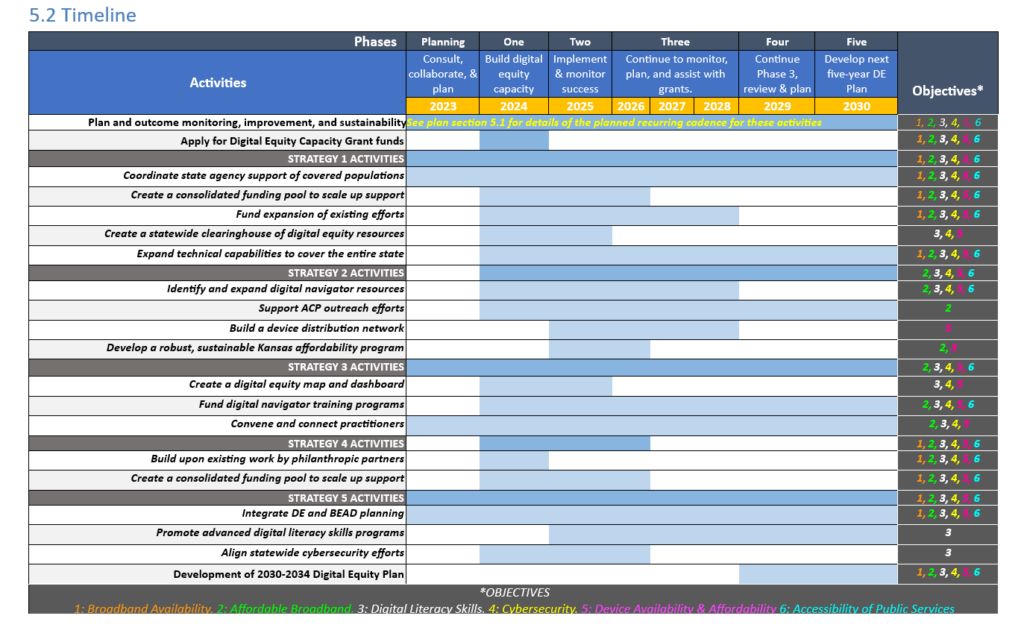
Conclusion
This is the first statewide digital equity plan for Kansas, developed with many dedicated individuals, organizations, Sovereign Tribal Nations, and state agency staff members who are committed to close the digital divide in Kansas. KOBD thanks the many people who attended Roadshow events, listening sessions, focus groups, Advisory Council meetings, tribal consultations, and other touchpoints as input was gathered from across the state.
This Digital Equity Plan shows KOBD’s investment of time, energy, and resources dedicated to close the digital equity gap for all Kansans. Standing up new activities, monitoring the success of programs, and tracking progress will be important during the first five years of implementing this plan. KOBD and its partners will adapt as necessary when changing circumstances require it. As such, this Digital Equity Plan is a living, breathing, iterative, and changing document that will need everyone’s effort for it to be successful.
Lastly, KOBD found direct conversations with individuals from the Roadshow were essential and the heart of this work. We are committed to spending time in our uniquely beautiful state with the individuals, families, farmers, and communities who are working through their connectivity issues every day. Thank you for welcoming us as we continue to travel across the state, collaborate with advocates, and work with providers to ensure broadband connectivity and digital equity for all Kansans.
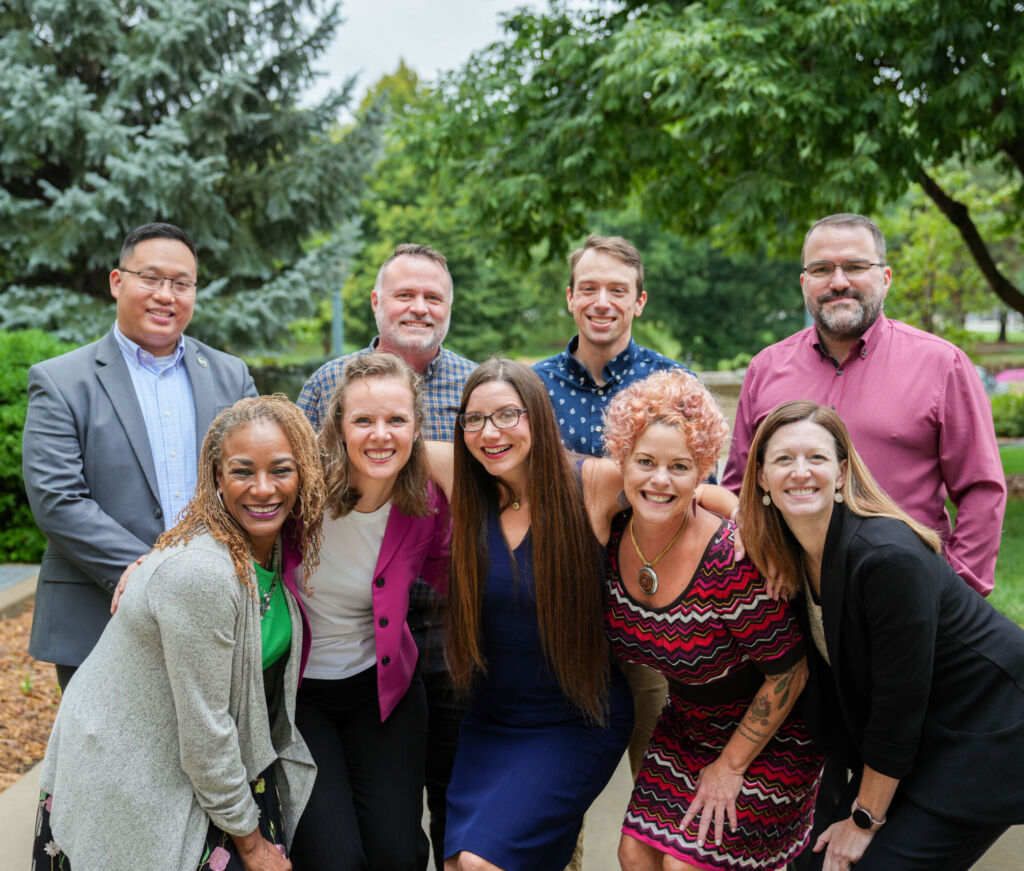
1 National Digital Inclusion Alliance. “Definitions”. https://www.digitalinclusion.org/definitions/ (Accessed 9/1/2023)
2 Kansas Department of Commerce. (February 2021). Kansas Framework for Growth. pp. 22-28.
3 Kansas Board of Regents. (August 1, 2021). Kansas Science + Technology Plan. pp. 7-8.
https://www.kansasregents.org/resources/PDF/Kansas_Science__Technology_Plan_2021_Effective.pdf (15,085 MB).
4 Kansas Apprenticeship Advisory Council. “Strategic Plan.” https://ksapprenticeship.org/wp-content/uploads/2022/09/KAC-Strategic-Goals-Approved-Sept-2022.pdf (203 KB).
5 Kansas Office of Registered Apprenticeship. “2023 Annual Review.” https://ksapprenticeship.org/wp-content/uploads/2023/11/2023-RA-Annual-Review-Final-Product.pdf (18.547 MB).
6 K12. K12-Powered Online Schools in Kansas. K12: Online Public School Programs. www.k12.com/kansas-onlineschools.
7 Kansas Board of Regents. (June 2020). Building a Future Strategic Plan for Kansas.
https://www.kansasregents.org/resources/Building_a_Future/Building_a_Future.pdf (10,553 MB).
8 U.S Department of Health and Human Services. (March 22, 2023) “Digital Access – A Super Determinant of Health”.
www.samhsa.gov/blog/digital-access-super-determinant-health#1. (Accessed July 29, 2023).
9 Kansas Department of Health and Environment Strategic Plan. (2021- 2023). https://www.kdhe.ks.gov/DocumentCenter/View/347/KDHE-Strategic-Plan-2021-to-2023-PDF (6,567 MB).
10 Kansas Department of Health and Environment Strategic Plan. (2021- 2023). https://www.kdhe.ks.gov/DocumentCenter/View/347/KDHE-Strategic-Plan-2021-to-2023-PDF (6,567 MB).
11 Governor’s Commission on Racial Equity and Justice. (2021). Social Determinants of Health –First Report.
https://governor.kansas.gov/governors-commission-on-racial-equity-and-justice/
12 Kansas Department for Aging and Disability Services. (2022 – 2025). State Plan on Aging.
13 Kansas Adjutant Generals Department TAG Strategic Plan. (2019-2024). https://www.kansastag.gov/405/TAG-Strategic-Plan-2019-2024
14 Mid-America Regional Council (MARC). (May 2023). Kansas City Regional Digital Equity Action Plan.
https://www.marc.org/document/kansas-city-regional-digital-equity-plan. (8,860 MB).
15 Kansas Department for Aging and Disability Services. (2022 – 2025). State Plan on Aging.
16 Kansas Adjutant Generals Department TAG Strategic Plan. (2019-2024). www.kansastag.gov/405/TAG-Strategic-Plan-2019-2024
17 Alternative: Percentage of statewide survey respondents from covered population who report paying affordable broadband prices
18 Alternative: Percentage of statewide survey respondents from covered population reporting confidence in digital skills and privacy/security
19 Alternative: Percentage of statewide survey respondents from covered population reporting confidence in use of online public services
20 Derived from CJARS/KOBD GIS cross-referenced data or from statewide survey response data extrapolated from stratified sample populations
21 Derived from BSL/KOBD GIS cross-referenced data based on NCES data and delineations
22 Title II of the Workforce Innovation and Opportunity Act (WIOA)—Is the responsibility of the Kansas Board of Regents, which maintain 50 locations for Adult Education.
23 Title I, III and IV of the Workforce Innovation and Opportunity Act is the responsibility of Department of Children and Family Services.
24 U.S. Census Bureau. (2021). American Community Survey 1-Year Estimates – Public Use Microdata Sample.
25 Microsoft Airband (2021). Digital Equity Map. https://aka.ms/DigitalEquityMaps
26 U.S Census Bureau. (2021). American Community Survey 1-Year Estimates – Estimates – Public Use Microdata Sample.
27 Kansas Office of Broadband Development. (May 2023). Digital Equity in Kansas – Kansas Broadband Roadshow. (Wichita State University) http://www.kansascommerce.gov/wp-content/uploads/2023/06/digital-equity-roadshow-report-06.09.23v14.pdf (1,777 MB)
28 Kansas Department of Corrections. (July 26, 2023). Population Report. www.doc.ks.gov/publications/pop/POP%2007-25-2023.pdf/view (53 MB)
29 Kansas Department of Correction. (July 26, 2023). Juvenile Population Report. www.doc.ks.gov/publications/juvenile/population
30 U.S Census Bureau. (2021). American Community Survey 1-Year Estimates – Estimates – Public Use Microdata Sample.
31 Ibid
32 U.S Census Bureau. (2021). American Community Survey 1-Year Estimates – Estimates – Public Use Microdata Sample.
33 Ibid
34 U.S Census Bureau. (2021). American Community Survey 1-Year Estimates – Estimates – Public Use Microdata Sample.
35 Ibid
36 U.S Census Bureau. (2021). American Community Survey 1-Year Estimates – Estimates – Public Use Microdata Sample.
37 Ibid
38 U.S. Census Bureau. (2021) Digital Equity Act Population Viewer. www.census.gov/data/data-tools/digital-equity-act-population.html
39 U.S Census Bureau. QuickFacts – Kansas. http://www.census.gov/quickfacts/fact/table/KS/PST045222 (accessed August 15, 2023).
40 Mid-America Regional Council. (May 2023). Kansas City Regional Digital Equity Action Plan.
http://www.marc.org/document/kansas-city-regional-digital-equity-plan. (8,860 MB)
41 U.S Census Bureau. (2021). S2801 – Types of Computers and Internet Subscriptions. American Community Survey.
https://data.census.gov/table?q=broadband&g=040XX00US20
42 U.S. Census Bureau. (2021). American Community Survey 1-Year Estimates – Public Use Microdata Sample.
43 Microsoft Airband (2021). Digital Equity Map. https://aka.ms/DigitalEquityMaps
44 University of Kansas Institute of Policy & Social Research. Kansas Statistical Abstract 2022. https://ipsr.ku.edu/ksdata/ksah/
45 U.S Census Bureau. QuickFacts – Kansas. http://www.census.gov/quickfacts/fact/table/KS/PST045222 (accessed August 15, 2023).
46 Kansas Department of Commerce, Office of Broadband Development. (May 2023). Digital Equity in Kansas – Kansas Broadband Roadshow. https://www.kansascommerce.gov/wp-content/uploads/2023/06/digital-equity-roadshow-report-06.09.23v14.pdf (1,777 MB)
47 Kansas Department of Commerce, Office of Broadband Development. (May 2023). Digital Equity in Kansas – Kansas Broadband Roadshowhttps://www.kansascommerce.gov/wp-content/uploads/2023/06/digital-equity-roadshow-report-06.09.23v14.pdf (1,777 MB)
49 United Methodist Health Ministry Fund, REACH Healthcare Foundation, and in collaboration with University of Kansas Medical Center. (May 25, 2022). Telehealth in Kansas During COVID-19: A Status Report. https://healthfund.org/a/wp-content/uploads/09-08-22-UMHMF-Cross-Study-Report.pdf (231 MB)
50 Boston Consulting Group. “A Human Approach to Closing the Digital Divide”. https://www.bcg.com/publications/2022/how-to-close-digital-divide-with-human-approach. (Accessed November 9, 2023)
51 Bergson-Shilcock, A., & Taylor, R. (2023). Closing the Digital Skill Divide. National Skills Coalition. https://nationalskillscoalition.org/wp-content/uploads/2023/02/NSC-DigitalDivide_report_Feb2023.pdf. (2,054 MB).
52 Governor Kelly Releases Kansas Broadband Digital Equity Plan for Public Comment, Oct.2, 2023
53 Benton Institute for Broadband and Society. “A Checklist for Evaluating Digital Equity Visions”.
https://www.benton.org/sites/default/files/DEV_checklist.pdf (25 KB)
The public comment period was open for thirty (30) days. The comment portal was open from October 2 through November 2 at 5 p.m. There was the option to provide comment in English, Spanish and Vietnamese.
| Comment Number | Name | Organization Represented (as applicable) | Documented Comment |
|---|---|---|---|
| 1 | Brandon Williams | Link to PDF | |
| 2 | Lazone Grays | Link to PDF | |
| 3 | Rick Usher | LIDO – Leaning Into Digital Opportunity | Link to PDF |
| 4 | KevinTaglang | Benton Institute for Broadband & Society | Link to PDF |
| 5 | Jill Kuehny | Kanokla | Link to PDF |
| 6 | Bill Chappuie | Link to PDF | |
| 7 | Ryan Flickner | Kansas Farm Bureau | Link to PDF |
| 8 | Cerise Hall | Business Speaks LLC | Link to PDF |
| 9 | Bruce Focke | Link to PDF | |
| 10 | Karisa Tashjian | Digitunity | Link to PDF |
| 11 | Karly Werner | Comcast Cable Communications | Link to PDF |
| 12 | Robert Gibson | Health Forward Foundation | Link to PDF |
| 13 | Anna Brugmann | Rebuild Local News | Link to PDF |
| 14 | Iris O’Donnell Bellisario | Lead for America | Link to PDF |
| 15 | Jennifer Ellis | healthfund.org | Link to PDF |
| 16 | Aaron Deacon | KC Digital Drive | Link to PDF |
| 17 | Carlee Parker | IdeaTek | Link to PDF |
| 18 | Leslie Scott | KC Digital Drive | Link to PDF |
| 19 | Terri English Yancy | Essential Families Midwest Inc | Link to PDF |
The Digital Equity Strategic Plan outlines specific strategies and objectives to achieve its goals, including ensuring digital skills training, affordable service plans and broadband-ready devices are aligned as top priorities. This plan also emphasizes the transformative power of technology, which can positively impact various areas such as healthcare, education and civic engagement.
The Digital Equity Strategic Plan was open to public comment and went through several rounds of curing with our federal funding partners. You can view original documents related to that process here.
To report suspected fraud, waste or abuse contact the U.S. Department of Commerce Office of Inspector General Office of Investigations.
For more information, please visit the Office of Inspector General with the Department of Commerce here.
The Broadband Equity Access and Deployment 5–Year Action Plan along with Volume 1 and Volume 2 will identify served, unserved, and underserved locations across the state. The 5-Year Action Plan addresses the “what” KOBD will be doing, and Volume 1 and Volume 2 address the “how” it will happen and how KOBD will address the digital divide. The National Telecommunications Information Administration requirements for the 5 -Year Action Plan (component 11a) required that we look at more than infrastructure to address the digital divide. This holistic approach to broadband will continue to push Kansas forward.
Our broadband objectives are as follows:

“My administration is committed to ensuring every Kansan, regardless of their zip code, has access to fast and
Governor Laura Kelly
reliable internet connectivity, bringing additional economic growth, educational opportunities, and telehealth
services. This funding advances our progress toward being a top 10 state for broadband access by 2030.”